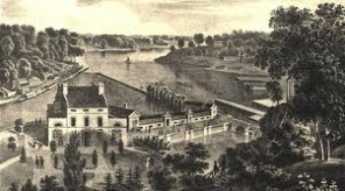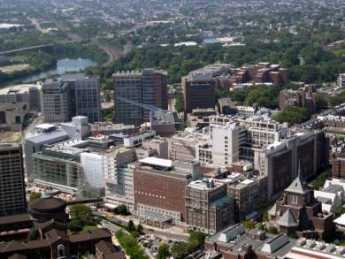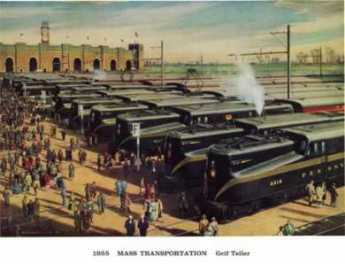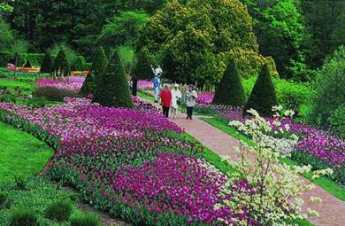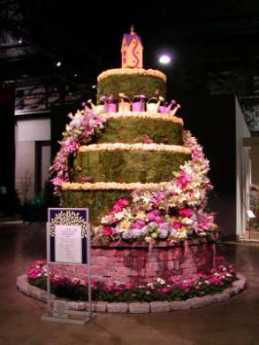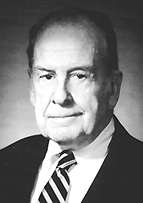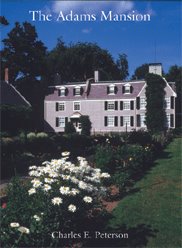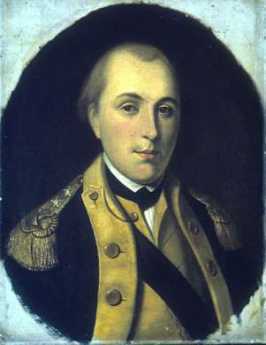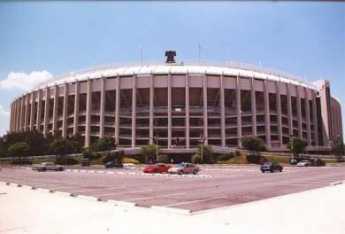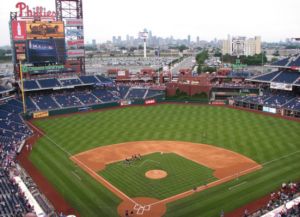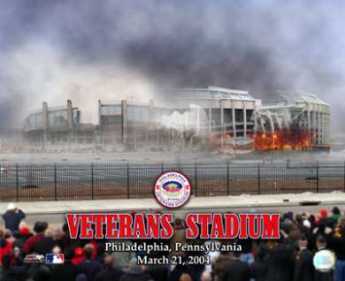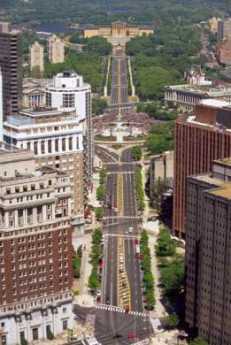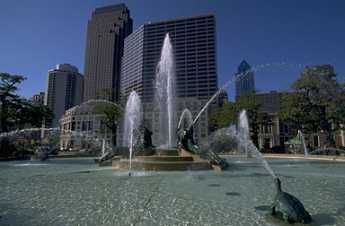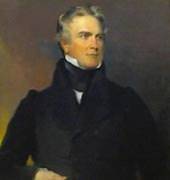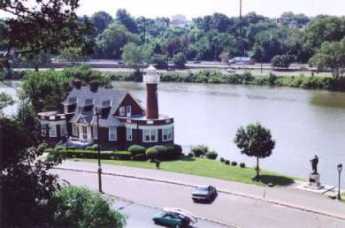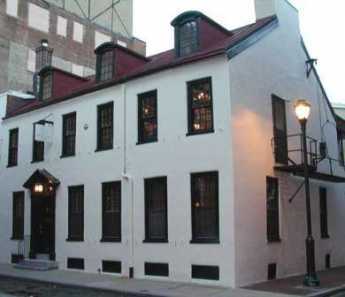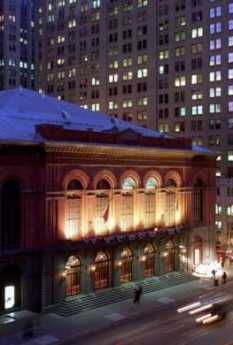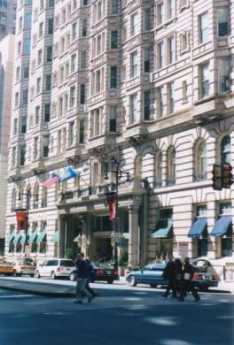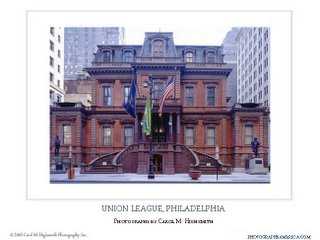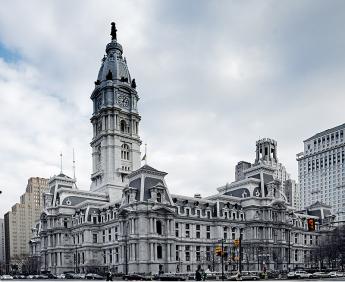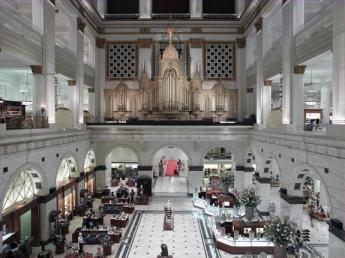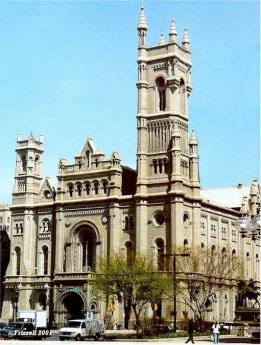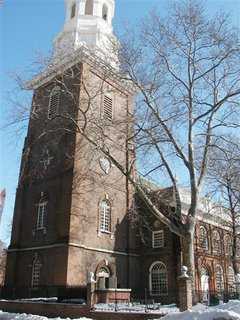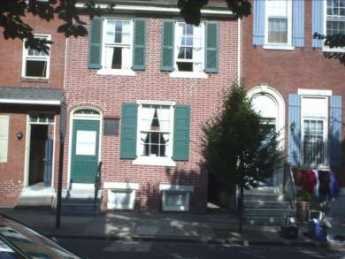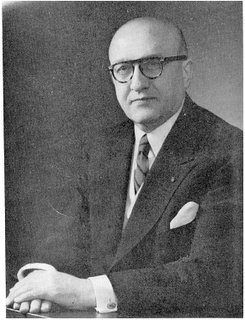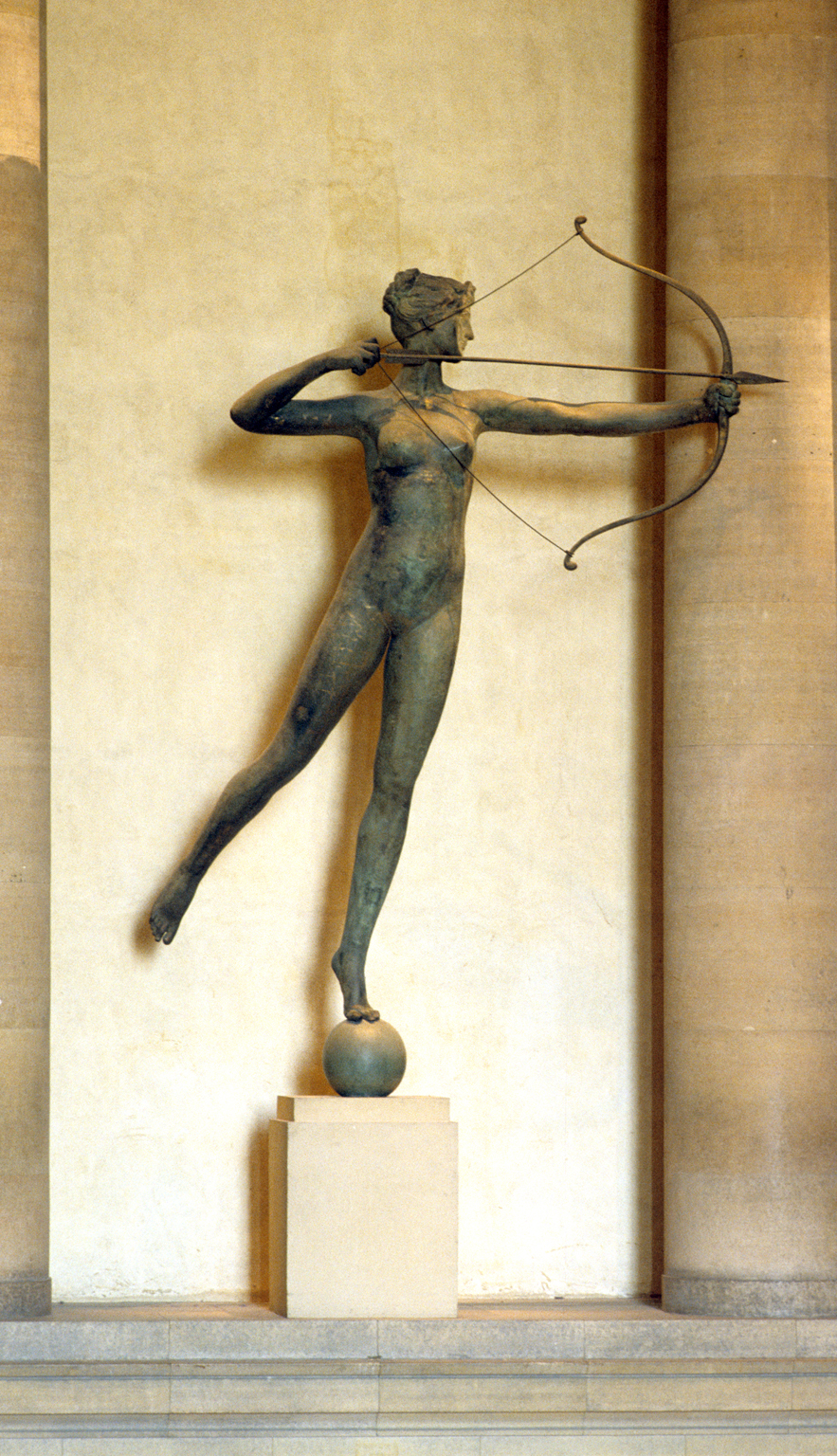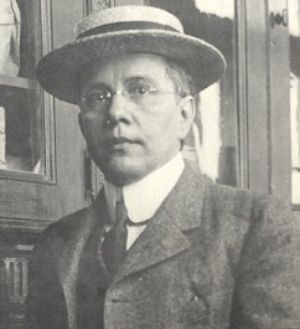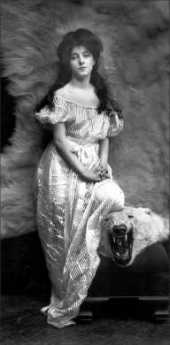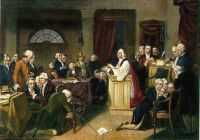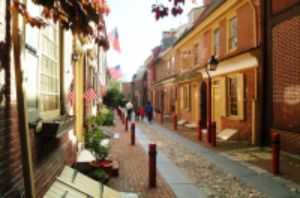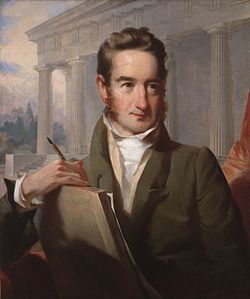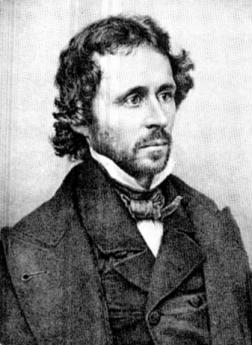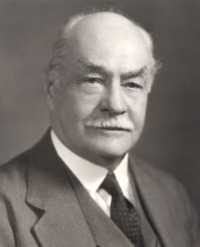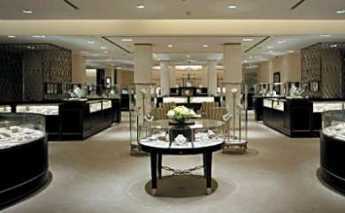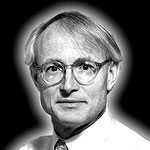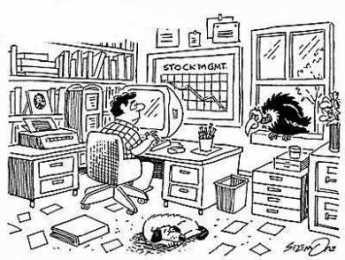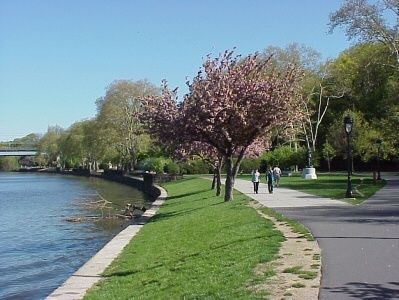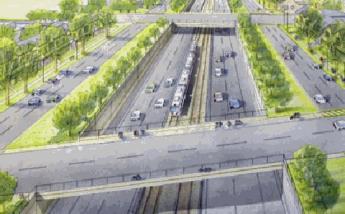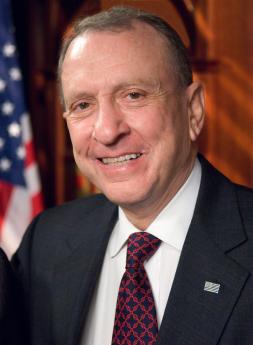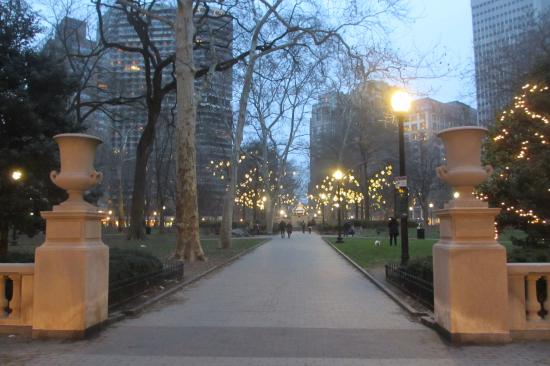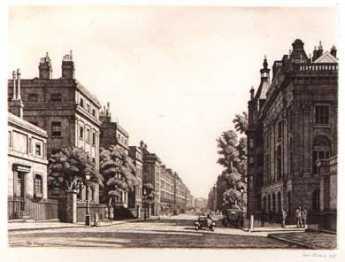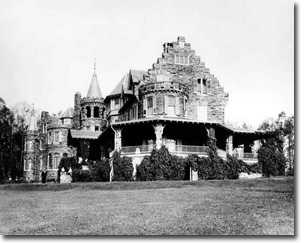2 Volumes
Regional Overview: The Sights of the City, Loosely Defined
Philadelphia,defined here as the Quaker region of three formerly Quaker states, contains an astonishing number of interesting places to visit. Three centuries of history leave their marks everywhere. Begin by understanding that William Penn was the largest private landholder in history, and he owned all of it.
History: Philadelphia and the Quaker Colonies
Philadelphia and the Quaker Colonies
Particular Sights to See:Center City
Taxi drivers tell tourists that Center City is a "shining city on a hill". During the Industrial Era, the city almost urbanized out to the county line, and then retreated. Right now, the urban center is surrounded by a semi-deserted ring of former factories.
West Fairmount Park
Fairmount Park is considerably larger on the west bank of the Schuylkill than on the east, and the points of interest are somewhat more diluted by woods and pasture. Partly, that is a consequence of being the site of the 1876 Centennial Exhibition , and partly that urban growth had not encroached so much into the farmland at the time the park was created. On the west bank at the time of the Revolution, there were still 300-400 acre farms, whereas the east bank farms had been cut up into gentleman's
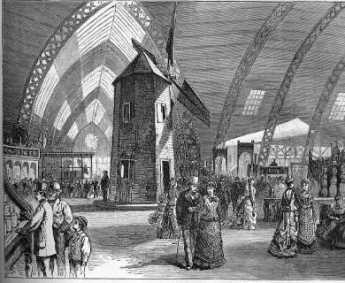
|
| Centennial Exhibition |
estates. The Schuylkill takes two 90-degree turns within the Park limits, leaving a point of high land on either side of the river. On the east side, the East Park reservoir is at the apex, and on the west side, the dominant point is Belmont Mansion. For a while, there was a restaurant at Belmont, but at the moment it's a pity but little advantage is taken of a very scenic view. Two judges once lived in the mansion, William Peters, and his nephew Richard Peters. William was a Tory and had to flee to England. Richard made a better guess and as a rebel, therefore could live on in scenic splendor.
For orientation, the West Park mansions extend in an arc from The Solitude in the south to Chamonix in the north. For the moment limiting our list to houses present when the Park was created, there is Sweetbrier, The Pig-Eye Cottage, Belmont, Ridgeland, Greenland, and the Lilacs. The last three houses belonged to three well-known Philadelphia families, Garrett, J.B. Lippincott, and Walnut, who established themselves in 19th Century commerce rather than 18th Century politics. Sweetbrier was one of those centers of French Philadelphia, when Samuel Breck continued his father's close relationship developed as the fiscal representative of French Forces in America, entertaining LaFayette and other such friends of the new Republic. The Pig-eye cottage is used by the Park administration, and closely resembles the Caleb Pusey house, but otherwise has no remarkable history. Solitude, on the other hand, really was the retreat for John, then Richard, then Granville. John Penn entertained George Washington here while he was presiding over the Constitutional Convention.
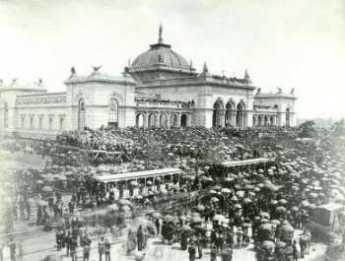
|
| fair |
Fairmount Park is notable for some buildings which are unfortunately no longer there, and some other buildings that were transplanted there. The East Park is a historical monument, while the West Park is more a house museum. Governor Mifflin's house is gone from the Falls area, Powelton is gone, and Lansdowne the estate where the Proprietor John Penn was seized by rebel soldiers. His family was later paid less than a penny an acre for the 21 million acres of Pennsylvania land they clearly owned. Sedgley is also gone, and all of these places have a place in history. On the other hand, it is well to remember that all of the industrial slums along the river were cleared away to be replaced by the charm of Boat House Row.
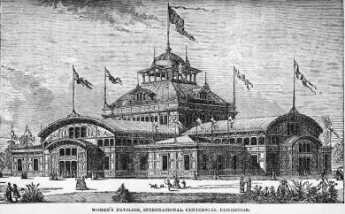
|
| Exhibition |
It keeps being repeated that Fairmount Park is the largest urban park in America, but the fact is it is bigger than the city can afford to maintain, just as a monument to the colonial style of life. It was a grand place to have a World's Fair in 1876, and Memorial Hall remains, along with the Japanese pavilion, a truly priceless reproduction of Japan under the Shogun. Fairmount Park has the first Zoo in America, still a place of note in zoological circles, and many ballparks, summer music halls, and other modern recreational attractions. It contains Cedar Grove, a splendid Quaker homestead in Welsh style, transported from its original location in Frankford. The Letitia Street House was too fine an example of 17th Century urban architecture to lose, so it was moved to the Park from Letitia Street, approximately 2nd and Market Streets. William Penn lived for a while on Letitia Street, named after his daughter, but it is not entirely clear who lived in this particular little house. There doesn't seem to be anything you can do about people calling it the William Penn House.
Fairmount Park is the largest urban park. It doesn't have roley coasters, but we don't miss them, and it doesn't have Mickey Mouse, at least so far. There is absolutely nothing like it anywhere. Anyway even if there were, Philadelphians wouldn't notice.
Fair Mount
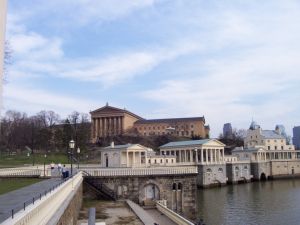 |
| THE FAIRE MOUNT |
Although the Art Museum now dominates the end of the Benjamin Franklin Parkway, the earlier focus of the acropolis once called Fair Mount is just down the hill behind it, in the old Grecian complex of the Philadelphia waterworks. When the Schuylkill was dammed at that point, the effect was to calm the rapids, drown the falls at Midvale Avenue upstream, and turn this portion of the river into a placid fresh-water lake. Fairmont Park was then created upstream in an effort (originally stimulated by the College of Physicians of Philadelphia) to reduce pollution of Philadelphia's water supply going into the pumps at the Waterworks, by replacing, with parkland, the wards, and industrial slums at the terminus of the canal bringing anthracite from upstate. The result was the creation of an ideal place for public boating and skating.
The transformation of this area can be seen in retrospect as an impressive civic response to economic upheaval. The War of 1812 (by cutting off ocean access to bituminous via the Chesapeake) had first forced Philadelphia to use anthracite hard coal, and the discovery of anthracite's superiority in making steel caused a continuing reliance on it and the canals
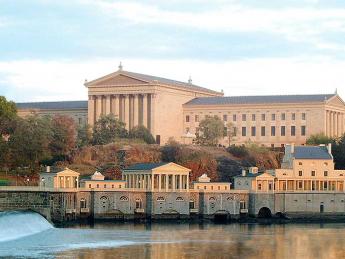
|
| Philadelphia's Water Works |
that brought it here. By 1850, the Philadelphia and Reading Railroad made the canals obsolete and created this splendid opportunity for urban renewal. The waterfalls had created a natural boundary between industry oriented to upstate coal and other industry oriented to oil and commerce coming up Delaware. It is a great pity that the lower section of the Schuylkill, once so famously beautiful, has never stimulated the same vision and imagination in response to the eventual decline of the industrialization which defaced it.
To return to Boathouse Row, a large azalea garden starts the Park, and then the East River Driver winds along the attractively landscaped riverbank. Just beyond the azalea garden, the first of ten Victorian-style boathouses starts the home of the Schuylkill Navy, an association of rowing clubs which are now a century and a half in residence there. When the Schuylkill auto expressway was created on the other side of the river, someone had the bright idea of decorating the rowing houses with lights along their edges in the manner used for Christmas decorations in South Philadelphia, especially on Smedley and Colorado Streets. Ever since the entrance to Philadelphia from the West has become one of its most arresting beauties.
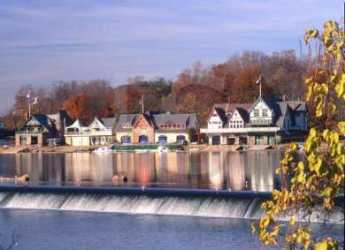 |
| BOATHOUSE ROW |
Add a few cherry blossom trees in the spring, and you have quite a memorable centerpiece. Rowing sometimes called crewing, or sculling, is a central focus of Philadelphia society, and is curiously not something in which the city can claim to be first or the oldest. As you might expect, "regatta" is a word invented in Venice five hundred years ago, there are records of rowing races as far back as 400 BC, and New York -- ye Gods! -- had the first American boating club. The Philadelphia Schuylkill Navy was formed as an association of rowing clubs in 1858, and the oldest member, the Bachelor's Barge, was only formed in 1856. The development was largely spontaneous and is said to have been briskly stimulated by a beer garden nearby, run by a former Philadelphia sheriff. About the same time, the British became crazy about the sport, having the Henley Races as the most famous regatta in the world, and both the Australians and the Bostonians occasionally have the largest, most expensive, most widely advertised regattas. Foo. Philadelphia has the Schuylkill Navy, and it is central to our existence.
There are a couple of things which are unique about rowing. In the first place, it is hard to think of a way to cheat. You can hire engineers to redesign the shape and size of your boat, but engineering really doesn't make a lot of difference once the basic development of oarlocks and movable seats was perfected. A good boat can cost as much as $30,000, but that is large because all boats approach the limit of speed. If you have heavier or stronger oarsmen, it doesn't make that much difference. What matters is coordination, and in the longer boats, teamwork. Pull up with your shoulders, push with your legs, don't start with your buttocks, the art of rowing involves your whole body. The greatest champion of all time, Edward "Ned" Hanlan,
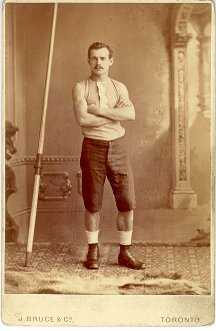 |
| EDWARD HANLAN |
only weighed 155 pounds. Not only was he world champion from 1876 to 1884, he was undefeated in any race during the last four years. True, he was born in Toronto, and eventually he was thrown out of polite Philadelphia racing for deliberately ramming another boat, but those are private Philadelphia comments, not something you want to talk too much about. The whole secret of rowing is to manage the fact that the boat travels farther between strokes than while the oars are in the water; if you row too fast, you actually slow the boat. There are two other Philadelphia names associated with the Schuylkill Navy. One is Thomas Eakins, the great American painter, one of whose most famous pictures is that of Max Schmitt in a Single Scull (on the Schuylkill). The other name is Kelly.
John B. Kelly of Philadelphia won two Olympic gold medals in 1920 and did it within one hour. He won a Third Olympic gold medal in 1924. But when he tried to race in the Henley Regatta, he was declared ineligible to row, because he had worked with his hands (summer work as a bricklayer), and thus could not really be called a gentleman. Anyone who has ever heard Irishmen talk about Englishmen can imagine the reaction this caused in the Kelly family. The resentment took the form of pushing his son, Jack, into racing, and in 1947 John B. Kelly, Jr. won the Diamond Sculls at Henley. Meanwhile, the father vindicated himself in other ways. The firm of Kelly for Brickwork was an enormous financial success, right up there next to Matthew H. McCloskey and John McShain, the political builders of the Pentagon and numerous other government buildings. John B. Kelly unsuccessfully ran for Mayor of Philadelphia in 1935 during the 75-year period when Philadelphia Mayors were always Republicans, but for decades was in the much more powerful position of head of the local Democratic party. The Republicans at that time would meet for lunch at the Union League, and so John Kelly reserved a lunch table at the Bellevue Hotel, next door, where he could be seen holding court every day.
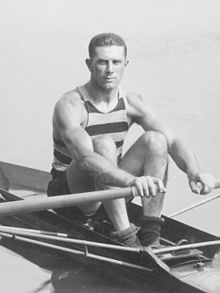
|
| John B Kelly |
The result was not entirely favorable for the Bellevue; more than one wedding reception was rescheduled to some other hotel in order to avoid the Democrat taint. But you always knew where you could find Kelly at lunch, and it was fun to watch the various minions come forward to the table, almost as if they were in chains, to pay homage which involved provoking loud laughter from the great man with a salacious joke. The rowing clubs are mostly big barns with old boats high up on the walls, and silver cups and wooden memorial plaques lower down. They have lockers and showers, but no dining rooms, except at catered in the evening for parties. For a century, no women came there, but now almost half of the rowers are female. Membership is not difficult to obtain, although you have to be good to get on the club teams, and the dues are not expensive. If you show promise, you are expected to spend most of your waking hours working at it. Jack Kelly was famous for rowing three hours every morning, going to lunch, and then coming back for a couple of hours of more rowing. That doesn't leave much time in your life for anything else, so the friendships developed among active club members are very strong, just like the horsemen over at the City Troop. They sort of life in the past a little, with many anecdotes about a skull that broke apart and sank in the midst of a race, or a race that was lost because of too much recreation the night before. The lingo has to do with the fine points. A race can be between "eights" or "fours", or doubles, or singles. It can have a coxswain, or not, and be coxed or unboxed. When a pair of rowers have two oars apiece, it is the normal arrangement. A much more difficult boat to control has two rowers, with one oar apiece. Like Hercules or Achilles, stories are told of Hanlan, great Hanlan, who sometimes would win a one-mile race by eleven lengths. Or who would get so far ahead of his competitors that he would lie down in the boat and wait for another boat to catch up -- and then race ahead to beat him. This sort of person can be a little hard to take, and it is privately muttered that Hanlan was sent off to Australia, where people do that sort of thing more commonly.
Widener, Stotesbury, and Trumbauer
Gerry McFadden devoted most of his short life to researching the history of Philadelphia clubs, but illness kept him from publishing much of it. Walton van Winkle has apparently taken up the role of club historian for the city, and much that survives to be known comes to us from them. For which we all ought to be grateful.
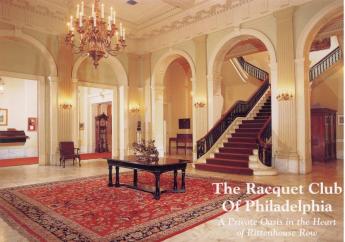
|
| Racquet Club |
The Racquet Club was once located at 9th and Walnut, just three blocks from the debtors prison at 6th and Walnut where the game of squash racquets is said to have originated. In 1906 it was decided to build a new club at 16th and Chancellor Streets; that did come to pass, largely because of three members. Henry Widener had taken a small inherited fortune and blown it up into a large personal fortune by monopolizing the trolley business in town. Edward T. Stotesbury, a much younger man, had ascended to the Presidency of Drexel and Company, in affiliation with J. P. Morgan. Both of these tycoons had built awesome mansions in the suburbs, one called Whitemarsh for where it was located, and the other called Lynnewood, on the grounds of what is now a huge apartment complex at the north end of Broad Street.Horace Trumbauer was the architect for both of these palaces, bringing together two men of considerably different age and personality. The conviction grew that Philadelphia needed a really first-class athletic club, and in 1906 it got built. Architect Trumbauer saw the whole design as related to the terrifying weight of the swimming pool full of water, and the indoor tennis courts, faced with thick slabs of slate. Builders who understand these things are impressed with the concept of a central tower to carry the internal weight of the building. The whole internal guts of the place are supported by steel girders of the type used to build bridges, ultimately resting on holes in the bedrock drilled 26 feet deep. If someone comes our way with an atom bomb, this is a good place to be a member.
The Racquet Club has one of the four or five Court Tennis areas in America, an interesting thing to look at, although the rules of the actual game are as baffling as those of cricket.
Another notable sight is the men's dressing room, wood-paneled and luxurious enough to be the scene of several movies. The shower heads, in particular, dump hot water on you like a Turkish Bath.
The Racquet club was always primarily for young men and tended to be a little raucous. It used to be said that almost anybody could be admitted -- you can take that for what it is probably worth -- but then the young members were carefully observed for their behavior, particularly in whom they married. If they seemed to be the right sort, they could then be invited into the Rittenhouse or the Philadelphia Club.
Market Street, East (2)
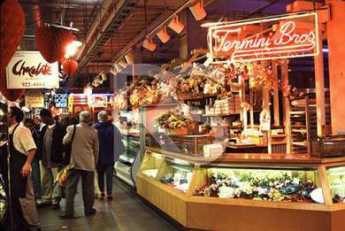
|
| The Reading Terminal Market |
We are about to look at a remarkable a fourteen-block stretch of street, with several unifying historical themes, but there is one notable feature which stands by itself. The PSFS building is now the site of a luxury hotel, but it once housed the Philadelphia Savings Fund Society, the oldest savings bank in the country, having been founded in 1816. Setting aside the place of this the institution in American finance, and passing quickly by the deplorable end of it with swashbuckling corsairs in three-piece suits, 1929 the building itself remains so remarkable that the hotel still displays the PSFS sign on its top. The imagination of the architects was so advanced that a building constructed seventy-five years ago looks as though it might have been completed yesterday. The Smithsonian Institution conducts annual five-day tours of Chicago to look at a skyscraper architecture, but hardly anything on that tour compares with the PSFS building. From time to time, someone digs up old newspaper clippings from the 1930s to show how the PSFS was ridiculed for its odd-looking the building, but anyhow this is certainly one example of how the Avante the guard got it right.
At the far Eastern end of Market Street, right in the middle of the street once stood a head house, which in this case was called the market terminal building
. In those days, street markets were mostly a line of sheds and carts down the middle of a wide street, but usually there was a substantial masonry building at the head of the market, where money was counted and more easily guarded. An example of a restored ahead house can today be found at Second and Pine, although that market ("Newmarket") was less for groceries than for upscale shops. The market on Market Street started at the river and worked West with the advancing city limits, making it understandable that buildings which lined that broad avenue gradually converted to shops, and then stores. The grandest of the department stores on Market Street was, of course, John Wanamaker's, all the way to City Hall, built on the site of Pennsylvania Railroad's freight terminal (the passenger terminal was on the West side of City Hall). In the late Nineteenth Century, the Pennsylvania Railroad and the Reading Railroads terminated at this point, so rail traffic flowing east merged with ocean and river traffic flowing west. Well into the Twentieth Century, a dozen major department stores and hundreds of specialty stores lined the street, with trolley cars, buses, and subway traffic taking over for horse-drawn drainage. The the pinnacle of this process was the corner of Eighth and Market, where four department stores stood, one on each corner, and underneath them three subway systems intersected. The Reading terminal market is Philadelphia's last remnant of this almost medieval shopping concept, although the Italian street markets of South Philadelphia display a more authentic chaos. Street markets, followed by shops, overwhelmed by department stores showed a regular succession up Market Street, and when commerce disappeared, it all turned into a wide avenue from City Hall to River, leaving few colonial traces.
The history of Market Street is the history of the Reading Terminal Market. Farmers and local artisans thronged to sell their wares in sheds put up in the middle of the wide street, traditionally called "shambles" after the similar areas in York, England. Gradually, elegant stores were built on the street, and upscale competitors began to be uncomfortable with the mess and disorder of the shambles down the center of the street. By 1859 the power structure had changed, and the upscale merchants on the sidewalks got a law passed, forbidding shambles. After the expected uproar, the farmers and other shambles merchants got organized, and built a Farmers Market on the North side of 12th and Market Relative peace and commercial tranquility then prevailed until the Reading Railroad employed power politics and the right of eminent domain to displace the Farmer's Marketplace with a downtown railroad terminal that was an architectural marvel for its time, with the farmers displaced to the rear in the Reading Terminal Market, opening in 1893. Bassett's, the ice cream maker, is the only merchant continuously in business there since it opened, but several other vendors are nearly as old. The farmers market persisted in that form for a century until the City built a convention center next door. As a result, the quaint old farmers market became a tourist attraction, with over 90,000 visitors a week. That's fine if you are selling sandwiches and souvenirs, but it crowds out meat and produces and thereby creates a problem. If the tourist attraction gets too popular, it drives out everything which made it a tourist attraction; so rules had to be made and enforced, limiting the number of restaurants, but encouraging Pennsylvania Dutch farmers. Competition and innovation are the lifeblood of commercial real estate, but they are always noisy processes. The history of the street is the history of clamor and jostling, eventually dying out to the point where everyone is regretful and nostalgic for a revival of clamor.
Market Street, East (3)
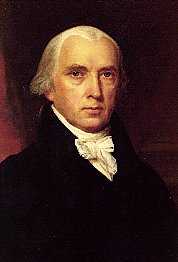
|
| James Madison |
But wait. At Ninth and Market Philadelphia had once built the White House or at least a mansion for the President of the United States. Secret deals between James Madison and Alexander Hamilton had agreed to move the nation's capital city to Virginia in return for nationalizing the states' Revolutionary War debts, although the circumstance which made it acceptable to the public had been the Yellow Fever epidemic. After that happened, no amount of logic or log-rolling was going to keep the government in this city. Philadelphia vainly built a very elaborate mansion for the President, but President Washington never occupied it, and it was converted to housing the University of Pennsylvania. That University eventually tore it down and replaced it with two somewhat more suitable buildings, meanwhile using the Walnut Street Theater and the Musical Fund Hall, at Ninth and Walnut and Ninth and Locust Streets respectively, for commencement exercises and the like. No one can be completely certain, but it is felt by many that 9th and Market was the general area where Benjamin Franklin had flown his famous kite. This definitely later was the site of Leary's second-hand bookstall, which had the remarkable history that it was once run by a former Philadelphia mayor. Ninth and Market Street is now the site of a Post Office on one corner and a vacant lot on the other. But let the imagination wander a little, and see Ben Franklin, The White House, the University of Pennsylvania, and a former mayor tending a bookstall.
There is a restoration of the house, the very house, where Thomas Jefferson wrote the Declaration of Independence at the corner of 7th and Market. Although hidden among the hulks of former department stores, some idea of the former elegance of the area is given by the description of stir raised by that rich young Virginian arriving in Philadelphia for the Continental Congress with his fancy carriage, team of horses, and several footmen. All of that colonial splendor has just about vanished in a sea of Victorian commercial architecture, which has in turn become merely a quaint relic. Over the front door of what was Lit's Department Store is still to be seen the mystifying motto, "Hats trimmed free of charge.", and today almost no one knows what that meant. At Sixth and Market, however, look out. The National Park Service brings colonial history crashing across Market Street, with tourists, a vista of Independence Hall, and lots of federal money. Dare we mention pork barrels? The whole subject of Independence National Park is so huge we must return to it several times, but just glance as you go through from City Hall to Penn's Landing.
Notice in particular the corner of Sixth and Market, where the real White House really stood. Robert Morris once had a mansion there, which Benedict Arnold occupied for a while after he was in charge of recovering Philadelphia from the British occupation, and subsequently both Washington and then John Adams lived there, as Presidents. Unfortunately, a fire took it away around 1830, and the remains were covered with trashy commercial buildings for decades, until the Park Service built a big public restroom there, now torn down. The current public furor about this site is truly remarkable, and the ample amounts of federal money our Senator has been able to obtain from the Appropriations committee on which he sits is probably a big factor in attracting interest. The main focus of dispute has to do with the fact that President Washington brought eight black slaves with him, and although he hastened to replace them with white indentured servants whose civil rights were probably no greater than slaves, the black slaves undoubtedly had to have lived somewhere. A search is on for the real, the true, the authentic slave quarters, as a suitable place for a public monument to their service to the country. The Park Service has a long reputation for defending scholarly standards, and its reluctance to accept archaeologically evidence of the slave quarters has brought down on their heads the furious response of the black community and the politicians seeking their favor. None of these latter groups can see any sense to quibbles about the precise location of Washington's outbuildings, just put up the monument, but for a while, it looked as though the scholars were determined to go down with their flags flying.
Several blocks further East, Market street comes to the brow of what was a cliff overlooking the Delaware, where the earliest settlers lived in temporary caves while they built houses. At the corner of Front and Market, from 1702 to 1883, stood the London Coffee House; during the Continental Congress, it was a place of high intrigue. The trolley lines once made a loop at the bottom of the hill at the river. Prior to that time, horse trolleys had to stop at the top of the hill at Front Street because the hill was too steep for them. At the lower level on the waterfront, there was a terminus for the ferry from New Jersey, bringing commuters, shoppers and farm produce from the Garden State. In time, a subway was built down Market Street, taking a sharp turn at the brow of the hill and heading off toward Frankford and the far northeastern parts of the city. The conjunction of the trolleys, the subway, and the ferries brought throngs of shoppers, mixing with other crowds emerging from three subways at 8th Street, still others from two train stations at 13th Street, and trolleys or buses at every one of the fourteen cross streets. This fourteen block strip was surely a great place to sell dry goods. But today, with the ferry terminal gone and the trolleys vanished, it is mainly a question whether the foot of the hill at the Delaware River is destined to become a museum or an amusement park.
Free Quaker Meetinghouse
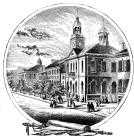
|
| Independence Hall |
Until this year, there was a Beautiful Mall stretching north from the State House (Independence Hall) to the approaches of the Benjamin Franklin Bridge. Concealing an enormous parking garage underneath it, the surface looked like a several-block lawn lined with flowering trees in the spring, framing the beautiful Eighteenth Century building (just as the mall in Washington leads up to the Washington Monument.)
Stretching from Independence Hall east to the Delaware River is another mall filled with historical buildings like Carpenters Hall , the First Bank(Girard's) and Second Bank (Biddle's), the Old and the New Custom houses, the American Philosophical Society, and others. The eastern mall was the property of the State of Pennsylvania when it was created, but it soon seemed more economical to the frugal rural legislature to turn it over to the federally funded National Park Service, joining the mall stretching northward. Well, somebody got another ton of federal money appropriated, and now we are filling the north mall with buildings which largely hide Independence Hall from the passersby. With just a few more Congressional earmarks, the imposing beauty of the mall will be submerged, but it hasn't quite reached that point yet. There is a perfectly enormous New Visitors Center, containing a couple of auditoriums and a big bookstore. Mostly the concept seems to be to provide a place to get out of the rain if you are an out of town visitor, provide public bathrooms, and a place to get a hot dog. At least the visitors center is red brick, and arched, with white woodwork. At the far northern end is an overwhelming stark granite block of a building, which will open July 4, 2003. It is a Constitution Center, claimed to be an interactive museum, and we shall see what we shall see. The looming monolith overwhelms and blocks the view to Independence Hall, and it better be good, when the insides get finished.
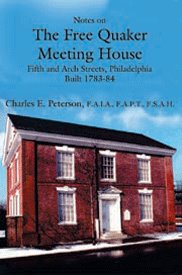
|
| Free Quaker Meeting |
If Independence Hall, which after all is a block long, is overwhelmed by the new constructions, the Free Quaker Meeting is totally hidden. This perfectly charming Eighteenths Century Quaker meetinghouse is just across Fifth Street from Benjamin Franklin's Grave, and just across Arch Street from the Constitution thing, completely in its shadow. Charles E. Peterson designed the restoration of the building, which had been added to and detracted from, over the years, but you can be sure its interior is now both beautiful and authentic. Before you go in, notice the inscription on the plaque under the northern eaves:
By General Subscription for the FREE QUAKERS. Erected in the Year of OUR LORD 1783 and of the EMPIRE 8.
The Quakers who built this building seem to have thought they were part of a new empire, but that implies an emperor, and of course, one was never created. Three years after the dedication of this building the Constitutional Convention met in the same Independence Hall, and our national form of government was somewhat strengthened from the Articles of Confederation also written here. Benjamin Franklin had a hand in both documents, but the first one was mainly composed by John Dickinson, and the second one by James Madison. If you go into the Free Quaker building, it seems to be a single large room with an interior balcony, and a couple of small staircases in the back leading down to what would presumably be restrooms. As a matter of fact, the Park Service extended the basement to include kitchen and dining room, and several offices for themselves which are a surprise if you are allowed to go down to see them.
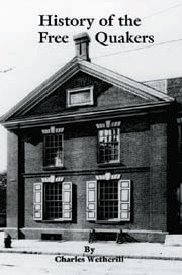
|
| History of Free Quakers |
Charlie Peterson wrote a book about the restoration, but the main book about the spiritual history of this group was written by Charles Wetherill. Quakers, as everyone ought to know, are pacifists. The American Revolution put a number of them in a quandary because they agreed that Great Britain was injuring their rights by denying them a representative in the Parliament which ruled them but resorting to violence was another matter entirely. Eventually, a group did break away from the main Quaker church to fight for independence. They were prompt "readout of the meeting", the equivalent of being excommunicated, not allowed to worship in the regular meeting houses they had helped finance or to be buried in the church graveyards. Samuel Wetherill was one of the leaders of this group, just as his descendants are the most active today in the surviving historical society. Samuel created quite a furor, demanding to use the Orthodox meeting house and burial grounds. He was, in his own view, just as much a Quaker as the others since no doctrine is absolutely fixed in that religion, and was freely entitled to speak his mind to persuade others of the rightness of his sincere positions. The main body of Quakers would have none of it, and the Free Quakers were firmly expelled, forced to hold a public subscription and build their own meeting house. Wetherill of course personally knew every one of the members who expelled him, and there may be some truth to his loud, pointed and unchallenged contention that the true division was not between pacifists and fighters, but between Tories and advocates of Independence. Whatever the truth of these accusations, it does seem in retrospect that the split was fairly divided between wealthy established merchants, and small shopkeepers and artisans. Quite a few now-famous names appear on the rolls of the Free Quakers, like Timothy Matlack the actual Scribe of the Declaration of Independence document, Biddles, Lippincott, John Bartram,Crispins, Kembles, Trippes, and Wetherills. When the meeting had dwindled down in 1830 to two lone parishioners, one was a Wetherill, and the other was Betsy Ross, herself.
A comment is submitted by a reader:
I think your description of the Free Quakers oversimplifies their origins. It is true that Samuel Wetherill was disowned by Friends for his military activities. However, other Free Quaker leaders were bounced -- often years before the Revolution -- for other reasons. Timothy Matlack, for not paying his debts. Betsy Ross, for an improper marriage. Christopher Marshall, for counterfeiting. I haven't traced everyone listed as a member in the (1907?) Stackhouse history of the Free Quakers. But I did search in Quaker records for perhaps a dozen and found no records that people with those names had ever been Quakers. I think it would be more accurate to say of the Free Quakers that the Revolution drew together people of many different types and that when some of those people had things in common -- such as Quaker background -- they united around those things. (Posted by Mark E. Dixon )
Benjamin Franklin Parkway (2)
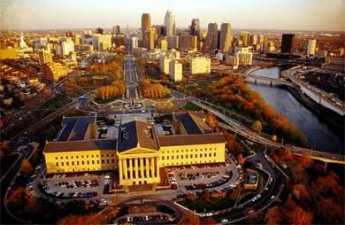
|
| Art Museum |
There are a number of residential relics along the Parkway, but in general the idea seems to have been to put governmental buildings there, in a sort of French-like celebration of governmental glory. There is the Youth Study Center, the Department of Education administration building, the Boy Scouts of America, the Cathedral of St. Peter and St. Paul, and of course the tower of City Hall at one end and the Parthenon-like Art Museum at the other. But this is Philadelphia, and certain small touches of the town are tucked among the European grandee design.
For example, WFLN (now WWFM) the original FM classical music station, had its studio tucked in a little building just behind the Cathedral. Ralph Collier would interview authors and city visitors there during the lunch hour, in a studio that was little more than a closet, while someone else changed records in a room downstairs. Somebody from New York once said that Ralph didn't seem to know how good he really was, which is a way New Yorkers like to talk. Ralph was, the just about the only interviewer who had actually read your book before the interview. In 1997, WFLN was sold for forty million dollars, which ought to impress even a New Yorker.
Logan Circle is bigger than it looks, primarily because the windows are set 100 feet high. This came about after the anti-catholic riots of the Civil War era, which made it advisable to put stained glass higher than most people can throw rocks. There is usually a cardinal in residence at this cathedral, and Cardinal Bevilacqua the much-respected lawyer-cardinal is now just retiring in favor of an incoming occupant from St. Louis. Cardinal Krol was famous in the past for his opposition to Pope John's Vatican Constitution, which he refused to allow to be translated into English. Before that, was Cardinal Dougherty, who is remembered for being considerably overweight. Cardinals are addressed as Your Eminence, and Cardinal Dougherty was (very privately) referred to as You're Immense. He was perhaps most famous for the Legion of Decency , an effort to make motion pictures more socially acceptable. The story is told of a 12-year-old girl who stood up and told the Cardinal that she didn't agree with him, she liked movies. The next day, her father, the most powerful Catholic banker in Philadelphia, had to go to the Cardinal and humble himself to make amends.
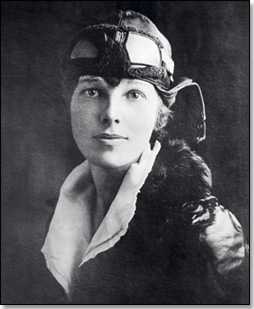
|
| Amelia Earhart |
Franklin Institute was originally on 7th Street, where the Atwater Kent Museum of Philadelphia History is now located. Much of the money to build it came from a $5000 bequest from Franklin himself, which was intended to demonstrate the power of compound interest over a period of time. It is part science museum, part memorial to Philadelphia's most famous citizen. It has a Planetarium, locomotive, a passenger airplane, Amelia Earhart's plane, a huge replica of a human heart, and thousands of working demonstrations of electrical phenomena. Ben Franklin's huge statue sits in a grand marble rotunda, where socialites occasionally hold receptions and weddings. But between the two extremes is the most interesting combination of museum and memorial -- a series of demonstrations of Franklin's most important scientific discoveries, utilizing the same instruments he used. Just a little effort at understanding these exhibits will convince any educated adult that Franklin was truly a genius.
Almost next door to the Franklin Institute is its more venerable neighbor, the Academy of Natural Sciences. The Academy is an offshoot of the American Philosophical Society, itself (originally founded by Franklin) and has a distinguished history of discovery and research of its own making, not merely a display of the work of others. Most school children will recognize the famous display of dinosaurs, including the First Dinosaur ever unearthed intact (in Haddonfield).
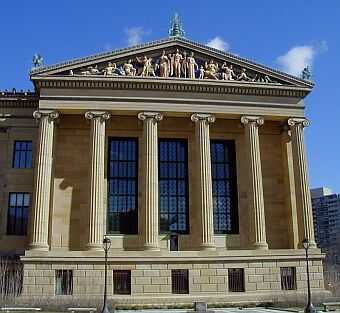
|
| Art Museum |
The Art Museum was intended to inspire awe, and it does. The builders ran out of money before the decorative friezes could be completed, but that even enhances its resemblance to the Parthenon, where the friezes were blown off in various wars. It's a little hard to know how to respond to the criticism that the building overwhelms its contents. Perhaps it is true that the creaking floorboards in Madrid's Prado Museum show off the treasures on its walls, but there is also little doubt that Spain (or Boston) would replace the floors if it could afford to. Although the City of Philadelphia has a little trouble finding the money to maintain and guard the Museum, the masonry is ultra-solid, it's very big, and will endure for ages to come. The collections slowly grow, benefaction by benefaction. The traveling exhibits are clearly the center of Philadelphia culture. And there, at the top of the stairs without any clothes on, is Diana of fame and fable. Her perfectly straight back is the true essence of the famously beautiful Philadelphia woman, like Fannie Kemble, Rebecca Gratz, Evelyn Nesbitt,Cornelia Otis Skinner, Grace Kelly, and Katherine Hepburn.
Albert C. Barnes, M.D.
A private investor has the general goal of accumulating enough wealth so, come what may, there will be a little left when he dies. If he has dependents or heirs, he needs somewhat more. Either way, he is not planning for perpetuity or thinking in astronomical time periods. Albert C. Barnes (1872-1951) had to switch his investment goals, in the 1920s, from investing for a comfortable retirement to investing for a perpetual art foundation. Perpetual.
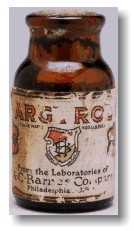
|
| A bottle of Argyrol |
Having graduated from medical school (University of Pennsylvania) in 1902, and then writing a doctoral thesis in chemistry and pharmacology at the Universities of Berlin and Heidelberg, Barnes invented a patent medicine that quickly made him rich. Argyrol was a mildly effective silver-containing antiseptic with the unfortunate tendency to turn its users permanently slate-gray. The advent of antibiotics has since made Argyrol almost sound like quackery, but it was effective enough at the time to require factories in America, Europe, and Australia, and Barnes became immensely rich with it. The American Medical Association strongly disapproves of physicians who patent remedies, so Barnes was never held in high regard by his colleagues; but it could well be argued that he had as much training as a chemist as a physician, and spent his entire professional life as a chemist, manufacturer, and investor.
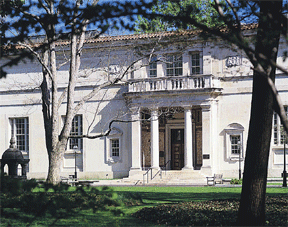
|
| The Barnes Gallery |
Barnes was eccentric, all right, but on Wall Street, the saying goes, "What everyone knows, isn't worth knowing." Guided by that principle, in 1929 he sold his company at the very peak of market euphoria, getting out of common stocks at the top of the market. It is small wonder that he soon instructed his Foundation to invest its endowment entirely in bonds. During the 1930s, commodities were extremely cheap because no one had any money. Barnes, of course, had a potful of money and bought hundreds, even thousands, of artworks very cheaply. He also bought 137 acres of Chester County, PA, real estate, and a 12-acre arboretum in Merion Township on the Main Line. Although he is famous for acquiring hundreds of French Impressionist paintings with the advice of Gertrude Stein and her brother Leo, he also bought great quantities of Greek and Roman classical art, African art, and the art of the Pennsylvania German community. He picked up a notable collection of metallic art objects. Most of these "losers" are down in the basement because he had so many Renoirs, Matisse, and Picasso (some of them may be worth $200 million apiece) that the upstairs galleries were pretty well stuffed with them. Viewed from the perspective of an investor with a goal of perpetuity, of course, the things in the basement just happen to be temporarily out of fashion, just like those bonds in the portfolio.
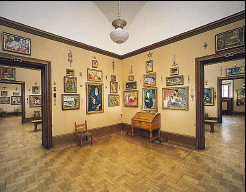
|
| A view inside the Barnes gallery |
Since the Foundation is currently strapped for ready cash, Judge Stanley Ott of the Montgomery County Orphans Court is now being urged to allow the Foundation to break Barnes' will in some way or other. Move the museum to downtown Philadelphia where it can attract more paying visitors. Sell some of that land. Sell some of those paintings in the cellar. Fire some of those employees. But all of these suggestions are short-term solutions, which may injure the long term. Everybody has an idea of what Barnes the rich eccentric would have done if he were alive to do it, but I suspect he would have rejected the whole lot. Barnes the shrewd investor would have taken the most expensive painting off the wall, and sold it to the highest bidder. Buy low, sell high, and the niceties of non-profit professionals are damned. Barnes wasn't in love with one single painting, or one particular school of painterly interpretation, he was in love with Art.
Investment theory has improved in the past fifty years; there have even been some Nobel prizes awarded for new insights. But it still isn't possible to put an investment portfolio on autopilot for perpetuity. Every museum, university, and the foundation has the same problem, with the result that the landscape is littered with the bones of perpetual organizations destroyed by following a fixed formula. With the singular success that Barnes displayed, it isn't surprising that he went a little too far with instructing his successor trustees in what to invest in. Never sell the paintings or the real estate, avoid the common stock, were ideas that worked brilliantly, and may even work most of the time. But sooner or later, the institution will be endangered by following them too literally. Somebody has to have some flexibility. But there is something else that is inevitable, too. Sooner or later, whether it takes fifty years or five hundred years, sooner or later someone will be given the responsibility and the necessary flexibility -- but will try to run off with the boodle, for himself. The balance between necessary prudence and necessary flexibility is impossible to maintain forever, and the Judge will surely have a hard time deciding what Barnes would have decided.
American Philosophical Society
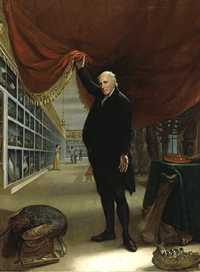
|
|
Charles Wilson Peale (1741-1827)
The Artist in His Museum 1822, Oil on canvas (The Joseph Harrison Jr. Collection) Courtesy of the Pennsylvania Academy of Fine Arts. |
all of the red brick buildings on Independence Square look as though they were part of Independence Hall, but there is one exception. The building facing Fifth Street is Philosophical Hall, one of the four buildings of the American Philosophical Society. Right now, Philosophical Hall is used as a museum. It could be called the first museum in America, but not the oldest, because it had interruptions and different proprietorships. Charles Wilson Peale started his museum of curiosities there and then moved it to the second floor of Independence Hall, where he painted the famous portrait of himself holding up the curtain. In recent years, Philosophical Hall has again become a museum, holding treasures and curiosities belonging to the Philosophical Society itself. The docent is pleased to alternate between calling it America's new oldest museum, and America's oldest new museum. And, yes, the newell post has an Amity Button.

|
|
American Philosophical Society |
Patents were established by the Constitution when it was a piece of parchment lying on a table fifty feet away from here, and the early patent office required the submission of a working model of every application for patent. After a while, that got to be a lot of working models lying around, and many of the more interesting ones are on display in the museum. Like the model of Fitch's first steamboat or the gadget Jefferson used, to make simultaneous copies of documents he was writing. That's right near the Gilbert Stuart copy of Washington's portrait, and von Neumann's first algorithm to be stored in his stored program machine, or computer, and Neil Armstrong's speech on the moon, concerning one step for mankind and all. It's a splendid museum, full of the real stuff, in a handsome Georgian building with sparkling immaculate marble staircases.
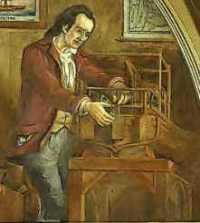
|
|
John Fitch received a US Patent for the Steamboat August 26, 1791 |
In the Eighteenth Century, Natural Philosophy was what we now call science. That's why PhDs get a degree of Doctor of Philosophy when they study chemistry and physics. The idea for forming a scientific society in America apparently originated with John Bartram. As so often happens, the originator couldn't quite get it established and had to call on Ben Franklin that impression of publicity, to get it off the ground. To be fair about it, Franklin was probably the more distinguished scientist of the two. To be even more fair about it, the organization struggled a bit until Thomas Jefferson (that's the one who was President of the United States) gave it a real publicity shove. During the depths of the 1930s depression, one of the members left it several million dollars with the stipulation that the investments should focus on common stock. Since buying stock in 1935 was widely regarded as about the stupidest thing an investor could do, this little episode reinforced a strong impression that membership in the APS is given to people who are very smart, not merely famous. The four buildings, the many fellowships, and the big endowment were largely made possible by this contraries investment decision.
There are eight hundred members, of whom 93 have won Nobel Prizes. Over the years, two hundred members have been awarded Nobel Prizes, but you must remember that the organization existed for 150 years before there was such a prize. Several U.S. Supreme Court justices are members and lots and lots of people who are famous. The docent comments that they look pretty much like everyone else. There's a rumor that Bill Gates turned down the offer of membership, so now we will just see. He's young enough to have several decades' opportunity to reconsider an offer, although the APS might just be old enough to lack interest in any second chances.
Charles Dickens Doesn't Like Our Nice Penitentiary
In 1842, Philadelphia's Eastern Penitentiary was innovative and unique. It was an important tourist stop, especially for foreign visitors, and Charles Dickens naturally had to pay it a visit when he toured America in 1842. He didn't like it, and he said so, as follows :
In the outskirts, stands a great prison, called the Eastern Penitentiary: conducted on a plan peculiar to the state of Pennsylvania. The system here is rigid, strict, and hopeless solitary confinement. I believe it, in its effects, to be cruel and wrong.
In its intention, I am well convinced that it is kind, humane, and meant for reformation; but I am persuaded that those who devised this system of Prison Discipline, and those benevolent gentlemen who carry it into execution, do not know what it is that they are doing. I believe that very few men are capable of estimating the immense amount of torture and agony which this dreadful punishment, prolonged for years, inflicts upon the sufferers; and in guessing at it myself, and in reasoning from what I have seen written upon their faces, and what to my certain knowledge they feel within, I am only the more convinced that there is a depth of terrible endurance in it which none but the sufferers themselves can fathom, and which no man has a right to inflict upon his fellow-creature. I hold this slow and daily tampering with the mysteries of the brain, to be immeasurably worse than any torture of the body: and because its ghastly signs and tokens are not so palpable to the eye and sense of touch as scars upon the flesh; because its wounds are not upon the surface, and it extorts few cries that human ears can hear; therefore I the more denounce it, as a secret punishment which slumbering humanity is not roused up to stay. I hesitated once, debating with myself, whether, if I had the power of saying 'Yes' or 'No,' I would allow it to be tried in certain cases, where the terms of imprisonment were short; but now, I solemnly declare, that with no rewards or honours could I walk a happy man beneath the open sky by day, or lie me down upon my bed at night, with the consciousness that one human creature, for any length of time, no matter what, lay suffering this unknown punishment in his silent cell, and I the cause, or I consenting to it in the least degree.
I was accompanied to this prison by two gentlemen officially connected with its management, and passed the day in going from cell to cell, and talking with the inmates. Every facility was afforded me, that the utmost courtesy could suggest. Nothing was concealed or hidden from my view, and every piece of information that I sought, was openly and frankly given. The perfect order of the building cannot be praised too highly, and of the excellent motives of all who are immediately concerned in the administration of the system, there can be no kind of question.
Between the body of the prison and the outer wall, there is a spacious garden. Entering it, by a wicket in the massive gate, we pursued the path before us to its other termination and passed into a large chamber, from which seven long passages radiate. On either side of each, is a long, long row of low cell doors, with a certain number over every one. Above, a gallery of cells like those below, except that they have no narrow yard attached (as those in the ground tier have), and are somewhat smaller. The possession of two of these, is supposed to compensate for the absence of so much air and exercise as can be had in the dull strip attached to each of the others, in an hour's time every day; and therefore every prisoner in this upper story has two cells, adjoining and communicating with, each other.
Standing at the central point, and looking down these dreary passages, the dull repose, and quiet that prevails is awful. Occasionally, there is a drowsy sound from some lone weaver's shuttle, or shoemaker's last, but it is stifled by the thick walls and heavy dungeon-door, and only serves to make the general stillness more profound. Over the head and face of every prisoner who comes into this melancholy house, a black hood is drawn; and in this dark shroud, an emblem of the curtain dropped between him and the living world, he is led to the cell from which he never again comes forth, until his whole term of imprisonment has expired. He never hears of wife and children; home or friends; the life or death of any single creature. He sees the prison-officers, but with that exception, he never looks upon a human countenance or hears a human voice. He is a man buried alive; to be dug out in the slow round of years, and in the meantime dead to everything but torturing anxieties and horrible despair.
His name, and crime, and term of suffering are unknown, even to the officer who delivers him his daily food. There is a number over his cell-door, and in a book of which the governor of the prison has one copy, and the moral instructor another: this is the index of his history. Beyond these pages the prison has no record of his existence: and though he lives to be in the same cell ten weary years, he has no means of knowing, down to the very last hour, in which part of the building it is situated; what kind of men there are about him; whether in the long winter nights there are living people near, or he is in some lonely corner of the great jail, with walls, and passages, and iron doors between him and the nearest sharer in its solitary horrors.
Every cell has double doors: the outer one of sturdy oak, the other of grated iron, wherein there is a trap through which his food is handed. He has a Bible, and a slate and pencil, and, under certain restrictions, has sometimes other books, provided for the purpose, and pen and ink and paper. His razor, plate, and can, and basin, hang upon the wall or shine upon the little shelf. Freshwater is laid on in every cell, and he can draw it at his pleasure. During the day, his bedstead turns up against the wall and leaves more space for him to work in. His loom, or bench, or wheel, is there; and there he labors, sleeps and wakes, and counts the seasons as they change, and grows old.
The first man I saw, was seated at his loom, at work. He had been there six years and was to remain, I think, three more. He had been convicted as a receiver of stolen goods, but even after his long imprisonment, denied his guilt, and said he had been hardly dealt by. It was his second offense.
He stopped his work when we went in, took off his spectacles, and answered freely to everything that was said to him, but always with a strange kind of pause first, and in a low, thoughtful voice. He wore a paper hat of his own making and was pleased to have it noticed and commanded. He had very ingeniously manufactured a sort of Dutch clock from some disregarded odds and ends, and his vinegar-bottle served for the pendulum. Seeing me interested in this contrivance, he looked up at it with a great deal of pride, and said that he had been thinking of improving it and that he hoped the hammer and a little piece of broken glass beside it 'would play music before long.' He had extracted some colors from the yarn with which he worked, and painted a few poor figures on the wall. One, of a female, over the door, he called 'The Lady of the Lake.'
He smiled as I looked at these contrivances to while away the time; but when I looked from them to him, I saw that his lip trembled, and could have counted the beating of his heart. I forget how it came about, but some allusion was made to his having a wife. He shook his head at the word, turned aside, and covered his face with his hands.
' But you are resigned now!' said one of the gentlemen after a short pause, during which he had resumed his former manner. He answered with a sigh that seemed quite reckless in its hopelessness, 'Oh yes, oh yes! I am resigned to it.' 'And are a better man, you think?' 'Well, I hope so: I'm sure I hope I may be.' 'And time goes pretty quickly?' 'Time is very long gentlemen, within these four walls!'
He gazed about him - Heaven only knows how wearily! - as he said these words; and in the act of doing so, fell into a strange stare as if he had forgotten something. A moment afterward he sighed heavily, put on his spectacles, and went about his work again.
In another cell, there was a German, sentenced to five years' imprisonment for larceny, two of which had just expired. With colors procured in the same manner, he had painted every inch of the walls and ceiling quite beautifully. He had laid out the few feet of ground, behind, with exquisite neatness, and had made a little bed in the center, that looked, by-the-bye, like a grave. The taste and ingenuity he had displayed in everything were most extraordinary; and yet a more dejected, heart-broken, wretched creature, it would be difficult to imagine. I never saw such a picture of forlorn affliction and distress of mind. My heart bled for him; and when the tears ran down his cheeks, and he took one of the visitors aside, to ask, with his trembling hands nervously clutching at his coat to detain him, whether there was no hope of his dismal sentence being commuted, the spectacle was really too painful to witness. I never saw or heard of any kind of misery that impressed me more than the wretchedness of this man.
In a third cell, was a tall, strong black, a burglar, working at his proper trade of making screws and the like. His time was nearly out. He was not only a very dexterous thief, but was notorious for his boldness and hardihood, and for the number of his previous convictions. He entertained us with a long account of his achievements, which he narrated with such infinite relish, that he actually seemed to lick his lips as he told us racy anecdotes of stolen plate, and of old ladies whom he had watched as they sat at windows in silver spectacles (he had plainly had an eye to their metal even from the other side of the street) and had afterward robbed. This fellow, upon the slightest encouragement, would have mingled with his professional recollections the most detestable cant; but I am very much mistaken if he could have surpassed the unmitigated hypocrisy with which he declared that he blessed the day on which he came into that prison and that he never would commit another robbery as long as he lived.
There was one man who was allowed, as an indulgence, to keep rabbits. His room having rather a close smell in consequence, they called to him at the door to come out into the passage. He complied of course and stood to shake his haggard face in the unwonted sunlight of the great window, looking as wan and unearthly as if he had been summoned from the grave. He had a white rabbit in his breast; and when the little creature, getting down upon the ground, stole back into the cell, and he, being dismissed, crept timidly after it, I thought it would have been very hard to say in what respect the man was the nobler animal of the two.
There was an English thief, who had been there but a few days out of seven years: a villainous, low-browed, thin-lipped fellow, with a white face; who had as yet no relish for visitors, and who, but for the additional penalty, would have gladly stabbed me with his shoemaker's knife. There was another German who had entered the jail but yesterday, and who started from his bed when we looked in, and pleaded, in his broken English, very hard for work. There was a poet, who after doing two days' work in every four-and-twenty hours, one for himself and one for the prison, wrote verses about ships (he was by trade a mariner), and 'the maddening wine-cup,' and his friends at home. There were very many of them. Some reddened at the sight of visitors, and some turned very pale. Some two or three had prisoner nurses with them, for they were very sick; and one, a fat old negro whose leg had been taken off within the jail, had for his attendant a classical scholar and an accomplished surgeon, himself a prisoner likewise. Sitting upon the stairs, engaged in some slight work, was a pretty colored boy. 'Is there no refuge for young criminals in Philadelphia, then?' said I. 'Yes, but only for white children.' Noble aristocracy in crime.
There was a sailor who had been there upwards of eleven years, and who in a few months' time would be free. Eleven years of solitary confinement!
' I am very glad to hear your time is nearly out.' What does he say? Nothing. Why does he stare at his hands, and pick the flesh upon his fingers, and raise his eyes for an instant, every now and then, to those bare walls which have seen his head turn grey? It is a way he has sometimes.
Does he never look men in the face, and does he always pluck at those hands of his, as though he were bent on parting skin and bone? It is his humor: nothing more.
It is his humor too, to say that he does not look forward to going out; that he is not glad the time is drawing near; that he did look forward to it once, but that was very long ago; that he has lost all care for everything. It is his humor to be a helpless, crushed, and broken man. And, Heaven be his witness that he has his humor thoroughly gratified!
There were three young women in adjoining cells, all convicted at the same time of a conspiracy to rob their prosecutor. In the silence and solitude of their lives, they had grown to be quite beautiful. Their looks were very sad and might have moved the sternest visitor to tears, but not to that kind of sorrow which the contemplation of the men awakens. One was a young girl; not twenty, as I recollect; whose snow-white room was hung with the work of some former prisoner, and upon whose downcast face the sun in all its splendor shone down through the high chink in the wall, where one narrow strip of bright blue sky was visible. She was very penitent and quiet; had come to be resigned, she said (and I believe her); and had a mind at peace. 'In a word, you are happy here?' said one of my companions. She struggled - she did struggle very hard - to answer, Yes; but raising her eyes, and meeting that glimpse of freedom overhead, she burst into tears, and said, 'She tried to be; she uttered no complaint, but it was natural that she should sometimes long to go out of that one cell: she could not help THAT,' she sobbed, poor thing!
I went from cell to cell that day; and every face I saw, or word I heard, or incident I noted, is present to my mind in all its painfulness. But let me pass them by, for one, more pleasant, a glance of a prison on the same plan which I afterward saw at Pittsburgh.
When I had gone over that, in the same manner, I asked the governor if he had any person in his charge who was shortly going out. He had one, he said, whose time was up the next day; but he had only been a prisoner two years.
Two years! I looked back through two years of my own life - out of jail, prosperous, happy, surrounded by blessings, comforts, good fortune - and thought how wide a gap it was, and how long those two years passed in solitary captivity would have been. I have the face of this man, who was going to be released the next day, before me now. It is almost more memorable in its happiness than the other faces in their misery. How easy and how natural it was for him to say that the system was a good one; and that the time went 'pretty quick - considering;' and that when a man once felt that he had offended the law, and must satisfy it, 'he got along, somehow:' and so forth!
'What did he call you back to say to you, in that strange flutter?' I asked of my conductor when he had locked the door and joined me in the passage.
'Oh! That he was afraid the soles of his boots were not fit for walking, as they were a good deal worn when he came in; and that he would thank me very much to have them mended, ready.'
Those boots had been taken off his feet, and put away with the rest of his clothes, two years before!
I took that opportunity of inquiring how they conducted themselves immediately before going out; adding that I presumed they trembled very much.
'Well, it's not so much a trembling,' was the answer - 'though they do quiver - as a complete derangement of the nervous system. They can't sign their names to the book; sometimes can't even hold the pen; look about 'em without appearing to know why, or where they are; and sometimes get up and sit down again, twenty times in a minute. This is when they're in the office, where they are taken with the hood on, as they were brought in. When they get outside the gate, they stop, and look first one way and then the other; not knowing which to take. Sometimes they stagger as if they were drunk, and sometimes are forced to lean against the fence, they're so bad:- but they clear off in course of time.'
As I walked among these solitary cells, and looked at the faces of the men within them, I tried to picture to myself the thoughts and feelings natural to their condition. I imagined the hood just taken off, and the scene of their captivity disclosed to them in all its dismal monotony.
At first, the man is stunned. His confinement is a hideous vision, and his old life a reality. He throws himself upon his bed and lies there abandoned to despair. By degrees, the insupportable solitude and barrenness of the place rouse him from this stupor, and when the trap in his grated door is opened, he humbly begs and prays for work. 'Give me some work to do, or I shall go raving mad!'
He has it; and by fits and starts applies himself to labour; but every now and then there comes upon him a burning sense of the years that must be wasted in that stone coffin, and an agony so piercing in the recollection of those who are hidden from his view and knowledge, that he starts from his seat and striding up and down the narrow room with both hands clasped on his uplifted head, hears spirits tempting him to beat his brains out on the wall.
Again he falls upon his bed, and lies there, moaning. Suddenly he starts up, wondering whether any other man is near; whether there is another cell like that on either side of him: and listens keenly.
There is no sound, but other prisoners may be near for all that. He remembers to have heard once, when he little thought of coming here himself, that the cells were so constructed that the prisoners could not hear each other, though the officers could hear them.
Where is the nearest man - upon the right, or on the left? or is there one in both directions? Where is he sitting now - with his face to the light? or is he walking to and fro? How is he dressed? Has he been here long? Is he much worn away? Is he very white and specter-like? Does HE think of his neighbor too?
Scarcely venturing to breathe, and listening while he thinks, he conjures up a figure with his back towards him and imagines it moving about in this next cell. He has no idea of the face, but he is certain of the dark form of a stooping man. In the cell upon the other side, he puts another figure, whose face is hidden from him also. Day after day, and often when he wakes up in the middle of the night, he thinks of these two men until he is almost distracted. He never changes them. There they are always as he first imagined them - an old man on the right; a younger man upon the left - whose hidden features torture him to death, and have a mystery that makes him tremble.
The weary days pass on with solemn pace, like mourners at a funeral; and slowly he begins to feel that the white walls of the cell have something dreadful in them: that their color is horrible: that their smooth surface chills his blood: that there is one hateful corner which torments him. Every morning when he wakes, he hides his head beneath the coverlet and shudders to see the ghastly ceiling looking down upon him. The blessed light of day itself peeps in, an ugly phantom face, through the unchangeable crevice which is his prison window.
By slow but sure degrees, the terrors of that hateful corner swell until they beset him at all times; invade his rest, make his dreams hideous, and his nights dreadful. At first, he took a strange dislike to it; feeling as though it gave birth in his brain to something of corresponding shape, which ought not to be there, and racked his head with pains. Then he began to fear it, then to dream of it, and of men whispering its name and pointing to it. Then he could not bear to look at it, nor yet to turn his back upon it. Now, it is every night the lurking-place of a ghost: a shadow:- a silent something, horrible to see, but whether bird, or beast, or muffled human shape, he cannot tell.
When he is in his cell by day, he fears the little yard without. When he is in the yard, he dreads to re-enter the cell. When night comes, there stands the phantom in the corner. If he has the courage to stand in its place, and drive it out (he had once: being desperate), it broods upon his bed. In the twilight, and always at the same hour, a voice calls to him by name; as the darkness thickens, his Loom begins to live; and even that, his comfort, is a hideous figure, watching him till daybreak.
Again, by slow degrees, these horrible fancies depart from him one by one: returning sometimes, unexpectedly, but at longer intervals, and in less alarming shapes. He has talked upon religious matters with the gentleman who visits him, and has read his Bible, and has written a prayer upon his slate, and hung it up as a kind of protection, and an assurance of Heavenly companionship. He dreams now, sometimes, of his children or his wife, but is sure that they are dead, or have deserted him. He is easily moved to tears; is gentle, submissive, and broken-spirited. Occasionally, the old agony comes back: a very little thing will revive it; even a familiar sound, or the scent of summer flowers in the air; but it does not last long, now: for the world without, has come to be the vision, and this solitary life, the sad reality.
If his term of imprisonment be short - I mean comparatively, for short it cannot be - the last half year is almost worse than all; for then he thinks the prison will take fire and he be burnt in the ruins, or that he is doomed to die within the walls, or that he will be detained on some false charge and sentenced for another term: or that something, no matter what, must happen to prevent his going at large. And this is natural and impossible to be reasoned against, because, after his long separation from human life, and his great suffering, any event will appear to him more probable in the contemplation, than the being restored to liberty and his fellow-creatures.
If his period of confinement has been very long, the prospect of release bewilders and confuses him. His broken heart may flutter for a moment, when he thinks of the world outside, and what it might have been to him in all those lonely years, but that is all. The cell-door has been closed too long on all its hopes and cares. Better to have hanged him in the beginning than bring him to this pass, and send him forth to mingle with his kind, who are his kind no more.
On the haggard face of every man among these prisoners, the same expression sat. I know not what to liken it to. It had something of that strained attention which we see upon the faces of the blind and deaf, mingled with a kind of horror, as though they had all been secretly terrified. In every little chamber that I entered, and at every grate through which I looked, I seemed to see the same appalling countenance. It lives in my memory, with the fascination of a remarkable picture. Parade before my eyes, a hundred men, with one among the newly released from this solitary suffering, and I would point him out.
The faces of the women, as I have said, it humanizes and refines. Whether this is because of their better nature, which is elicited in solitude, or because of their being gentler creatures, of greater patience and longer suffering, I do not know; but so it is. That the punishment is nevertheless, to my thinking, fully as cruel and as wrong in their case, as in that of the men, I need scarcely add.
My firm conviction is that, independent of the mental anguish it occasions - an anguish so acute and so tremendous, that all images of it must fall far short of the reality - it wears the mind into a morbid state, which renders it unfit for the rough contact and busy action of the world. It is my fixed opinion that those who have undergone this punishment MUST pass into society again morally unhealthy and diseased. There are many instances on record, of men who have chosen, or have been condemned, to lives of perfect solitude, but I scarcely remember one, even among sages of strong and vigorous intellect, where its effect has not become apparent, in some disordered train of thought, or some gloomy hallucination. What monstrous phantoms, bred of despondency and doubt, and born and reared in solitude, have stalked upon the earth, making creation ugly, and darkening the face of Heaven!
Suicides are rare among these prisoners: are almost, indeed, unknown. But no argument in favor of the system can reasonably be deduced from this circumstance, although it is very often urged. All men who have made diseases of the mind their study, know perfectly well that such extreme depression and despair as will change the whole character, and beat down all its powers of elasticity and self-resistance, may be at work within a man, and yet stop short of self-destruction. This is a common case.
That it makes the senses dull, and by degrees impairs the bodily faculties, I am quite sure. I remarked to those who were with me in this very establishment at Philadelphia, that the criminals who had been there long, were deaf. They, who were in the habit of seeing these men constantly, were perfectly amazed at the idea, which they regarded as groundless and fanciful. And yet the very first prisoner to whom they appealed - one of their own selection confirmed my impression (which was unknown to him) instantly, and said, with a genuine air it was impossible to doubt, that he couldn't think how it happened, but he WAS growing very dull of hearing.
That it is a singularly unequal punishment, and affects the worst man least, there is no doubt. In its superior efficiency as a means of reformation, compared with that other code of regulations which allows the prisoners to work in a company without communicating together, I have not the smallest faith. All the instances of reformation that were mentioned to me were of a kind that might have been - and I have no doubt whatever, in my own mind, would have been - equally well brought about by the Silent System. With regard to such men as the negro burglar and the English thief, even the most enthusiastic have scarcely any hope of their conversion.
It seems to me that the objection that nothing wholesome or good has ever had its growth in such unnatural solitude, and that even a dog or any of the more intelligent among beasts, would pine, and mope, and rust away, beneath its influence, would be in itself a sufficient argument against this system. But when we recollect, in addition, how very cruel and severe it is, and that a solitary life is always liable to peculiar and distinct objections of a most deplorable nature, which have arisen here, and call to mind, moreover, that the choice is not between this system and a bad or ill-considered one, but between it and another which has worked well, and is, in its whole design and practice, excellent; there is surely more than sufficient reason for abandoning a mode of punishment attended by so little hope or promise, and fraught, beyond dispute, with such a host of evils.
As a relief to its contemplation, I will close this chapter with a curious story arising out of the same theme, which was related to me, on the occasion of this visit, by some of the gentlemen concerned.
At one of the periodical meetings of the inspectors of this prison, a working man of Philadelphia presented himself before the Board, and earnestly requested to be placed in solitary confinement. On being asked what motive could possibly prompt him to make this strange demand, he answered that he had an irresistible propensity to get drunk; that he was constantly indulging it, to his great misery and ruin; that he had no power of resistance; that he wished to be put beyond the reach of temptation; and that he could think of no better way than this. It was pointed out to him, in reply, that the prison was for criminals who had been tried and sentenced by the law, and could not be made available for any such fanciful purposes; he was exhorted to abstain from intoxicating drinks, as he surely might if he would; and received other very good advice, with which he retired, exceedingly dissatisfied with the result of his application.
He came again, and again, and again, and was so very earnest and importunate, that at last they took counsel together, and said, 'He will certainly qualify himself for admission if we reject him any more. Let us shut him up. He will soon be glad to go away, and then we shall get rid of him.' So they made him sign a statement which would prevent his ever sustaining an action for false imprisonment, to the effect that his incarceration was voluntary, and of his own seeking; they requested him to take notice that the officer in attendance had orders to release him at any hour of the day or night, when he might knock upon his door for that purpose; but desired him to understand, that once going out, he would not be admitted any more. These conditions agreed upon, and he still remaining in the same mind, he was conducted to the prison, and shut up in one of the cells.
In this cell, the man, who had not the firmness to leave a glass of liquor standing untasted on a table before him - in this cell, in solitary confinement, and working every day at his trade of shoemaking, this man remained nearly two years. His health beginning to fail at the expiration of that time, the surgeon recommended that he should work occasionally in the garden; and as he liked the notion very much, he went about this new occupation with great cheerfulness.
He was digging here, one summer day, very industriously, when the wicket in the outer gate chanced to be left open: showing, beyond, the well-remembered dusty road and sunburnt fields. The way was as free to him as to any man living, but he no sooner raised his head and caught sight of it, all shining in the light, than, with the involuntary instinct of a prisoner, he cast away his spade, scampered off as fast as his legs would carry him, and never once looked back.
American Notes for General Circulation
by Charles Dickens, 1842
Riverline: Camden and Amboy Revival
The RiverLine, a sort of diesel-powered overgrown trolley car line, has just opened on the Conrail tracks from Camden to Trenton. It runs every 30 minutes in both directions but unfortunately stops at 10 PM to let Conrail run freight trains at night. That's almost a perfect fit for the two operations, although it can leave baseball fans stranded at a night game at Campbell Park, or concertgoers at the Tweeter Center. The trains are running fairly full, partly because of their novelty, and partly because of the initial decision not to collect the $1.10 fare on Sunday, but mostly because the Riverline proved to be a better idea than anyone realized it would be. It's considerably cheaper for Philadelphia commuters to Wall Street to take the Riverline and transfer to New Jersey Transit at Trenton, for one thing. Even Amtrak encourages that, because high gasoline prices have filled up the Amtrak trains.
It's well worth a historical excursion on the RiverLine, which runs on the former right of way of the Camden and Amboy RR, the first railroad in New Jersey, chartered in 1830 by Robert L. Stevens. A genius of many talents, Stevens invented the iron rail which looks like an inverted "T," held in place by a system of plates and broad-headed spikes. The system is still in use today. Stevens also devised the use of wooden cross ties rather than granite ones, finding they resulted in a smoother ride. In 1834, he joined forces with another many-talented genius, Robert F. Stockton, who had earlier constructed a canal from New Brunswick to Trenton. Stevens then built a railroad beside the canal, subsequently extending it from Trenton to Camden. Stockton ran ferry boats from Perth Amboy to New York, and from Camden to Philadelphia. The full trip from New York to Philadelphia took nine hours, a remarkable improvement over the horse-drawn competition. The partnership also got the Legislature to confer monopoly rights, so the arrangement was highly profitable as well as an engineering marvel. Sixty years later, the Sherman Act would declare such monopolies to be crimes, but in 1830 they were considered a clever way for Legislatures to stimulate risky investment. The Pennsylvania Railroad bought the partnership and its monopoly in 1871, but preferred to bridge the Delaware River at Trenton, so the towns and track along the Jersey side of the river soon dwindled away. The RiverLine now provides a pleasant one-hour excursion along the riverbank, down the main streets of some cute little towns, past some remarkable woods and wilderness up near Trenton, and past Camden's urban revival at the other end.
River City
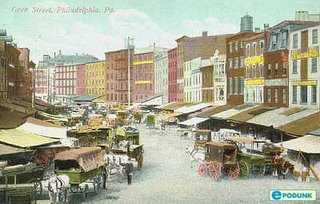
|
||||||||||||||||||||||||||||||||||||||||||||||||||||||||||||||||||||||||||||||||||||||||||||||||||||||||||||||||||||||||||||||||||||||||||||||||||||||||||||||||||||||||||||||||||||||||||||||||||||||||
Dock Street
Battleship New Jersey: Home is the Sailor
Home is the sailor, wrote A. E. Housman, Home from the sea. In this case, the sailor is the Battleship New Jersey. The U.S.S. New Jersey rides at permanent anchor in the Delaware River, tied to the Camden side. You can visit the ship almost any afternoon, and with reservations can even throw a nice cocktail party on the fantail. It's an entertaining thing to do under almost any circumstances, but the trip is more enjoyable if you spend a little time learning about the ship's history. The volunteer guides, many of them still grizzled veterans of the ship's voyages, will be happy to fill in the details. In the first place, the ship's final bloody battle was whether to moor the ship in the Philadelphia harbor, or New York harbor, when the U.S. Navy had got through using it. You can accomplish that and remain in the state of New Jersey either way, but there's a big social difference between North Jersey and South Jersey, so the negotiations did get a little ugly. Because of the way politics go in Jersey, it wouldn't be surprising if a few bridges and dams had to be built north of Trenton to reconcile the grievance, or possibly a couple of dozen patronage jobs with big salaries but no work requirement. The struggle surely isn't over. Battleships are expensive to maintain, even at parade rest; if you don't paint them, they rust. Current revenues from tourists and souvenirs do not cover the costs, so the matter keeps coming up in corridors of the capitol in Trenton.
Battleship design gradually specialized into a transport vehicle for big cannon, ones that can shoot accurately for twenty miles while the platform bounces around on the ocean surface. Situated in turrets in the center of the vessel, they can shoot to both sides. That's also true of armored tanks in the cavalry, of course, with the history in the tank's case of the big guns migrating from the artillery to the cavalry, causing no end of a jurisdictional squabble between officers trained to be aggressive for their teams. Originally, the sort of battleship which John Paul Jones sailed was expected to attack and capture other vessels, shoot rifles down from the rigging, send boarders into the enemy ships with cutlasses in their teeth, and perform numerous other tasks. In time, the battleship got bigger and bigger so in order to blow up other battleships had to sacrifice everything else to sailing speed and size of cannon. Protection of the vessel was important, of course, but in the long run, if something had to be sacrificed for speed and gunpowder, it was self-protection. There's a strange principle at work, here. The longer the ship, the faster it can go. Almost all ocean speed records have been held by the gigantic ocean liners for that reason. If you apply the same idea to a battleship, the heavy armored protection gets necessarily bigger, and heavier as the ship gets longer, and ultimately slows the ship down. As a matter of fact, bigger and bigger engines also make the ship faster, until their weight begins to slow them down. Bigger engines require more fuel and carrying too much of that slows you down, too. Out of all this comes a need for a world empire, to provide fueling stations. Since the Germans didn't have an empire, they had to sacrifice armor for more fuel space and more speed, to compensate for which they had to build bigger guns but fewer of them. Although the British had more ships sunk, they won the battle of Jutland because more German ships were incapacitated. When you are a sailor on one of these ships, it's easy to see how you get interested in design issues which may affect your own future. An underlying principle was that you had to be faster than anything more powerful, and more powerful than anything faster. The point here is that the New Jersey, as a member of the Iowa class of battleship, was arguably the absolutely best battleship in world history. At 33 knots, it wasn't quite the fastest, its guns weren't quite the biggest, its armor wasn't quite the thickest, but by multiplying the weight of the ship by the length of its guns and dividing by something else you get an index number for the biggest worst ship ever. The Yamamoto and the Bismarck were perhaps a little bigger, but the New Jersey was at least the fastest meanest un-sunk battleship. Air power and nuclear submarines put the battleship out of business so the New Jersey will hold the world battleship title for all time. Strange, when you see it from the Ben Franklin Bridge, it looks comparatively small, even though it could blow up Valley Forge without moving from anchor. One story is told by Chuck Okamoto, a member of the Green Berets who was sent with a group of eight comrades into a Vietnamese army compound to "extract" an enemy officer for interrogation. When enemy flares lit up the area, it was clear they were facing thousands of agitated enemy soldiers, and Okamoto called for air support. He was told it would take thirty minutes; he replied he only had three minutes, and to his relief was told something could be arranged. Almost immediately the whole area just blew up, turned into a desert in sixty seconds. The guns of the New Jersey, twenty miles away, had picked off the target. The story got more than average attention because Okamoto's father was Lyndon Johnson's personal photographer, and Lyndon called up to congratulate. A number of similar stories led to the idea that naval gunfire might have destroyed some bridges in Vietnam which cost the Air Force many lost planes vainly trying to bomb, but, as the stories go, the Air Force just wouldn't permit a naval infringement of its turf. This sort of second-guessing is sometimes put down to inter-service rivalry, but it seems more likely to be just another technology story of air power gradually supplanting naval artillery. Plenty of battleships were sunk by bombs and torpedo planes before the battleship just went away. If you sail the biggest, worst battleship in world history, naturally you regret its passing. Tourists will forever be intrigued by the "all or nothing" construction of the New Jersey. Not only are the big guns surrounded by steel armor three feet thick, but the whole turret for five stories down into the hold is also similarly encased in a steel fortress. This design traces back to the battle of Jutland, where a number of battlecruisers were blown up because the ammunition was stored in areas of the hold not nearly so protected as the gun itself. Putting it all within a steel cocoon lessened that risk, and had the side benefit that when ammunition accidentally exploded, the damage was confined within the cocoon. It must have been pretty noisy inside the turret when it was hit, sort of like being inside the Liberty Bell when it clangs. But not so; stories have been told of turrets hit by 500-pound bombs which the occupants didn't even notice. The term "all or nothing" refers to the fact that the gun turrets are sort of passengers inside relatively unprotected steering and transportation balloon. In order to save weight, most of the armor protection is for the gun. That's a 16/50, by the way. Sixteen inches in diameter, and fifty times as long. With the weight distributed in this odd manner, the Iowa class of dreadnought was more likely to capsize than to sink. Accordingly, the interior of the hull is broken up into watertight compartments, serviced by an elaborate pumping system. Water could be pumped around to re-balance a flooded hull perforation, certainly a tricky problem under battle conditions. Encampment At East FallsThe urban intersection at Queen Lane and Fox Avenue in East Falls is a busy one, and except for a few stately residences, it easily escapes notice by commuters. However, the landscape forms a bowl atop a steep hill, fairly near the Schuylkill River. George Washington had evidently picked it out as a strong military position near the Capital at Philadelphia, either to defend the city or from which to attack it, as circumstances might dictate.
Washington's plans and thought processes are not precisely recorded, but when Lord Howe had sailed south from the Staten Island- New Brunswick area, he ordered his troops to head for an East Falls encampment at the southern edge of Germantown. Crossing the Delaware River at Coryell's Ferry (New Hope), the troops marched inland a few miles and then down the Old York Road to this encampment. Their stay at the beginning of August 1777 was quite brief because Washington changed his mind. When it took Howe's fleet longer than expected to appear in the Chesapeake, Washington became uneasy that Howe might be conducting a feint designed to draw the Continental troops south, and after cruising around the coast, might still return to attack down the undefended New Jersey corridor from Perth Amboy to Trenton. That proved wrong, but in Washington's defense, it must be said it was a plan that had actually been considered by the British. Anyway, Washington ordered his troops to pull out of the East Falls encampment and march back up Old York Road to Coryell's Crossing, which would be a more central place to keep his options open for the time when Howe's true intentions became clear. Washington and his headquarters staff went on ahead of the main body of troops, setting up headquarters at John Moland's House a little beyond Hatboro and a few miles west of Newtown, Buck's County. The Hatboro area was a pocket of Scotch-Irish settlement, without any local Tory sentiment, thus preferable to the rest of largely Quaker Buck's County. To jump ahead chronologically, the East Falls encampment site must have seemed agreeable to the Continental Army, because a few weeks later it would be sought out as the main refuge and regrouping area, following the defeat at the Battle of Brandywine. The American troops were to withdraw from the Brandywine Creek when Washington realized he had been out-flanked, and head for Chester. Quickly recognizing that Chester was vulnerable, they headed for East Falls. Not only was Washington preparing to defend Philadelphia at that point, but was using the Schuylkill River as a defense barrier. As he had earlier done at the Battle of Trenton, he ordered all boats removed from the riverbanks, and artillery placed at any likely fording places, all the way up the Schuylkill to Norristown. Having accomplished that, this extraordinary guerrilla fighter then moved his troops from Germantown up the river to defend the fords. Meanwhile, Congress decided to move to the town of York on the Susquehanna, just in case. Germantown After 1730
The early settlers of Germantown were Dutch or German-speaking Quakers. They were proud of the craftsman class but, unfortunately, that made them rather poor subsistence farmers. With a whole continent stretching beyond them, professional farmers would not likely choose to settle on a stony hilltop, two hours away from Philadelphia. Germantown's future lay in religious congregation, in papermaking, textile manufacture, publishing, printing and newspapers. Plenty of stones were lying around, so stone houses soon replaced the early wooden ones. Since Philadelphia in 1776 had only twenty or so thousand inhabitants, and only thirty wheeled vehicles other than wagons, it was not too difficult for Germantown to imagine it might eventually eclipse that nearby seaport full of Englishmen. Two wars and two epidemics brought those Germantown dreams to an end, but in a sense, those calamities were stimulants to the town, as well. In 1730 real German peasants began to arrive in large numbers from the Palatinate section of the Rhine Valley. They arrived as survivors of a horrendous ocean sailing experience, packed in such density that it was not unusual to find dead bodies in the hold, of passengers that had only been supposed to have wandered into a different part of the ship. Quite often, they paid for their passage by selling themselves into what amounted to limited-time slavery, and a customary pattern was for parents to sell an adolescent child into slavery for eight or ten years in order to pay for the voyage of the family. They were uneducated, even ignorant, and often were proponents of small new religious sects. All of that made them seem to be a primitive tribe in the eyes of the earlier settlers. But they were professional farmers, and good at it. They knew, and a quick tour of Lancaster County today confirms their belief, that if you had a reasonable amount of very good land, you could live a life that approached that of the craftsmen in comfort, and usually far exceeded them in personal assets. They have therefore taken a long time to rise from farm to sophistication, while the already sophisticated craftsmen in Germantown wasted no time in abandoning farming. The peasant newcomers arrived in Philadelphia, made their way to nearby Germantown, learned a little about the new country and the refinements of their Protestant culture -- and then pressed on to the great fertile valley to the West, where the way had been paved by those twenty-five German families who had landed on the Hudson River several decades earlier and come down the Susquehanna via Cooperstown. Only a minority of the after-1730 Germans stayed on permanently in that steadily growing little German metropolis on a hill, and none of the very earliest German pioneers further west had even landed in Philadelphia. During this period, this Athens of German America also invented the Suburb. The pioneer of this concept was Benjamin Chew, the Chief Justice, who built a magnificent stone mansion on Germantown Avenue, which was to become the main fortress of the Battle of Germantown in the Revolutionary War. Present-day visitors are still impressed with the immensity and sturdy mass of this home. Grumblethorpe, Stenton and a score of other country homes were placed there. Germantown in 1750 still wasn't a very big town, but it was plenty comfortable, quiet, safe, intellectual and affluent. Its first disruption came from the French and Indian War. Rubberneck Tours of Philadelphia (1)
To qualify as a rubberneck tour, a route can be traveled in two hours by car, avoids the unsightly parts of town, strings together a lot of interesting sights which are of interest to visitors from out of town -- and educates the life-long residents as well. Several tours qualify, and it's a pity you can't go to someplace near City Hall and select one of them from a line of buses. Perhaps in time tourism will reach the point where this is possible. For a start, go West from the center of town, out Walnut Street to 33rd Street, turn right. You won't see all of the University of Pennsylvania, but you will see a lot of it, followed by the campus of Drexel University. This was once a very elegant district, and many Victorian mansions can be seen as you go out to the Zoo. Navigate around a little with a map and get on Belmont Avenue. Be sure to get a glimpse of Sweet Briar mansion, peeping through on the right. You will be able to see Memorial Hall and other remnants of the 1876 Exhibition, soon to be the site of the Please Touch Museum. Keep going on Belmont, past the Ohio House which dates from the Exhibition, and on out Belmont Avenue to City Line Avenue. Here's the surprise. Cross over City Line Avenue into Montgomery County and keep going. You will go past some lovely houses on the left, and the borders of Laurel Hill Cemetery on the right. You are going downhill now, through the woods, and you sweep around the right to the bridge over the Schuylkill. Didn't expect to go out of the city into the woods so abruptly, did you? And now, crossing the Schuylkill, turn abruptly right on to Main Street in Manayunk. Another scenic shock, as you emerge from a country lane onto several miles of a gentrified abandoned factory town. In the summer, there are an awful lot of people sitting at sidewalk tables, talking about who knows what. Perhaps they are mostly resting their feet from shopping, whatever that means, in all the little stores now selling shoes and kerchiefs, apartment furniture, and knick-knacks. After a while, Main Street turns into Ridge Avenue, which eventually leads you back to the Benjamin Franklin Parkway, and back to City Hall. A somewhat prettier drive is closer to the river, with the landscaping and boathouses of the Schuylkill Navy.
But continuing on Ridge Avenue allows you the option of an abrupt turn left on Schoolhouse Lane, where it's admittedly a little hard to find and navigate a left turn, scooting you abruptly back up a steep hill and into the woods again. Turn right on Vaux, right again on Warden Drive, and then left to Midvale, following it down to rejoin Ridge Avenue at the bottom of the hill. This little side-trip allows you to see some pretty unexpected woody suburbs, and if you have been told where to look, the former home of Grace Kelly, and the homes of Senator Spector and Governor Rendell.
Give it a few years, and Ridge Avenue at this point is sure to get gentrified like Main Street, back up that hill in Manayunk. Now, either take Kelly Drive back into town, or continue down Ridge past old (East) Laurel Hill Cemetery and a brief spin into Sedgely and the mansions along the cliff in East Fairmount Park. Or a brief detour over the Girard Street bridge to the edge of West Fairmount Park is worth a few minutes, returning by the Spring Garden Street bridge to the back of the Art Museum, and then down the Parkway. You've just had a pleasant two-hour tour, researched and designed by the history department of the University of Pennsylvania to illustrate Philadelphia's role in the days of the Civil War. Back then, the area roughly enclosed by our rubberneck tour #1 was just beyond the edge of the town, an ideal spot for many training camps for the Union Army. Further south on the Schuylkill at that time was a collection of factories known as the "arsenal of the North". This more northerly part of town, now filled with thousands of brick row houses, was once let us say, the boot camp of the North. Billy Penn's Hat
Philadelphia City Hall was intended to be the tallest building in the world, so there was no reason to suppose anything in Philadelphia would be taller. Gradually, taller buildings in other cities were built, but there grew up a gentleman's agreement that no skyscraper would be built in Philadelphia that was taller than William Penn's hat atop his statue on the tower of City Hall. Planning in the city was organized around this premise, which affects subways and other transportation issues in the city center. Because of assassination fears, a similar tradition in Washington DC was enacted into law, and it must be admitted that the flat skyline of that city looks a little dumb and boring. But Philadelphia neglected to pass a law, and so at the end of the Twentieth Century first one and then half a dozen skyscrapers were built that were twice the height of City Hall, immediately destroying the organizing visual center of the city. Pity. But there are more serious issues involved. Aesthetics aside, who cares if someone bankrupts himself building an inappropriately tall building, with excessive elevator costs, problems with reinforced foundations, shortage of parking space, and the like? And the answer to that is the new tall building will bankrupt the older office buildings, not itself. Using offers of low, low rents to fill the new building, tenants will be drained from other spaces, and other areas of the city will deteriorate unless there happens to be a general shortage of office space in the region. Carried to an extreme, all of the center city business might be envisioned to reside in one thousand-story building, and the rest of the region would be a desert. The obvious response would be that no landlord wants to have competition, and new construction is the way a city renews itself, creatively destroying the old to make room for the new. You must not allow the vested landlords to capture the political process with agitation if not bribes. Push things too far in that direction, and you will find that political corruption has destroyed the fabric of the town more effectively than a couple of skyscrapers ever could. Market East has been devastated, it is true. But that's the price of conducting the commerce of the region on the basis of market economics instead of through bureaucracy which masks corrupt politics with high-flown language. Paris is beautiful, but France has 12% unemployment which is closer to 16% if you remember the 30-hour week, the nine-week vacations, and retirement age in the fifties. And yet, there is certainly a point to be made here. The height limit on new construction must bear some relationship to the regional need for new office space, and not merely rely on beggar-my-neighbor. We're currently hearing about two new projected skyscrapers, one beside 30th Street Station, and the other at 17th and Market/Chestnut. The decision to go or no-go will rest with whether the developers can find "lead" tenants. The corporate officers of these large enterprises are the ones who must be expected to give careful consideration to the best interest of the community because right now they are the ones who control matters. If they neglect their responsibilities, the pressure to pass more zoning laws will prove hard to resist. The Houses in the Park
Fairmount Park is said to be the largest park (7000+ acres) within the limits of an American city, and in fact, maybe just a little bigger than the city can afford to maintain. It was established in the middle of the 19th Century through the efforts of the College of Physicians of Philadelphia to reverse the Industrial Revolution's relentless pollution of Philadelphia's Schuylkill River and the water works. The waterworks were built in 1801 in the mistaken belief that Yellow Fever was caused by pollution; Fairmount Park more accurately responded to the idea that Typhoid Fever was waterborne from upstream pollution. Lemon Hill, the nearby mount containing Robert Morris' Mansion, was purchased to expand the reservoir capacity of the waterworks and thereby made the Art Museum possible where the reservoirs were originally located. The Park has long constituted a symbolic interval between center city and the suburbs. Since the construction of the river drives and later the expressway, the commute along the river amidst trees and parkland has made an entrance to town a pleasant experience. If the town planners had been able to foresee automobile commuting, they might have anticipated that the sun would be in the driver's eyes coming East during morning rush hour, and in his eyes as he went home toward the West in the evening. Driving safety might perhaps have been impaired by the tendency of this glare to direct attention to the park rather than straight ahead, but nevertheless redoubles the effect of the park views as a daily aesthetic experience. Even the pollution idea had its ambiguous side since animals increase the bacterial runoff from their grazing areas, and the original houses in the park had many pastures. Strip mining, however, allows mineral contaminants to be washed by rain into the watershed. The city waterworks today extract nearly 800 tons of sludge from the water supply, daily. Whatever the effect downstream, the high ground had less malaria and less typhoid than swampy lowlands, so many of the original houses were useful summer retreats for city dwellers during the early years of the city. The park is governed by the Park Commission, and at one time had its own police force, the fourth largest police force in the state. Started in 1868, the Park Guards changed their name to the Park Police and then became part of the Philadelphia Police in 1972. The original 28 officers had grown to 525, had their own police academy and a proud tradition. It seems very likely that some deep and dirty politics were played in this shift of authority, and it might be a fair guess that some bitterness still survives in the circles who know and care about these things. In 2008 a scarcely-noticed rule change gave the Park to the City Department of Recreation, thus placing it just a little closer to ambitious real estate development. Our present concern, however, is with the houses in the park. There are seven of them, kept up and maintained by the Philadelphia Museum of Art. Guided tours are provided intermittently by the museum, but since funds are limited only three of the houses are open year round. The others are equally worth a visit but unfortunately, are closed during the height of the spring flowering season. Two of the year-round houses represent the two extremes of Philadelphia culture, since Mount Pleasant was owned by a buccaneer ("privateer") named McPherson who lived at the height of 18th Century elegance, while Cedar Grove was originally a Quaker farmhouse of the greatest simplicity consistent with honest comfort, a style which persisted relatively unchanged until late in the 19th Century. Benedict Arnold and Peggy Shippen looked at Mount Pleasant with an eye to purchase but never lived there because they were called away by national events. With the addition of modern plumbing and air conditioning, Mount Pleasant would be an elegant place to live, even today. McPherson had to sell the place to pay his debts, whereas the Wister and Morris descendants of Cedar Grove still populate the Social Register in large numbers. The two houses completely typify the underlying philosophies of the two leading Philadelphia classes of leadership. One group measures itself by how much it spends, the other group measures success by how much it has left. REFERENCES
John Bartram's Garden
It's worth a visit to Bartram's Gardens, if only for the astonishment of finding a very large farm and stone Quaker farmhouse within a few blocks of our largest medical center, a stone's throw from the biggest oil refinery on the upper East Coast. And located on the edge of a neighborhood that is, well, past its prime. The trees on the farm are centuries old, so walking around the grounds imparts the feeling of being hundreds of miles from civilization when in fact you are only a hundred yards away from streets that are very urban, indeed. When you turn in certain directions, an occasional skyscraper peeps over treetops, and down the meadows, at the farm's dock on the leafy-banked Schuylkill, you can see oil storage tanks across the river, just a long shot with a 2-iron away. Look upward, to see the upper half of shining towers of Center City. The farm property as it now stands dates back to 1728, but the site marks the earliest beginnings of the city, nearly a hundred years earlier. The river curves around this hill then snake on down to Delaware through flatlands which were originally swamps ("wetlands", as they say). The hill is as far downriver into malaria territory as the Indians were willing to go, so the Dutch traders had to sail upriver and dock there in order to take thirty or forty thousand fur pelts back to Holland each year. One thing or another has been dumped on the swamps for three hundred years, and the oil companies found it a cheap place to buy enough land for their refineries, close to four or five railroads near Bartram's place, and with access to the high seas. Right now, most of the oil comes from Nigeria, emptying two or so supertankers a week. There has to be enough storage capacity to take care of delays caused by bad weather on the Atlantic, and there has to be access to railroads and highways to carry the finished product away. The rest of a refinery is just thousands of miles of metal pipes, gleaming in the sun. Sun Oil is trying to be a good neighbor, turning more and more of the area over to nature preserve, as chemical engineers have learned how to work in a smaller space with fewer employees. The banks of the lower Schuylkill are now mostly grown to shrubs and trees, concealing from boat travelers the rather extensive dumps of old auto tires and similar refuse. It's a placid winding trip, increasingly coming to resemble what the Dutch traders once encountered. Especially in May, when the Palomino or Empress trees are in purple bloom. It seems the Chinese packed their porcelains in dried Palomino seed pods, and the discards have grown up to quite a nice display. Logan Square is filled with such trees, quite artfully pruned and maintained; just imagine several miles of the river lined with them, and you can see why the Tourist Bureau is excited about the potential. If you have been to San Antonio you know the potential of an urban river ride, which in this case might go all the way up to the Art Museum. Given enough public response, you can envision two or three-day barge rides from New Castle, Delaware to Pennsbury, with side trips up past Bartram's to the Waterworks. Right now, trips are comparatively limited by the tides, with a few trips a year down from Bartram's to the refineries, and a few more up to the river to the Art Museum. They use floating docks, and permanent docks will need to be built.
Originally, the crude oil came from upstate Pennsylvania, near Bradford, and was the main source of the dominance of the Pennsylvania Railroad. Baltimore and New York were also the beginnings of transcontinental railroads, but their freight cars came back empty. The upstate Pennsylvania oil gave the PRR a dominant edge by supplying cargo for two-way revenue. When George Washington had to retreat from the Battle of Brandywine, the armies had to cross the wetlands, and the river, to get to Philadelphia. Washington got there first and burned the boats after his army got across. He knew, but the British probably did not fully realize, that the first place to ford the Schuylkill was at Norristown. When the British finally got that far, Washington was waiting for them, but a fall hurricane came along and soaked everybody's gunpowder before there could be much of a battle. Unfortunately, Mad Anthony Wayne was unprepared for a nighttime bayonet charge, and there was still quite a slaughter. You can't wander around John Bartram's house and gardens without getting the impression of considerable wealth. Bartram was interested in botany, becoming the most eminent authority on plants of the Western hemisphere, a very close friend of Benjamin Franklin, and probably the main force behind the creation of the American Philosophical Society. But although Bartram was a hobbyist, he was a shrewd businessman, selling curiosity plants to Europeans, and commercially improved fruits and vegetables to local farmers. There are still some Bartrams around Philadelphia, with a strong Quaker air about them. Around 1850 the place was sold to a zillionaire railroad magnate named Eastwick, who fixed up the place in the high style he learned building the railroads of Russia for the Tsar. The mansion has been torn down, but the stone farmhouse, stone barn, stone sheds, stone outbuildings, stone everything -- endures, like many of the curiosity trees and bushes. Well worth a visit. Mrs. Meade's House
General George Gordon Meade, the hero of Gettysburg, lived in quite an elegant house during the six years (1866-72) he was a Commissioner of Fairmount Park. The house (at 19th and Delancey) has "MEADE" carved over the stately entrance facing 19th Street, and while the neighborhood has run down somewhat, it was obviously once an imposing mansion. The house belonged to Mrs. Meade. From that, you might suppose that the General had married a rich woman, but that would be wrong. When General Lee was advancing on Gettysburg, it was widely supposed that his goal was to conquer Philadelphia, the Arsenal of the North. The town was in a panic, built some forts on the Schuylkill to defend itself, and later lionized the hometown hero who had saved them. Mrs. Meade was living at the time in a modest little place, and the town fathers took up a collection to buy General Meade a proper house. A delegation of officials traveled down to Virginia to present him with their gift of gratitude, but Meade would have none of it. He was only doing his duty, and could not consider for a moment accepting major gifts for his soldiering. No, he was very sorry, he had to decline. So the delegation came home, all a fluster. Someone then had the idea of offering the house to Mrs. Meade. And when they visited her, she promptly said "Sure." Philadelphia Gardens
There are many show gardens, mainly on former large estates, scattered around the United States, and the ones on Southern plantations are quite famous.
Longwood Gardens, They feed you pretty well in the associated restaurants there, and the bookstores and gift shops are truly outstanding. But what in many ways is the best show garden in Philadelphia is Chanticleer, the former estate of a family that founded what is now Merck Pharmaceuticals, located in the suburb of Wayne, across the street from where Tracy Lord, the heroine of The Philadelphia Story, lived on two square miles of the Main Line.
It's not clear why Chanticleer is such a well-kept secret, but it's sure worth the trip to see it at almost any season, May preferred. Interest in gardening is not limited to just a few big estates, it's a Philadelphia sport. Therefore it's not surprising to learn that the largest flower show in America is held in Philadelphia at Convention Hall in the Spring. If your feet aren't flat when you go in, they will surely be flat when you come out because a complete tour would be miles long, threading among the aisles. It's not easy to guess how much money each exhibitor spends on a display, but it's surely not a cheap hobby when you get to this level. If you notice the landscaping on public grounds in the city, it's always a fair guess that it was paid for by the profits generated by The Flower Show. Almost everybody has heard of the Burpee Seed Company, and Mr. Burpee summed up the prevailing attitude of Philadelphia gardeners: "If you want to be happy for a day -- get drunk. If you want to be happy for a week -- get married. But if you want to be happy for a lifetime -- get a garden." REFERENCES
Stephen Girard and Religion
In 1950, an elderly retired gentleman named Witherbee paid me a visit when I was temporarily covering practice for a doctor in Woodbury, New Jersey, in locum tenens, as we say. His medical problem was easily tended, and we chatted. He told me that he had attended Harvard Divinity School many years before, and one day was about to graduate as an ordained minister. His family and many other proud families were gathered on folding chairs on the lawn in Cambridge to watch the graduation ceremonies. The graduates were called up one by one, in alphabetic order. Since Witherbee is at the end of the alphabet, he had a lot of time to think over the significance of what the members of his class were doing. In time, thinking over the personal defects of each classmate who preceded him, he became overwhelmed with a personal question. "How can I tell others how to behave, when I don't know how to behave, myself?" And so, when his turn came, his name was called out, and he rose in his seat. "I decline to graduate." The consternation of his family can be imagined, along with the stir in the audience, the astonished face of the Dean, and his own confusion about the uproar he had just caused. But although the die was cast, and the action a final one, it had a surprising outcome. The next day, he received a telegram from the Girard College in Philadelphia, inviting him to be considered for the position of Director of Religious Studies. It seems that Stephen Girard had provided in his will that no ordained minister might set foot within the walls of Girard College, and yet they felt they needed someone to oversee the religious study. Witherbee was perfect: he had the credentials, but he did not have the ordination curse. And so he happily remained in that capacity for the rest of his employed life. REFERENCES
Shrine of Historical Restoration
There are only a half-dozen wooden houses in Philadelphia, a consequence of laws passed after a disastrous colonial firestorm. Silas Weir Mitchell wrote a novel called "The Red City", referring to all the red brick houses in Philadelphia, particularly those along the bank of the Delaware River, greeting visitors arriving by sail. People who know about these things say only Dublin, Ireland has more redbrick colonial and Federalist houses still standing. You have to care about these things to preserve them; recently I heard that New Brunswick in New Jersey had a very large patch of Eighteenth Century and Federalist houses still standing fifty years ago. No one seemed to care, so they crumbled.
But Charlie Peterson cared, and Judge Edwin O. Lewis cared, too. Peterson and Lewis are now gone, but these two were the idea men behind the historical restoration of Philadelphia, for which Mayor Dilworth and Senator Joe Clark generally get most credit. The Edwin O. Lewis fountain was recently torn down to make room for a gigantic visitors center, sic transit Gloria Mundi, but he alone had the force of personality, wit, imagination and drive to make Peterson's vision come to pass.
You are expected to be self-effacing if you work for the Park Service, but Charlie had a way of winning arguments and bringing people around to his visions. He thinks big. Back in the days when the Park Service was strictly a management team for the National Parks in the West, Charlie persuaded the service that if they developed some parks in the Eastern part of the country, there might be more congressmen willing to vote funds for their projects. And that, in essence, was the driving slogan of the restoration of Williamsburg, Virginia, and the Skyline Drive. Lots of very rich people joined into these celebrations of the past, but it was Charlie who gave them the courage to hold their cultural opinions. And that was particularly true of the midwesterners with French names living in Midwestern states with French names, mostly unaware until he told them so, that it was the French coming down from Canada that opened up that region long before Lewis and Clark set out. Charlie had an interesting time making the Adams Farmhouse in Quincy Mass . into a part of the national heritage; it's now the Adams Mansion. But it is Society Hill of Philadelphia that collectively got up off its unimaginative back, meanwhile becoming a national monument, and a silent monument to Charlie Peterson. In the Quaker view, the worship of buildings is idolatry. If you go to the right place and knock on the right door, you will find that Charlie had the imagination to take all that junk out of the dumpster, work out the provenance, label, and display exhibits of the architectural history of the area, starting a whole industry of house restorers who now have a template against which to match their un-provenanced dumpster relics. Who but Charlie would have held cocktail receptions to look at the salvaged crockery found in old Philadelphia privies, and even though thoroughly washed up, had the combination of quiet wit and brazenness to make the events a rollicking success. The Architectural Fragments Museum is something you are sure to talk about if you know enough to visit it and providing they will let you in... No doubt the museum of shutters, nails, and doorknobs had its origin in his mind as a result of creating HABS, the Historic American Building Survey, in Washington thirty years earlier. The first and largest of its kind, this collection of photographs and measured drawings of practically every building in America with historical significance was started by him in 1933 with WPA money and unemployed architectural talent in the great economic depression of that time. It's worth a visit if they will let you in, which is not guaranteed, either. Put that name down Charles E. Peterson, the father of American architectural preservation and restoration. Washington Lurks in Bucks County, Waiting for Howe to Make a Move
Although Bucks County, Pennsylvania, is staunchly Republican, it has been home to Broadway playwrights for decades; this handful of Democrats have long been referred to as lions in a den of Daniels. One of them really ought to make a comic play out of the two weeks in August 1777, when John Moland's house in Warwick Township was the headquarters of the Continental Army. John Moland died in 1762, but his personality hovered over his house for many years. He was a lawyer, trained at the Inner Temple and thus one of the few lawyers in American who had gone to law school. He is best known today as the mentor for John Dickinson, the author of the Articles of Confederation. Our playwright might note that Dickinson played a strong role in the Declaration of Independence, but then refused to sign it. Moland, for his part, stipulated in his will that his wife would be the life tenant of his house, provided -- that she never speak to his eldest son. Enter George Washington on horseback, dithering about the plans of the Howe brothers, accompanied by seven generals of fame, and twenty-six mounted bodyguards. Mrs. Moland made him sleep on the floor with the rest. Enter a messenger; Lord Howe's fleet had been sighted off Patuxent, Maryland. Washington declared it was a feint, and Howe would soon turn around and join Burgoyne on the Hudson River. Washington had his usual bottle of Madeira with supper. A court-martial was held for "Light Horse Harry" Lee, for cowardice. Lee was exonerated. Kasimir Pulaski made himself known to the General, offering a letter of introduction from Benjamin Franklin, which letters Franklin noted had been requested by Pulaski himself. As it turned out, Pulaski subsequently distinguished himself as the father of the American cavalry and was killed at the Battle of Savannah.
And then a 19 year-old French aristocrat, the Marquis de Lafayette, made an appearance. Unable to speak a word of English, he nevertheless made it clear that he expected to be made a Major General in spite of having zero battlefield experience. He presented a letter from Silas Deane, in spite of Washington having complained he was tired of Ambassadors in Paris sending a stream of unqualified fortune hunters to pester the fighting army. Deane did, however, manage to make it clear that the Marquis had two unusually strong military credentials. He was immensely rich, and he was a dancing partner, ahem, of Marie Antoinette. In Mrs. Moland's parlor, Washington sat down with Lafayette to tap-dance around his new diplomatic problem. It was clear America needed France as an ally, and particularly needed money to buy supplies. But it was also clearly impossible to take a regiment away from some American general, a veteran of real fighting, and give that regiment to a Frenchman who could not speak English and who admitted he had no military experience. Fumbling around, Washington offered him the title of Major General, but without any soldiers under his command, at least until later when his English improved. To sweeten it a little, Washington seems to have said something to the effect that Lafayette should think of Washington as talking to him as if he were his father. There, that should do it. It seems just barely possible that Lafayette misunderstood the words. At any rate, he promptly wrote everybody he knew -- and he knew lots of important people -- that he was the adopted son of George Washington. Well, Broadway, you take it from there. At about that moment, another messenger arrived, announcing Lord Howe at this moment was unloading troops at Elkton, Maryland. General Howe might have been able to present his credentials to Moland House in person, except that his horses were nearly crippled from spending three weeks in the hold of a ship and needed time to recover. Heavy rains were coming. (Exunt Omnes). Suggested Stage Manager: Warren Williams New Phillies Stadium
Built to house the Dempsey Tunney prize fight, we have seen six stadiums built there in one lifetime, a seventh in prospect, and three torn down. Building stadiums well are not the same as playing sports well, just as buying cameras is not the same hobby as taking photographs. In both cases, it is possible to get confused as to what hobby you are trying to excel in. Anyway, we have just opened stadium number six, for baseball, named Citizens Bank Stadium. The new baseball park holds 43,500 spectators, and recently it fills to capacity. There are four or five million people in the region, so if everybody goes there just once to see what it looks like, it should stay full for four or five years. On the days of baseball home games, that is, since it is dead empty for away games, and on days when football and basketball are played in the nearby stadiums dedicated to those sports.
That is, at best it will be empty most of the time. New tickets will be $90 apiece in really choice sections, not to mention the corporate boxes, and the ordinary first-class tickets will be $40. The most expensive seats in the old, so-called Veteran's Stadium, were $28. You can take that either way. Perhaps we are pricing ourselves out of major league baseball. And perhaps a willingness to fill the stadium at these new prices is a sign we should have built a new ballpark long ago. The first step in building Citizens Park
was to dig a big hole in the ground. The playing field ends up twenty-five feet below ground level, so that half of the people who arrive at the park will walk downstairs to their seats, and half will walk upstairs. Never mind; when the game is over, the ones who went down will have to climb up, and the people in the balcony can walk down. That's pretty fair. Of more concern is the water level of the former swamp between two rivers. It was necessary to put in a powerful set of pumps to keep the stadium from turning into a lake. If the power goes out for any extended duration, some interesting photographs could emerge. It's reassuring to know that the Veteran's was built along the same principles.
When the Vet was famously imploded into a pile of rubbish, the disintegrated remains of the stadium didn't quite fill the hole. Here's some forward planning, all right. If we are in the business of constructing serial stadiums, the cost of this hobby is appreciably reduced by incorporating the self-service rubbish removal feature. If there are other features like this one, perhaps this stadium collecting hobby isn't as expensive as it sounds. Home of the U.S. Naval AcademyGray's Ferry, the first non-swamp ground as you come up the Schuylkill, is the oldest part of Philadelphia, and one of the saddest. This was the place where Washington and the other Southern delegates came to the Continental Congress along the main North-South route of the Colonies. John Bartram's gardens are nearby, and Andrew Hamilton's mansion. But things are in a sorry state nowadays, and neighborhood residents believe it is unsafe even to drive through there. Of all the areas in the city, this one cries out most for rehabilitation. Well, Toll Brothers, the mass builders, are doing something there. Almost any construction, or any demolition, would seem like an improvement. But you have to hold your breath when you see bulldozers in the old Naval Home, a large and stately building along the river, hidden behind a long wall. Some pretty old and historic buildings are in danger of being torn down. This was, for example, the original home for six years, of the United States Naval Academy. You know, the one that is now at Annapolis. Doesn't anyone care? Gardens for Posterity
We must be indebted to "Several Anonymous Philadelphians" who wrote a book published in 1956 called Philadelphia Scrapple, now out of print but subtitled "Whimsical Bits Anent Eccentricities and the City's Oddities." The Athenaeum librarian has carefully penciled in the names of Harold Donaldson Eberlein and Mrs. Henry Cadwalader as the probable authors of this work, and it's likely that is the fact of it. Chapter XIV of "Philadelphia Scrapple" discusses a class of notable public gardens not designed to be show gardens, but originally the hobbies or passions of the original owner for private enjoyment, and later were opened to the public. These abound in Philadelphia, sometimes somewhat decayed, often truncated as the land was sold off, but constantly increasing in interest as the boxwood, trees, and shrubs continue to grow in size and rarity. The Anonymous Philadelphians have classed these lovely and somewhat unknown places as "Gardens for Posterity". Quite often, the estate houses to which they belong are better known than their gardens, and the original owners just regarded their gardens as a normal part of the house. While there are dozens of such places, the more notable ones are Grumblethorpe in Germantown, The Grange in Delaware County, Andalusia along the Delaware, and two famous gardens in decrepit neighborhoods along the lower Schuylkill, John Bartram's Gardens and William Hamilton's ("Woodlands"). There is a record that the Continental Congress once adjourned to visit Bartram's garden, and Hamilton's garden is mentioned by several famous Revolutionary figures since it was on what was then the main route from Philadelphia to the Southern Colonies. John Wister's 1744 garden at Grumblethorpe was 188 by 450 feet in size; some of the boxwood have had a long time to grow.
To these should be added the hospital gardens at the Pennsylvania Hospital, at Friends Hospital along Roosevelt Boulevard, and the garden of Chester-Crozier Hospital, all of which are especially spectacular in early May when the Azaleas are in bloom. Just about every surviving mansion of colonial rich folks had such a garden at one time. And tucked away behind many current mansions are lovely gardens that are considered to be just as private as their living rooms. While they are proudly displayed to friends, strangers knocking at the garden door would be considered the height of rudeness. It will take another generation or so for them to be thrown open to the public. By that time, who knows what state of repair they will be in. For a unified access point for 30 gardens in the Philadelphia area, try www.greaterphiladelphiagardens.org Henry Mercer's Rathskeller
RRathskeller was originally the name for a restaurant in the basement of a German City Hall, where the town Council would gather privately and make deals. That's quite different, by the way, from a Bavarian beer garden, which is a restaurant attached to a brewery where the public sings patriotic songs. Philadelphia used to have lots of both beer gardens and rathskellers, until World War I made German culture unpopular here, and the Volstead Act made beer illegal. In many ways, the most important surviving rathskeller in Philadelphia is in the basement of the Racquet Club. Surprisingly, it has only been a rathskeller for about twenty years. Horace Trumbauer built the club on 16th Street in 1906, but by 1907 parts of it were still unfinished. He invited a fellow member of the club, Henry Mercer, to design the hang-out in the basement. Mercer, who was then known mainly as the curator of the University of Pennsylvania Museum of Archeology, was to go on to become famous for his factory producing tiles of burnt clay in Doylestown. The grotto in the Racquet Club basement was to be his laboratory for developing a style of poured-in-place concrete construction, with "Mercer" tiles embedded in the walls and particularly the floor. Mercer's own mansion and museum, built in Mercer style, are next to his pottery in Doylestown; not everyone is thrilled with the Mercer style, but it is not easily forgotten. The grill room, or wine room, of the Racquet Club was built around a concept. It was to have an enormous stove or grill, serving club members oysters, steaks and chops with lots of beer, twenty-four hours a day, seven days a week. That sort of eating and drinking is now uncommon, and one club historian has remarked that most of the members who enjoyed that sort of lifestyle, probably died of it. To symbolize that the door to the grill was always open, the key was buried under a Mercer tile in the huge fireplace. Inscribed on the tile was the Latin motto, "DUM CLAIM TEAM". Off in a side area were four bowling alleys, now covered over because of disuse. With a huge fireplace and an even huger grand grill lit twenty-four hours a day, the place was said to get a little warm in the summer. The area has since been air-conditioned, but its popularity will probably return only when Prohibition does. Henry Mercer liked poured concrete walls, which at their best are gloomy grey, and with a big fireplace can soon get dark and dirty. As the lights in Mercer's home, the light bulbs were dim, even flickering. It is impossible to imagine a college fraternity house with more appeal to young males than the wine room of Philadelphia's socialite Racquet Club. However, with the decline in popularity of the room which parallels Philadelphia's restaurant revolution, the idea finally gained acceptance that salvation lay in pepping up the grotto. So, in the 1980s, the walls were painted white, the light bulbs were increased in strength, the ceiling was lowered, and four ceramic wine barrels were placed next to the fireplace. As a final touch, several dozen flags of various nations were stuck in the walls around the room. The historic laboratory in which the Mercer style was developed and made famous, was transformed into somebody's idea of a Rathskeller. At Friday lunch, the rafters ring with the gaiety of the Right Angle Club, most of whose members have heard of Mercer, but somehow never had time to go look at his museum. Benjamin Franklin Parkway (1)
Philadelphia has straight streets and square blocks in all directions, by the hundreds. Just a few streets slant off at an oblique angle, and most of those, like Germantown Avenue, is following old Indian Trails. The one, cold-blooded, deliberate slant street is the Benjamin Franklin Parkway which essentially runs from City Hall to the acropolis holding the Art Museum aloft. Just whose idea it was is unclear, although the architect Horace Trumbauer gets most credit. The actual design was given to a Frenchman, Jacques Greber, presumably because it imitates the effect of the Champs d' Elysee in Paris -- a broad sweeping boulevard with lanes of trees along the side and in the medians. As things turned out, a simple idea was pretty hard to put into practice. First of all, plenty of people in Philadelphia don't like anything if it's French, and an even larger number don't like the idea of messing around with our nice traditional system of squares at taxpayer expense. The people who lived in the area were naturally upset to see the ends of blocks chopped off, destroying the corner property entirely and exposing the backyards of the neighbors to public view. At the beginning of the Twentieth Century, the Pennsylvania Railroad's Chinese Wall cut off the center of town from "North of Market" , and the Parkway thus created a triangle of desolation that could only recover when the Swan Fountain appeared, named
after the President of the Philadelphia Fountain Society. The sculpturing was done by Alexander Stirling Calder, the son of the sculptor (Alexander Milne Calder) of William Penn atop City Hall. The original design made the mistake of planting all the trees as red oaks, and so most of them died of the same disease at the same time, requiring replacement with mixed varieties of trees that would not be so susceptible to epidemics. People were reluctant to live in the isolated triangle of land to the South of the Parkway, and also in the strip of land North of the Parkway up the steep hill to Eastern State Penitentiary on Fairmount Avenue. Accordingly, the land was filled with public buildings, including the semi-prison for adolescents, the Central Detective Bureau, and so on. The deep cut for the railroad spur connecting the Baltimore and Ohio (along the Schuylkill) with the Reading Railroad running out of 12th and Market, didn't help encourage people to raise their children in the area, either. And that wasn't all. The Swan Fountain was designed in such a way that you couldn't get underneath it to change a light bulb, so a set of tunnels had to be dug underneath the fountain plaza as an afterthought. Planting the plaza with Paulownia trees was a stroke of genius. Although the blue blossoms are only spectacular for one week out of fifty-two, the massive limbs are always striking, even in the dead of winter.The Rodin Museum came along, and although it is a little isolated, is a grand display in the same spirit as the boulevard itself, including the modernist sculpture of Alexander Calder. There is talk of creating a museum on the Parkway for the three generations of Calder's, and even agitation to bring the Barnes Museum in from Merion. With the Academy of Natural Sciences, the Franklin Institute and the Art Museum itself, the boulevard is still growing and evolving. When traffic is heavy, people just want to get home as fast as possible, but most of the time the Parkway uplifts the soul, just as it was intended to. It's an outdoor thing, not an interior one, and there is something symbolic about the famous movie run of Rocky, pounding up the stairs to turn, holding up his victorious arms, to a breathtaking view of the city. But remember, although now closely associated with the Art Museum, he never went inside. Religion at Girard College:Spiritual But IrreligiousAccording to Cheesman A. Herrick, "After Girard had dictated that famous section of his will excluding clergymen and William J. Duane had written it down, Girard asked Duane what he thought of it. Duane, being quite unprepared for the question, and somewhat at a loss to interpret the section, answered, ' I can only say now, Mr. Girard, that it will make a great sensation.' To this Girard replied, ' I can tell you something else it will do -- it will please the Quakers.'"
In the Western part of America, Quaker meetings sometimes do have paid ministers, but the Philadelphia Yearly Meeting and it is component monthly meetings have held steadfastly to the tradition of "unprogrammed meetings"-- without ministers. Girard was not a Quaker, but he greatly admired them, and three of the five executors of his will were Quakers. It, therefore, seems likely, at a minimum, he hoped that Quaker sentiment would fortify his intended banishment of clergymen from his school for orphans, and he might well have got the basic idea from them. Quakers have long noted with disapproval that paid ministers have often publicly supported wars, and Quakers notice that governments waging wars have typically sought to stir up warlike feeling by persuading ministers to help them do so. Another behavior which is almost inherent in the clergy is for ministers to feel that they are measured by the size of the congregation they attract, and hence almost invariably proselytize for new membership. Girard had firm ideas about influencing impressionable orphans, and he did not wish to have outside ideologies capture the administration of the school. 1830 was an evangelical time, and Girard could easily imagine some highly charismatic minister captivating the school. Other motives may, of course, be imagined. This is what is actually in the will: Prohibiting any ecclesiastic, missionary or minister of any sect from holding or exercising any station, no such person should ever "be admitted for any purpose or as a visitor, within the premises occupied by the College...I do not mean to cast any reflection upon any sect or person whatsoever, but inasmuch as there are such a multitude of sects, and such a diversity of opinion amongst them, I desire to keep the tender minds of the orphans free from the excitements which clashing doctrines and sectarian controversy are so apt to produce." As matters were to turn out, religious meetings have been conducted by laymen almost every day at the College, and the custom grew up that the boys themselves were often called upon to conduct religious meetings. A great many graduates of Girard College eventually went on to careers in religious ministry, so it even seems likely that their experience at the school had the effect of interesting them in the ministry by giving them a taste of it. In 1844, the numerous relatives of Stephen Girard tried to break the will. No one has seriously proposed their grievance was anything but financial. However, they sought the services of the most noted lawyer, orator, and statesman of his day, Daniel Webster. Webster would have been wise to refuse to take the case since he could think of no better argument to use than that -- the exclusion of ministers demonstrated the school for orphans was not a true charity, and only a true charity would be allowed to exclude ministers. Several days of oratory enveloped this preposterous argument, which today reads like pure bombast and humbug. The U.S. Supreme Court in time unanimously rejected his brief, with the generous comment that the law was not on his side. Other lawyers have privately remarked that such oratory was never intended to persuade a court, but to impress a rich client.
Horace Binney, the lawyer son of another Horace Binney who established an enduring reputation for calmness in midst of a religious storm during the Hogan Schism, was the successful defender of Girard College. In contrast with the flowery reverberations of Webster's voice, Binney confined himself to short words in short sentences, sticking strictly to the point without appeal to emotion. In fact, one wonders why Webster stooped to it. Historians credit him for the arguments that later inspired the defenders of the Union with enough conviction to win the Civil War. Essentially, he convinced Unionists that the Constitution had not created a confederacy, but a Union, which implicitly must have all the powers needed to preserve itself. Half the nation would not accept his reasoning, however, and his willingness to proclaim nonsense in the Girard case confirmed many Southern suspicions that the Union argument was also specious. Fifteen years later, Philadelphia was quite slow in coming to the Union side, for a variety of reasons. His attacking a cherished Quaker belief in a Quaker city was certainly not useful. In time, it would be possible to hear a quiet parody of the Union's marching song, that "He died to make men holy -- we will kill to make men free."
It is unfortunate that the one thing most people think they know about Girard College is that religion is excluded. Far from it, there is more attention to morals and ethics than in public schools. Indeed, Girard College compares well with Phillips Exeter Academy, Webster's prep school and perhaps his model. One of the great concerns about orphans is that they may be easily led into a life of crime; there is no doubt that Girard College makes unusual efforts to keep that from happening. In fact, the school may be said to have written its own prayer book during the late 19th Century. Books of devotion were written and then organized by committees of laymen, eventually published by the Chairman, Benjamin B. Comegys. Entitled Advice to Young Men and Boys", Comegys notes that the book was published "in the hope that it may be the means of helping some boys and young men other than those to whom the Addresses were made." It would have to be observed that Girard College inspired an unusual interest in the ministry among the boys, by encouraging them to lead in the ceremonies themselves. And by having the Board of Trustees participate in the construction of books of moral principles, they no doubt similarly evoke a high sense of fidelity within the businessmen trustees. Since those entrusted with huge amounts of money are faced with huge temptations, the Trustees quite possibly need the stimulus as much as the students do. REFERENCES
Skating and Humane
There was a time when ice skaters and rowing enthusiasts were having a little war on the Schuylkill, and the rowers won. We are indebted to our dear friend the late Elmer Hendricks Funk MD, a past president of the Philadelphia Skating and Humane Society, for some of the history. Ice skating is both dangerous and seasonal. In the Eighteenth Century, ice skating was concentrated near the center of population on the Delaware River, and that's where you found the Skaters Club. You also found the Humane Society, whose main function was to pull drowning skaters out of the water. The Humane Society got to be quite rich because people were inclined to be sympathetic to lifesavers. In time, however, people moved away from Delaware and the two clubs, Skating and Humane, merged. No doubt the skaters thought they would be acquiring the substantial endowment of the life-saving club, but in fact, the Pennsylvania Hospital got most of the money in one of those genteel struggles that volunteer organizations sometimes get into. Skating moved from Delaware to the Schuylkill, and the club built a little house on what is now boathouse row, right next to the lighthouse.
The lighthouses at Turtle Rock was useful for the southern terminus of the canal just across the river on the West Bank, and for many years there was a little canal house on the Westside, making it easier to see what this was all about. The lighthouse became incorporated into a boathouse for the first women's rowing club, but the club died out and this combined, Sedgley, is now a women's luncheon club. Next door was the Skaters and Humane, fighting to survive among all the rowers. Since rowing has a much longer season than skating, the skaters feared they would be overwhelmed. They passed a club by-law that no officer of the club could be a rower. However, the skaters had another enemy in the ice companies, who tended to chop up the first and best ice to form in the area. And the final blow came when the Arena was built at 45th and Market Street with artificial indoor ice. So, the boathouse became the home, in 1938, of the Philadelphia Girls Rowing Club, and the skaters and lifesavers moved first to the Arena, and then to Ardmore. Haverford College was glad to sell them a swamp they owned there since it wasn't much good for a college but the local springs provided needed water for the skating rink. With a rink, skating became year-round, and there was a roof to protect against snow and rain. You can't fall through the ice in a rink. The club had a number of lucky breaks by being first, constructing its building cheaply in the depression, being able to use ammonia as a refrigerant, and getting cheap land. There are other skating clubs, but few of them own their own rinks, and no other skating club has the national prestige of the Philadelphia Skating and Humane Society. It is the oldest, the first, the best, and the most famous. If you are anybody in skating, this is where you want to skate. The First and Oldest Hospital in America
There is a painting of the region around 8th and Spruce Streets in the 1750s, depicting a pasture, with cows, and three or four buildings between 8th and 13th Streets. When the Pennsylvania Hospital moved there in 1755 from its temporary location in a house located a block from Independence Hall, there were complaints that it was now located so far out in the woods that it was difficult and dangerous to go there. Still another description of the area is evoked by the provision which the Penn family placed in the deed of gift of the land, strictly forbidding the use of the land as a tannery. Tanneries have always been notorious for giving off noxious odors, so most people wanted them to be somewhere else, anywhere else. In any event, the main activity of Penn's "green country town" at that time was concentrated closer to the Delaware River, and the nation's first hospital was definitely placed in the outskirts. Two blocks further West the almshouse was already in place, but not much else. We are told that Benjamin Franklin had flown his Famous Kite at 9th and Chestnut, using a barn there to store his materials. It might be recalled that the population of Philadelphia, although the second largest English-speaking city in the world, was only about twenty-five thousand inhabitants at the time of the Revolution, and in 1751 was even smaller. In any event, the first and oldest hospital in America was built on 8th Street between Spruce and Pine, and the Eighteenth Century buildings on Pine Street still present a breathtaking view at any season, but particularly in May when the azaleas are in bloom, and fragrance from the flowering magnolias fills the evening atmosphere for blocks around. Although some people today mistake the Pennsylvania Hospital for a state hospital, it was founded in the reign of George II, decades before there was such a thing as the State of Pennsylvania. The Cornerstone was laid by Benjamin Franklin, with full Masonic rites. Most doctors regard a hospital as a mere workshop, but the affection with which many Pennsylvania physicians regarded their special hospital is indicated by the number who have requested that their ashes be buried in the garden. For two hundred years, beginning with the first American resident physician Jacob Ehrenzeller, the interns and residents were paid no salary, so they had to live on the grounds. An Internet was just that, interned within the four walls for at least two years. Because the resident physicians had no money, they stayed in the hospital at night and on weekends, playing cards and swapping stories. The hospital was home for them, as it was for the student nurses, likewise unpaid but more strictly confined and supervised. This penury seemed acceptable because the patients were mostly charity ward patients, otherwise unable to pay for their own care. Ehrenzeller finished his medical apprenticeship and went to practice for many decades in the farm country of Chester County, but gradually upper-class Philadelphia moved from 4th Street westward to and beyond the hospital, and two of the richest men in American history, Morris and Biddle, had houses within a block of the hospital, although Morris never lived in his house, having more pressing matters in debtor's prison. Therefore, later resident physicians at the hospital had the potential of setting up a private practice in the area and becoming society doctors as well as academically prominent ones. Being a charity hospital in a rich neighborhood created the potential for volunteer work by the town aristocrats and large bequests for charity. The British housed their wounded in the hospital during the Revolutionary War and shot deserters against the red brick wall of the small cemetery to the north. A century later, there were a couple of dozen rooms for private patients in the hospital for the convenience of the doctors and the neighbors, but everyone else was a charity patient. And a century after that, the hospital still did not have an accounting department to collect bills and tended to regard people who asked for a bill as a nuisance. Benjamin Franklin is regarded as the Founder of the hospital, and his autobiography famously describes how he fast-talked the legislature into matching the donations of the public, not mentioning to them that he had already collected enough promises to see the project through. This seems in character; Franklin's biographer Edmond Morgan summed up that, "Franklin doesn't tell us everything, but what he does tell us, is straight." The idea for the hospital was that of Dr. Thomas Bond, whose house is now a bed and breakfast on Second Street, but it was characteristic of Franklin to be the secretary of the first board of managers of the hospital. In Quaker tradition, the clerk of a meeting is the person who really runs the show. It thus comes about that the minutes of the founding board were recorded in Franklin's own handwriting, among them the purpose of the institution, which is to care for the Sick Poor, and if there is room, for Those Who can pay. This tradition and this method of operation continued until the advent in 1965 of Medicare when charity care was displaced by concepts which the nation had decided were better. The Pennsylvania Hospital was not only the first hospital but for many decades it was the only hospital in America. Its traditions, sometimes quaint and sometimes glorious, cast a long shadow on American medicine. REFERENCES
The Franklin Inn
Camac Street is a little alley running parallel to 12th and 13th Streets, and in their day the little houses there have had some pretty colorful occupants. The three blocks between Walnut and Pine Streets became known as the street of clubs, although during Prohibition they had related activities, and before that housed other adventuresome occupations. In a sense, this section of Camac Street is in the heart of the theater district, with the Forrest and Walnut Theaters around the corner on Walnut Street, and several other theaters plus the Academy of Music nearby on Broad Street. On the corner of Camac and Locust was once the Princeton Club, now an elegant French Restaurant, and just across Locust Street from it was once the Celebrity Club. The Celebrity club was once owned by the famous dancer Lillian Reis, about whom much has been written in a circumspect tone, because she once successfully sued the Saturday Evening Post for a million dollars for defaming her good name.
Camac between Locust and Walnut is paved with wooden blocks instead of cobblestones because horses' hooves make less noise that way. The unpleasant fact of this usage is that horses tend to wet down the street, and in hot weather you know they have been there. Along this section of narrow street, where you can hardly notice it until you are right in front, is the Franklin Inn. The famous architect William Washburn has inspected the basement and bearing walls, and reports that the present Inn building is really a collection of several -- no more than six -- buildings. Inside, it looks like an 18th Century coffee house; most members would be pleased to hear the remark that it looks like Dr. Samuel Johnson's famous conversational club in London. The walls are covered with pictures of famous former members, a great many of the cartoon caricatures by other members. There are also hundreds or even thousands of books in glass bookcases. This is a literary society, over a century old, and its membership committee used to require a prospective member to offer one of his books for inspection, and now merely urges donations of books by the author-members. Since almost any Philadelphia writer of any stature was a member of this club, its library represents a collection of just about everything Philadelphia produced during the 20th Century. Ross & Perry, Publishers has brought out a book containing the entire catalog produced by David Holmes, bound in Ben Franklin's personal colors, which happen to be gold and maroon, just like the club tie. The club was founded by S. Weir Mitchell, who lived and practiced Medicine nearby. Mitchell had a famous feud with Jefferson Medical College two blocks away, and that probably accounts for his writing a rule that books on medical topics were not acceptable offerings from a prospective member of the club. So there. The club has daily lunch, with argument, at long tables, and weekly round table discussions with an invited speaker. Once a month there is an evening speaker at a club dinner, with the rule that the speaker must be a member of the club. Once a year, on Benjamin Franklin's birthday, the club holds an annual meeting and formal dinner. At that dinner, the custom has been for members to give toasts to three people, all doctors, including Dr. Franklin, Some sample toasts follow: William Penn became first interested in the Colonies when he acquired New Jersey as an investor in what started out as the bankruptcy proceedings of a client. Unlike his spoiled children and grandchildren, he was sincerely interested in helping the persecuted members of his new religion, and those who later totaled up his lifetime finances found that overall he lost money on his real estate ventures. His descendants, however, were mainly concerned with selling real estate, and soon reverted to Anglican church membership. When William Penn later received Pennsylvania and Delaware from the King of England (Charles II, the Stuart King restored with the help of his Admiral father), he not only owned these territories but for practical administrative reasons was offered the right to rule them. By then Penn's main future intention was to found a refuge for Quakers and other religious dissenters, so becoming a vassal King was graciously declined. Instead, he became a real estate Proprietor, after satisfying himself about the government and other arrangements in only a general way. At least half the original 13 colonies were also proprietorships, although the terms of their grants had great variation. Penn's intention for the proprietorship was to sell off as much of the property as possible, sort of benignly watching the process unfold in the parts he had sold. There were two unforeseen flaws in this benevolent idea; the first was that his sons and heirs would abandon the Quaker faith and have little interest in his holy experiment except for the revenue it returned. The second flaw was to fail to see that vigorous religious toleration might eventually lead to the Quakers becoming outnumbered in their own refuge. Eventually, there does come a time in the real estate sell-off process when you have sold more than you retain. After that point, you may no longer dominate the politics, and in fact, that happened far sooner than half-way, because of Penn's unwillingness to employ force . In land value, although perhaps not in land area, that point of loss of control had been reached by the middle of the eighteenth century, and it led to a famous battle between the Penn descendants and Benjamin Franklin. The Penn family saw no justice in paying taxes on the land they hadn't yet sold, or obeying laws created by their customers which extended beyond the land they owned; if they wanted to rule it all, they should buy it all. Franklin took the part of the settlers and immigrants, who resented paying taxes and fighting Indians on behalf of someone who still owned vast stretches of the land "within" the colony. A significant factor in this peculiar argument is that Thomas Penn, the dominant chief of the family descendants, had a deep and abiding suspicion of Franklin, dating back to that episode related in Franklin's Autobiography where Franklin raised a militia in King George's War when the pacifist Quakers refused to do so. Both sides had some justice in their positions, both sides appealed to the King. The Penns knew the King better, so Franklin lost. That was mostly what Franklin was doing in London in the years before the Revolution, and eventually, it took a Revolutionary war to resolve the issue. Some have said the episode showed Franklin was not as shrewd a politician as history books would portray him. In fact, it more likely emphasizes that Franklin was a loyal British subject right up to 1775. His position was that all parties were and forever would be, inhabitants of the British Empire, so they had equality under British rule. The Penns felt they had a right to consider Pennsylvania their own sovereign property, under which the colonists had no rights until they paid for them. It is easy to see how the notion of independence could take hold in this curious reversal of roles. Nevertheless, Pennsylvania did resolve the issue with the appearance of lawfulness, although with restrained generosity. To quote Sydney G. Fisher, writing in The Quaker Colonies, "When the people could have confiscated everything in Pennsylvania belonging to the proprietary family, they not only left them in possession of a large part of their land but paid them handsomely for the part that was taken." The matter is generally considered to have been finally settled by the Confirming Act of 1787, although few would now contend that fifteen pennies per acre is or was a handsome price. And so, the Pennsylvania proprietorship was dissolved. In New Jersey, on the other hand, the proprietorship still exists. The land between the North River (Hudson) and the South River (Delaware) was divided into two proprietorships by a line drawn between the Delaware Water Gap, and Beach Haven on Long Beach Island. The southern segment was called the Proprietorship of West Jersey, informally peopled by English Quakers, and a northern half, the Proprietorship of East Jersey, informally ceded to Scots Quakers who proved to be more Scottish than Quaker. Temperamental differences might well have eventually led the two segments to take opposite sides of the 1860 Civil War except that it was the northern half that sympathized with slavery and the Southern Confederacy, while the Proprietorship of West Jersey was mostly where the anti-slavery movement began, with a Quaker named John Woolman. As matters turned out, neither slavery nor taxing unsold land became irreconcilable issues in the Jerseys. Unsold land of the Proprietorship was already fairly minor in New Jersey at the time of the Revolution, but the issue hadn't been forgotten by the Proprietors, either. A couple of the stockholders of the proprietorship were members of the Constitutional Convention. When the time came that other delegates urgently needed New Jersey's vote to ratify the new constitution, the Proprietor problem was "explained" to the other states. The outcome was that the proprietorship tacitly agreed to be taxed and regulated like any other property owner, while their own rights were respected as persisting under the new Constitution. Such a sensible outcome was probably not possible in Pennsylvania because there was so much more unsold land to fight about. The peacefully accepted consequence in New Jersey, even today, is that when the ocean creates a new strip of beach or a farmer abandons some land on the other side of a turnpike, it reverts to the Proprietorship as undeeded and untitled land. As such, it legally belongs to a little group of stockholders who meet once a year in Burlington or Salem, under a tree, and who can actually pay themselves annual dividends. It is however only true in half the state; the Proprietorship of East Jersey surrendered its rights to the State in 1998. In Delaware, things are a little fuzzier. Delaware was once part of Pennsylvania, as its lower three counties. John Dickinson was once Governor of both states, but they had two legislatures from 1700 to 1776. The last time the proprietorship matter came up, so far as real estate lawyers can remember, was in the shifting sandy beaches of Cape Henlopen; things were smoothed out by making the disputed land into a state park. REFERENCES Starting at the Delaware River and walking East-West on Spruce Street, it is possible to envision an architectural museum which begins in 1702 and ends at the Schuylkill River about two hundred years later. As Spruce Street crosses Broad (14th Street), it reaches the level of Victorian architecture, and for this discussion, we now face North on Broad Street and visit the string of solid masonry fortresses which exemplify Philadelphia at the height of the Industrial Revolution. At Broad and Locust Streets stands the old lady, the Philadelphia Academy of Music. Now reverted to its original purpose of presenting grand opera, the 1857 acoustical mansion long housed the Philadelphia Orchestra. Electricity has replaced gaslight, and there are a few elevators to the upper balconies. But the Academy is a surviving example of a class of music halls which once dominated every large city in the Western world. Opera hasn't changed; why should the Academy? A book called Philadelphia Scrapple, written by several anonymous Philadelphians, gives a succinct description of the conception and design of the Academy building: "Joseph R.Ingersoll became chairman of a committee to secure subscriptions for a building fund. When what was thought to be an adequate fund had been raised, the committee for the building went to consult Napoleon Le Brun and his partner about plans. " Mr. Le Brun asked the committee how much money they had to work with. In Mr. Le Brun's own words: "' Upon their telling us, we said you cannot build a beautiful opera house inside and outside both for that amount, but you can build the interior thoroughly complete and build the
outside perfectly plain and simple like a market house, and if you ever have the money later on you could easily face it with marble and make the exterior beautiful, too. ' When the question was asked us, "If we do that how are we to know that the acoustics will be thoroughly good in every respect?", I replied that there was but one large theatre in the world at that time that was perfect acoustically, and that was La Scala at Milan, and that to be quite sure of the new Academy before we began to build, the Scala interior, stage, and auditorium should be duplicated.' "To aid in securing acoustic perfection, over and above the meticulously studied proportions and dimensions, there is an intricately-devised system of inverted barrel-vaulting underneath the orchestra and, underneath the centre of the parquet, a counter-vaulted sounding well, walled in with bricks, 12 feet deep and 20 feet in diameter." Just a little further North of the Academy is the Bellevue, which was long called the Bellevue Stratford, but which now has a Hyatt Hotel on the top floors, and a food court in the basement. Because of the tax laws, for a century it has been shrewd to sell a hotel every seven years, often just trading it with a similar hotel which is also at the seven-year point. In the case of the Bellevue, this grand hotel in the European style changed its name for more than one reason, mainly because in 1976 it was the scene of the discovery of a new disease, Legionnaire's Disease. As it turned out, this bacterium was especially favored by growing in water-cooled air conditioning equipment and made its epidemic debut when the American Legion held its convention at the hotel for the bicentennial of the Declaration of Independence. The epidemic almost destroyed the attendance at the bicentennial, bankrupted the hotel, and represents a historical moment that everyone hopes to forget. The hotel is just too stately, comfortable and charming to disappear, and eventually, the Legionnaire story will just be a curiosity. John B. Kelly, the father of Grace, once the Mayor of the town, and a Democratic power baron, used to hold court at lunch every day in the main dining room. The Republicans, of course, held a daily luncheon war dance at the Union League a couple of doors away, and you had to be careful where you ate lunch if you had political involvements. Although the ballroom of the Bellevue was the only place for a debutante function or a really fancy banquet, there were many hostesses who were uneasy about going to the place which was the center of Democrat politics and felt they had to ask around before they announced a decision. And a few steps North of that, at Broad and Samson Streets, stands the Union League itself. Not the Union League Club, please, that's a name used in other cities; this is the home of the franchise, the Union League itself. Although it's a house, it is a very big brownstone house, attached to another building in the rear which must be ten times as large. When you are inside, you pass from the 1860 building to the 1902 building without noticing the change but viewed from the outside, it is easy to overlook the connection. Brownstone is soft and easily attacked by the weather, so the League requires a lot of maintenance. And gets it; the place is spick and span. If you appear there without a jacket or tie as someone's guest, they won't eject you, but they will wordlessly bring you a jacket and tie to wear, and most people don't have the brazenness to do it twice. Inside, the furnishings are comfortable but reflective of the Civil War origins of the club, with marble floors and walnut walls, stained glass windows and awesome rooms dedicated to Lincoln and other Republican Presidents, plus Civil War Admirals and Generals. One of the dozen dining rooms is outfitted like a Victorian saloon, with portraits of semi-nude buxom ladies on the wall that once graced the walls of Edward Stotesburyand others with needlepoint furniture on oriental rugs for the ladies to have afternoon tea. You can hold a wedding banquet in one room, and a cigar-smoking bachelor brawl in another, without one group likely to see the other. At the head of Broad Street, dominating the view from the middle of the street, is City Hall. When it was designed in 1858, it was to have been the tallest building in the world, but politics intervened, and when it was completed in 1888, the Eiffel Tower and the Washington Monuments were taller. It is almost impossible to guess how opulent and ornate City Hall once was, but a guided tour is provided, and with coaching, you can see the huge staircases, the arching ceilings, the palatial offices for the Mayor, City Council and the Supreme Court. You can take a 44-story elevator ride, but you can no longer go up to Willam Penn's hat. The views of the city are spectacular, showing off the rivers, the parkways, the clusters of skyscrapers, and the vistas of Broad Street, stretching North and South to form what is said to be the longest straight road in the country. A tour of City Hall, which most residents never bother to take, teaches an impressive lesson in the way the city residents once loved their town, contrasted with the shabby neglect and decay which now overtakes city politics. For years it was said that City Hall should be torn down and replaced with something functional. But anyone who tours the place today comes away appalled at such an idea. The demolition cost alone makes the project indefensible. No one can now guess whether the future holds a revival of reverence for this massive monument, or whether, like the statue of Ozymandias, it is destined to lose all significance except to point a moral or adorn a tale. To go further north on Broad Street, you must go either East or West around City Hall. To the East is a department store striving to keep up the standards set at that location by John Wanamaker, who made famous the saying that the customer is always right. Or, going West around City Hall, you might tip your hat to the place where the old Pennsylvania Railroad had its Broad Street Station. It's hard to believe, but the trains from Washington and New York really did puff and jingle right up to fifty yards from the Mayor's office. They came into Center City on an elevated track, creating a barrier long known as the Chinese Wall. After the tracks were removed, the urban land became the railroad's most valuable property, and may eventually become the center of a city moving slowly westward. On Broad Street North of City Hall are two more notable Victorian buildings, and then we'll stop. On the East corner, at what is known as number one North Broad Street, is the Masonic Temple, looking like a Norman church or fortress, which is much the same thing. The Masons were here first. Their temple was moved here in 1873, some fifteen years before City Hall was completed. It is likely, however, that the plans were made after 1851 when City Hall was originally conceived, and the Masons were just more skillful in getting a building built, as you naturally might expect of them. And what a building. There are seven meeting rooms inside which would rival in size the auditorium of most good-sized churches. Cantilevered staircases astound the viewer, and there are acres of marble flooring and paneled walls, hung with portraits of former masons, like George Washington and Benjamin Franklin. Different components of the organization, like Knights Templar, can meet simultaneously, and the size of the rooms gives some idea of the size of the organization. In fact, it is only part of the Pennsylvania Chapter, since the Shriners are somewhere else. The Masons have always been bewildered by a Pope who once ordered his faithful to abstain from Freemasonry, a dispute possibly having to do with the Twelfth Century disputes of the Popes at Avignon and the confiscation of the Knights Templar, but it's hard for an outsider to judge. The Masons will invite you to join, but they won't tell you what they do until you join. If you don't know what an organization is all about until you join, it's an impediment to membership recruitment. Or perhaps it's the other way around. Perhaps it is a testimony to the large number and esteemed public reputation of its members that so many can be induced to join, purely out of respect for the people they know who are already members. In any event, Masons certainly can build impressive buildings. If you are one of the many people who have lived in Philadelphia for six decades without visiting the place, make a note to go there soon. And then the final stop on the tour, the Pennsylvania Academy of Fine Arts. For the moment, never mind the towering reputation and history of this cradle of American Art, of Eakins and Rush and Peale. Just look at the looming red building designed by Frank Furness on Cherry Street, all massive and funny-looking and Egyptian or something. First of all, it would be wise to learn how to pronounce his name, which is more like Furnace than fur-Ness, since there are lots of descendants around who are in a position to snub you if you stumble. It's maybe a little hard to understand why a building has to be so massive to hold pictures at an exhibition, but perhaps the thought simply was to make it cheaper to leave it standing than to tear it down. The City moved away from the Academy of Fine Arts, and now it is moving back again, but the permanent collection never changes. Some say that the modern exhibitions never change, either, but that's just post-modern slander. In time, the Academy will overcome. The north side of Dock Creek (now, Dock Street) was lower than Society Hillside and somewhat swampy. The tendency to flood caused the north side to have smaller and less permanent buildings, and so it became the Colonial waterfront area remaining more commercial, and in parts, shabby, even during the 19th Century. Still further to the north, this was not the case, but the waterfront and food market patch more or less marooned Christ Church, now the single most graceful and elegant Colonial building still standing. This formerly commercial area is now called Old City, with many loft apartments mixed among surviving warehouse outlets, and of course the ethnic restaurants characteristic of such gentrified areas. Elfreth's Alley, running for one block east and west between Second and Front (1st) Streets. Some of the histories of this street is obscure, so some of it is probably synthetic because nothing particularly historic happened there to create detailed records. Elfreth's Alley claims to be the oldest street in America, a claim that can be substantiated back to 1702. The street is filled with little "workers houses", presenting a solid front of buildings on both sides of the cobblestoned street. Most of the houses could vaguely be called "father, son and holy ghost houses", looking as though they consisted of three rooms on top of each other, although in fact most of them are larger. A moment's consideration shows that the street consists of many double houses, with three doorways in front. Each house had a door to the interior, and most of them have a third door opening to a shared tunnel between the two houses, leading to the back yards. These tunnels were called "easements", a term that has migrated from its earlier usage. Although William Penn envisioned large single estates in his "Greene Country Towne", he sold considerable land to people who remained in England as absentee landlords, who soon found that many small houses produced more rent than one or two big ones. One of the houses on Elfreth's Alley acts as a museum, with tours; there is an active civic association, and once a year in June there is a street fair. Because the land was swampy and the neighborhood congested, Christ Church soon outgrew its backyard burial ground, and burying important people under slabs in the walkways and corridors. Visitors who do not come from that sort of religious background are typically uncomfortable walking over such graves, a quite common arrangement in European cathedrals. But eventually, it was necessary to go several blocks westward to create a "new" burial ground. Most of the famous names from the Revolutionary era, like Benjamin Franklin and four other signers of the Declaration of Independence are found on the tombstones at Fifth and Arch, just across the street from the Free Quaker meeting house, and opposite the Philadelphia Mint. On the remaining corner of Fifth and Arch is the Constitution Center which will open July 4, 2003. It can already be seen that its architecture clashes with the rest of the historic area, but it is fervently hoped that its programs will redeem it. REFERENCES On 23rd Street, just South of Market, stands a gloomy Victorian castle with big doors opening to the street. It's the armory, housing the First Troop, Philadelphia City Cavalry (FTPCC). The organization is a real fighting unit of the Pennsylvania National Guard, participating with distinction in every war America has fought. Originally a horse cavalry, the unit now drives tanks, except for recreation and on ceremonial occasions. It lays claim to being the oldest military unit in America, although there have been several minor name changes since the days when the City Troop accompanied General Washington to take command of the troops in Boston. Their dress uniforms are pretty splashy, especially on horseback, and they have to pay for them, themselves. Furthermore, they are required to donate all of their military pay toward the upkeep of the unit and its activities. Although the first step in membership is to become a real member of the National Guard, election to the Troop itself is truly an election, carefully screened after prospective members have been observed and evaluated at invited Troop functions. These soldiers are wealthy, athletic, mostly pretty handsome, and almost invariably well-connected socially. You could almost make up the rest from these essential ingredients. This is the innermost core of Philadelphia society, and it is intensely and sincerely patriotic. Others have noticed that National Guard duty itself takes up many weekends and much of summer vacation. Add to that the many Troop dinners, the horsemanship activities, the debutante balls, the Chesapeake sailing cruises, the national and local ceremonies, the weddings and funerals for members -- and actually fighting wars overseas. The members of the Troop spend so much of their time on Troop-related activities, that they become both intensely loyal to each other, and necessarily somewhat withdrawn from other people. They gravitate to polo, the Racquet Club, the Savoy, the Orpheus, and the financial world. There may be an important insight into the generation turmoils to be derived from this. There was once a time when most professions likewise absorbed the lives of their members, with professional clubs and entertainments confining the social life of the member by leaving little time for anything else. But in recent years most occupational and professional societies are experiencing a loss of membership and enthusiasm, leading to the bewildering question of "Where are the younger members, any more?" The pre-fabricated answer is that younger people now want to devote their quality time to their families, but if you believe that, you will believe anything. Let's face it; when one activity absorbs all of your time, it confines you. There have to be some important benefits to being so confined, and even so, it chafes a little. Those of us who are not baby boomers can see that being a slave to intra-generational consensus is only to be a slave in a different way. The remarkable thing is that the baby boomers fail to see it, themselves.
Philadelphia was the birthplace of Henry George at 413 South 10th Street between Pine and Lombard, in 1839. The house has been restored to its 1839 condition and serves as the Philadelphia extension of the Henry George School for Social Studies, where you can take a course or two on the economic theories of Henry George, especially the Single Tax. If you do so, you can join the rest of us in pondering whether Henry George was a genius or a nut; he certainly combined some elements of both. Leo Tolstoy no less, felt there was a conspiracy to keep people from knowing about the theories of Henry George, saying, "People do not argue with the teaching of George, they simply do not know it." In 1879 Henry George published a book, "Progress and Poverty which made him so famous he became a candidate for Mayor of New York City. Although he lost the election, he outpolled the third candidate, Theodore Roosevelt. The underlying thesis of his book would probably not find much approval among contemporary economists, who would likely say he was fooled by a cyclic increase in the value of land as an asset class. What he said was there was a remorseless trend of land to increase in value, while the proportion of wealth represented by labor and capital steadily diminished. Nevertheless, it can still be argued that: proceeding from the wrong premise about the causes of poverty, he might have propounded an attractive cure -- the single tax. Henry George asserted that we should stop taxing buildings ("improvements") and place all municipal taxes on land. There could be something to this. It is uncomfortably true that your taxes go up whenever you build a new building or substantially renovate an old one. The increased taxation of improvements is a disincentive to the building, renovating and improving a property. Placing taxes on the underlying land, by contrast, would create a positive incentive to build something and put the land to use. Evidence can in fact be produced that partial adoption of this principle has caused considerable prosperity in Pittsburgh, notwithstanding that city's recent flirtation with bankruptcy for unrelated reasons. Pittsburgh has shifted the proportion of real estate taxes from structures to underlying land, several times, and each time the change was followed by a demonstrable flurry of real estate development. Philadelphia had no similar flurries at those times, and it is said the contrast was caused by State Law which forbids such "discriminatory" taxation in first-class cities. Pennsylvania has only only one first-class city, Philadelphia, so you don't have to guess which city the Legislature had in mind. Before we let ourselves get too embittered by dirty politics, we should take a look at Arden, Delaware, which is another nearby town to try the Henry George approach. Arden is a little country suburb of Wilmington which became a summer art colony, with theater groups, especially favoring Shakespeare. Arden, which is Shakespeare-speak (in As You Like It) for the Ardennes Forest in France, applied the Henry George rules to taxing the land not the summer houses of the area. So, go take a look there at the result. More and more houses crowded closer and closer together -- on the same land. There's plenty of open land over the next hill where Arden supporters could drive or even walk in ten minutes, so the Henry George system is quite effective all right. But the effect is not entirely what was intended. Leo Tolstoy is gone, so someone else must unravel this riddle. Most mansions and other imposing places are clustered together in what would be called the high rent district. In the course of time, such areas often decline, but an occasional mansion remains nestled in a commercial or industrial area, or even in a slum. If it's accidentally well designed for such a fate, it might have an elaborate interior courtyard with a shabby exterior, or it might be in some cul-de-sac of a creek, or behind a hill. Unnoticed, it thrives as a social island. Eventually, someone notices the principle of hiding in plain sight, and creates a place like that deliberately. Perhaps the most common examples of this approach are found in the "chateau district" of northern Delaware using what is called berms. These consist of large artificial hills which have been bulldozed up between the road and the chateau, effectively hiding them from passers-by. Both Winterthur and Longwood Gardens are hidden behind hills. If you get a chance to fly over the area in a private plane, you will be surprised to find that what looks like rolling rural countryside actually has quite a few mansions tucked away in it. It's safer that way, more private, less ostentatious. The DuPont family might even still harbor a few recollections of the French Revolution, or the barricades of the Paris Commune. Up around Gulph Mills, the Drexel family had a place within a hidden valley, sort of like the crater of a volcano. The area nearby has since been built up with moderate-sized suburban houses, and between two of them is what looks like a driveway, going far to the back. In fact, it goes over the side of the bluff and down into a many-acred hollow. When you are inside the hollow, you could be a hundred miles into the wilderness and feel no more secluded. The only real problem with this arrangement is that visiting guests can be standing right in front of the entrance and never realize they have arrived; that's what cell phones help with. Global positioning (GPS) sounds ideal for the purpose, but when the trees are leafed out you are likely to think the GPS is broken. There is a farm in Germantown, behind LaSalle College, not far from Albert Einstein Medical Center. For tax purposes, it has a cow wandering around. Every once in a while LaSalle students think it is hugely amusing to steal the cow and put it on the top floor of a dormitory. But as you drive up Broad Street, most people would guess that the nearest cow is many miles away. Although you have to go to New York to see the principle carried to its extreme, there are a number of places in downtown Philadelphia which combine the urban principle that doorways should be inconspicuous with the principle that if the streets are narrow, you really can't look upward very well. The New York example is right next to
Carnegie Hall, seventy stories high but can't be seen from the street because of the angle. Furthermore, this apartment building occupies the center of the block but is turned so that only the corner of the building reaches the street. The entrance to this fanciest of fancy apartments is thus only one storefront wide, nestled inconspicuously among a long row of shops. Here again, the only problem is for visitors, because taxi drivers can't find it. To protect the innocent, we won't identify the places in center-city Philadelphia that use the same principles of concealment without exactly hiding. Here's a tip. There are many houses next to parkland in Philadelphia where it is possible to see a dozen deer in the back yard, every morning. Forget about Lyme Disease; those are nice places to live. Germantown Avenue goes continuously uphill from its start at the Philadelphia waterfront until it reaches Sugarloaf in Chestnut Hill. It follows an old Indian Trail, and that's where the Indians apparently wanted to go. From Sugarloaf northward, it's all downhill. The name derives from the shape of the hill at that point and is a fanciful description of the sudden shift from Wissahickon gorge to the Whitemarsh Valley, which occurs at that point. The underlying rock changes from hard "gneiss" to limestone. In early times, this was the location of the farm of William D.Stroud, whose son was Teddy Roosevelt's doctor and the first one to introduce the electrocardiogram to this country. Around 1928, James Page built an imposing mansion with a wrap-around porch at the top of the 40-acre estate, naming it Wycliffe. Around twenty years later, the real estate magnate Albert M. Greenfield acquired the property, which eventually was given to Temple University as a conference center, although a fire destroyed the wrap-around building. That's Sugarloaf, and you can visit it. Two stories about Greenfield, himself, still circulate around town. The first concerns a banker who met Greenfield at the corner of 15th and Walnut Streets. The real estate man was looking up at the massive old Drexel building, where Anthony Drexel and J.P.Morgan were partners, and where Edward T. Stotesbury made lots of waves during the 1920s. Stotesbury acquired a personal wealth of about $100 million as "the richest Morgan partner" and was determined to spend every penny of it before he died in 1938. The stories of the extravagance of this birthright Quaker, and particularly his wife, are legendary. Anyway, Stotesbury held court at a big desk, just inside the door at 15th and Walnut. Greenfield was standing outside that door, chatting with his banker friend. "Do you remember that big desk where Stotesbury used to sit?" Yes.
"Well, I used to sell newspapers at the corner here and watched Stotesbury go in and out. I want you to know I just bought that building, myself, and I'm going to put my desk right where Stotesbury used to sit." Unfortunately, he never did. Within two months, he was dead of pancreatic cancer. The other story was told of Greenfield's integrity, the sort of thing that was central to the long-standing success of Philadelphia businessmen in commerce and banking. When bargains are stuck in a conversation, the deal is sealed with a handshake, and you better be as good as your word. Hubert Horan, the Chairman of the Broad Street Trust, was interested in a piece of property, and over lunch agreed to pay Greenfield three million dollars for it. Before any papers were signed, another man came rushing into Greenfield's office and excitedly announced he wanted to buy the property. "I'm sorry," said Greenfield, "I just sold it to Hubert Horan". How much? "He agreed to pay three million for it." Did you sign anything? "No." Fine, I'm willing to pay you FOUR million for it." "Well," said Greenfield, "I suggest you go see Hubert Horan. He owns it."
The brownstone house at 1710 Spruce Street is seemingly not remarkable, it's just an Edwardian house now converted to lawyers' offices on the first floor. But it's nevertheless a landmark, curiously linked to that 13-foot statue of Diana which dominates the top of the main interior staircase of the Philadelphia Museum of Art. Many Philadelphia gossips believe the model for the statue was Evelyn Nesbit, who lived in the brownstone on Spruce Street. But she was born in 1884, whereas Augustus Saint-Gaudens created the statue for the 1892 Columbian Exhibition. Since Evelyn was only eight years old at that time, however, it must have been some other woman who took off her clothes to pose for the sculpture; for us, it doesn't matter who she was. The statue was moved to the top of Madison Square Garden when that structure was really still located on New York's Madison Square, but when the Garden was demolished in 1925 the Diana statue came to Philadelphia. Madison Square Garden itself has moved twice in the meantime and is mostly associated in the public mind with prize fights and political conventions. However, when the first Garden was built, it had theaters and roof-top restaurants, and its spectacular nature instantly made the architect, Stanford White, the most famous architect in New York, eventually maybe the most famous one in the world at the time. Meanwhile, two residents of Pittsburgh independently came to New York where the action is, the iron and coal millionaire Harry K. Thaw, and an impoverished teenager named Evelyn Nesbit. Evelyn was accompanied by her mother who, recognizing the girl's extraordinary beauty, set about to steer her to fame and fortune. At the age of thirteen she was posing for artists, and in time became the favorite model for Charles Dana Gibson. Gibson created the "Gibson Girl", an idealized role model for millions of women who dressed the way she did, wore their hair the way she did, and behaved in the proper Edwardian style they imagined she did, too. It was in Gibson's studio that she encountered Stanford White. Evelyn had another life, however, as a "Florodora Girl", and one of her many stage-door Johnnies was Harry K. Thaw, the millionaire. That was no saint, having a reputation for using a dog whip on his numerous lady friends, but it is uncertain whether he was completely aware that Evelyn was one of the principle entertainers in half a dozen hide-aways that Stanford White is said to have established for naughty parties to amuse New York's fast set. That was certainly aware that Stanford White had been Evelyn's boyfriend before Thaw married her, and the two men cordially hated each other. One evening, some provocation made Thaw walk over to White's table in the rooftop restaurant of Madison Square Garden, and shoot him dead -- in front of hundreds of people. It's a curious sidelight that Stanford White was carrying a train reservation to Philadelphia, to discuss plans for the domed structure of the Girard Bank building. The notoriety of the murder trial was the sensation of the decade, with the prosecutor remarking that White deserved what he got, and Thaw's mother offering Evelyn a million dollars if she would give testimony supporting a plea of insanity. Everyone seems agreed that the money was never paid, although the jury was sure as impressed as the newspaper reporters with Evelyn's refusal on the witness stand to testify against her husband, quite evidently a sign of loyalty. Anyway, the jury let him off, and a famous cartoon depicted Stanford White in the pose of the statue of Diana. Evelyn sort of dropped out of sight after the trial and the subsequent divorce, until TV interviews were conducted for the movie about the episode, \"The Girl in the Red Velvet Swing". By 1957, Evelyn was decidedly less of a beauty. Meanwhile, Harry K. Thaw had continued to live in the brownstone house in Philadelphia, where once he got sick and called a friend of mine to be his doctor, and eventually another famous professor to be a consultant. When the butler answered the door, the consultant told the butler to tell his employer that he must insist on cash in advance, an action that thoroughly embarrassed my friend in view of the famous wealth of the client. But the consultant had rightly assessed the situation since later Thaw's lawyer called up and told the family doctor he was sorry but his client was not going to pay his bill since the medicine was started by some botanical book to be a poison in excess quantity. In consternation, my friend called up the professor and asked what to do. "Chalk it up to experience," was the answer. "But what have I learned?" The consultant paused, and said, "Maybe you have learned to extend credit only to decent people." The birthplace of our nation
is both smaller than you would expect and larger. The fire marshall now says no more than 83 people may rent it for a sit-down affair, or 103 for a stand-up gathering. However, the internal partitions have been removed from what was once a center-hall building with a meeting room on either side; it now is a large open room in the form of a Greek cross. At the time of the revolution, Benjamin Franklin's Library Company occupied the second floor, so the First Continental Congress had to find a way to do its work in the side rooms of the first floor, to the side of the center hall. There were 53 delegates, and presumably some staff and visitors. That sounds rather crowded, but it was nevertheless the largest rentable public space in the city. John Adams arrived early for the convention, conniving with several other early arrivals at the City Tavern. Adams made the following notation in his diary: Monday. At ten the delegates all met at the City Tavern and walked to the Carpenters' Hall, where they took a view of the room, and of the chamber where is an excellent library; there is also a long entry where gentlemen may walk, and a convenient chamber opposite to the library. The general cry was, that this was a good room, and the question was put, whether we were satisfied with this room? and it passed in the affirmative." Alternative places to meet would have been in churches, which presented awkwardness, or in the State House (Independence Hall) which was then under the control of Tories. France and the rebellious colonies was a complicated one, with intrigue and mistrust at every turn. One interesting episode had to do with Franklin's library on the second floor. The French ministry had sent over a spy, to size up the colonists before the French risked too much on them. So, the spy was led up to the library and allowed to overhear some bellicose conversations going on downstairs -- thoroughly stage-managed for the benefit of the "hidden" French visitor. The Carpenters Company was a guild of what we would now call builders and architects, and architects continue to use it. The first floor usually displays a few Windsor chairs dating to the Continental Congress, covered with a rich black patina that really lets you know what a patina was. Upstairs, the staff quarters are now, well, a little on the elegant side so you can't visit. The guild was formed in 1724, and fifty years later had just completed its building, in time for its historic role in 1774. With the whole continent available for building, it is still not entirely clear why Colonial Philadelphia crowded itself into half a square mile, with crowded little row houses on crowded little alleys. But that's the way it was, now visible in the location of Carpenters' Hall down a little cobbled alley, in the center of a block. Elfreth's Alley gives you the same feeling, and perhaps Camac, Mole, and Latimer Streets. Carpenters' is a lovely little place, with lots of interesting features, but the main interest lies in what took place there. For that, you have to read a few books. At the corner of 808 Locust stands a condominium building with a colorful history. It was originally the First Presbyterian Church, and then in 1820 the famous architect William Strickland converted it into the largest musical auditorium in the City. For several years, a group of music lovers had been meeting to discuss the problem of aging and retired musicians, most of them impoverished. The idea arose of giving several benefit performances each year to raise money for retired musicians, and the idea was enlarged to create a Musical Fund Society to put on regular concert series. Since it was by far the largest public auditorium, it also served for graduations, speeches, conventions. It thus came about that in 1856 the Republican Party held its first national convention there, nominating for President John C. Fremont, the famous explorer of the West. The Republicans had two main components, the advocates of the abolition of slavery, and the residual of the Whig Party, which had come apart. The Whigs were mainly concerned with using government effort to promote the economy, building canals and roads, and similar ideas for public benefit. Abraham Lincoln had been a fervent Whig. As a musical society, the Musical Fund was quite instrumental in persuading this Quaker City that music could be used for purposes other than religious incantations and frivolous entertainments. And it was useful in bringing the new instruments and musical concepts from Europe to the New World. Louis Madeira has written an interesting history of the early musical significance of the Musical Fund. When the Academy of Music opened in 1856, the old hall on Locust Street became a relic of the past. It had assets, however, and the organization continues to function as a granting agency for musical production and development in the Philadelphia area, even though it is itself no longer in the business of musical production. And then the third strain of history in this old place is the development of Musical Unions. This is natural enough, in view of the original purpose of helping indigent musicians. But unfortunately, several competing unions appeared, most of them on Locust Street and the dissention was bitter and continuing. In 1871 Philadelphia was the scene of the creation of the National Musical Association, and although the local 77 became a part of the national movement, it was stormy. Competitive musical unions had a history of calling the police to shut down speakeasies run as private clubs by their competitors. During the Depression of the 1930's there were many accusations of Communist infiltration, and counter accusations that Joseph Petrillo, the national president, was a Nazi. An underlying theme among musicians was that foreign immigrants were willing to work for less than the standard wage, and hence many of the coercive features of the union were aimed at forcing immigrant musicians to become members and to refuse to work for substandard pay. Some idea of the bitterness in the situation can be gained from the strike against the Philadelphia Orchestra in 1956. Ten years later, only one member of the union in ten was employed. REFERENCES It comes as a surprise that most of the serious, important things Alexander Hamilton did for his country were done in Philadelphia, while he lived at 79 South 3rd Street. That surprises because much of his more colorful behavior took place elsewhere. He was born on a fly-speck Caribbean island, the "bastard brat of a Scots peddler" in John Adams' exaggerated view, was orphaned and had to support himself after age 13. The orphan then fought his way to Kings College (now Columbia University) in New York in spite of hoping to go to Princeton, and has been celebrated ever since by Columbia University as a son of New York. He did found the Bank of New York, and he did marry the daughter of a New York patroon, and he was the head of the New York political delegation. As you can see in the statuary collection at the Constitution Center, he was a funny-looking little elf with a long pointed nose, frequently calling attention to himself with hyperkinetic behavior. Even as the legitimate father of eight children, Hamilton had some overly close associations with other men's wives, probably including his wife's sister. Nevertheless, he earned the affection of the stiff and solemn General Washington, probably through a gift of gab and skill getting things done, while outwardly acting as court jester in a difficult and dangerous guerilla war. There is a famous story of his shaking loose from the headquarters staff and fighting in the line at Yorktown, where he insolently stood on the parapet before the British enemy troops, performing the manual of arms. Instead of using him for target practice, the British troops applauded his audacity. Harboring no such illusions, Aaron Burr later killed him in a duel as everyone knows; it was not his first such challenge. Columbia University President Nicholas Murray Butler told other stories of celeb behavior to reinforce Hamilton's New York flavor. But in the clutch, General Washington learned he could always trust Hamilton, who wrote many of his letters for him and acted as his reliable spymaster. When the first President faced signing or not signing the fateful bill to create the National Bank, a perplexed Washington had to choose between: the violent opposition of Thomas Jefferson and James Madison, or the bewildering complexity of Alexander Hamilton's reasoning in arcane economics. On the one hand, there was the simple principle that owing money was seemingly always evil; on the other was the undeniable truth that for every debit created, you create a balancing credit somewhere. Washington ultimately chose to go with Hamilton, whose reasonings he likely didn't understand very well. If you doubt the difficulty, try reading Hamilton's Report on the Bank, written to persuade the nation and its first President of the soundness of his ideas. And then consider the violence of even present-day arguments about such "supply side" economics. All of these momentous events happened in Philadelphia at places now easily visited in a morning's stroll. But Hamilton's image as a Philadelphian, doing great things in and for Philadelphia, was forever tarnished at one single dinner he hosted. Jefferson and Madison, his political opponents but his guests, were persuaded to provide Virginia's votes for the federal takeover of state Revolutionary War debts, in return for offering New York's votes for moving the nation's capital to the banks of the Potomac. True, Pennsylvania allowed itself to be pacified with having the capital remain here for ten years while the southern swamps were being drained. But it was Hamilton who cooked up this deal and sold it to the other vote swappers. Philadelphia felt it was entitled to the capital without needing to ask, felt that Hamilton was deliberately under-counting Pennsylvania's war debts, and this city has never appreciated the insolent idea that its entitlements were forever in the hands of wine-swilling hustlers. As the economic consequences of this backroom deal became evident during the 19th Century, it was increasingly unlikely that Philadelphia would lionize the memory of the man responsible for it. Let New York claim him, if it likes that sort of thing. When Albert Gallatin, who was more or less a Pennsylvania home town boy, attacked Hamilton as a person, as a banker, and as a Federalist -- he had a fairly easy time persuading Philadelphians that this needle-nosed philanderer was an embarrassment best forgotten. REFERENCES January 17, 1706 Born in Boston, the thirteenth child of a candle maker; only went through 2nd Grade, Apprenticed to his brother as a printer, ran away to Philadelphia age 17 . 1725-26 First trip to England. Researched printing equipment, but probably lived a riotous life. 1726-1748 Returned to Philadelphia to found his own print shop and bookstore. Wrote and printed Poor Richard's Almanack organized local tradesmen into the Junto, formed partnerships with sixty printers throughout the colonies, obtained the print business of local governments, became postmaster. Able to retire at the age of 42 by selling his business for 18 annual payments, which offered him comfort and ease for considerably longer than his life expectancy.
------------------------------------------------------------------------------- 1751 Helped found Pennsylvania Hospital. Entered the legislature. 1751-1757 Active in legislature, rising to leadership during the French and Indian War, Pontiac's Rebellion and the uprising of the Paxtang Boys.
1757-1762 Second time in England. Acted as representative of both Pennsylvania and Massachusetts. After his electoral defeat, he returned to England for a total of eighteen years, suggesting hidden British sympathies may have been present. . 1762-1764 Returned to Pennsylvania Legislature, where his unpopular agitation for replacing the Penn Proprietors with direct Royal government led to his electoral defeat and the end of his elective career. The defeated but determined Quaker party sent him to England to lobby against the Penn family and for the rule of Pennsylvania by the King. 1764-1775 Third British visit. Although unsuccessful in his lobbying, his fame as a scientist made him welcome among the famous members of the Enlightenment, like Hume, Adam Smith, Mozart. Meanwhile, the colonies became considerably more rebellious than he was. His blunder with the publication of some letters gave the British Ministry an opportunity to humiliate and disgrace him in public, probably as a warning to the mutinous New England leaders. It irreconcilably alienated Franklin, who sulked, then packed up and joined the Continental Congress the day he arrived back home. March, 1775-October, 1776 Brief but fateful return to America. Decisions were made in London to put down the colonists by as much force as necessary. Meanwhile, Franklin persuaded the Continental Congress they must declare independence from England if they expected help from the French. July 4, 1776, Independence is declared within days after the arrival of a massive British fleet in New York harbor. Franklin dispatched to France to secure the assistance he was confident he could get. 1777-1785 France. Franklin served admirably as American ambassador, his wit and charm persuading the French to overextend themselves with ships, supplies, and money, and very likely contributing to the French Revolution by popularizing the American one. 1785-1790 Returning as a national hero for his final five years of life, Franklin loaned his personal influence to the constitutional convention, became President of Pennsylvania, worked for the abolition of slavery. April 17, 1790 Died, probably of complications associated with kidney stones. Bullseye SociologyPhiladelphia is turning inside out. It used to be a commercial, financial and business center, surrounded by beautiful suburbs. It is now turning into a marvelous urban residential area, surrounded by a ring of commerce based on the ring of interstate highways. Commuters leaving the city in the morning outnumber the commuters coming in, and traffic jams are worse in the outer ring.
More precisely, the metropolitan area is a series of concentric rings. The bull's eye is Center City, with urban residences, culture, entertainment. Immediately surrounding the bullseye is a ring of decaying industrial slum. Surrounding that are the suburbs, and beyond them are the new malls and industrial parks. Further out is exurbia, where Philadelphia's "equestrian class" is mixed with what is left of the farmlands, rapidly being invaded by McMansions intended for employees of the commercial ring. Some people live their whole lives in just one ring. Somewhere near Washington's old encampment at Valley Forge there is an invisible line. The people who live inside that line, live in Philadelphia. But just one house further out, on the other side of the invisible line, the orientation is toward central Pennsylvania. The people outside the ring mean "Pottstown" when they say they are going to town; if they say they are going to The City they mean "Reading". Going to Philadelphia is for them like going to Paris; they did it once. There are other invisible lines. At the edge of the central city bullseye, there is gentrification; yuppie families are renovating the 19th Century mansions their grandparents abandoned for the suburbs, displacing working-class families who lived for a generation or two in decaying grandeur. The local bars are inhabited by one class, the neighboring restaurants are where the newcomers hang out. Beer in one, wine in the other, and sour looks when members of the wrong class blunder in. In London, you see the same thing, except it is usually a single building with two entrances. There is another border region out further, where upwardly mobile minority groups are pushing out toward the suburbs. Curiously, working-class Philadelphia always tended to live in "neighborhoods", and their out-migration has more commonly leap-frogged to "Jersey", their places being increasingly taken by Asian immigrants. Washington Square
Although he spent a lot of time in Rittenhouse Square in Philadelphia, Henry James wrote about Washington Square in New York. It was Christopher Morley who wrote about Washington Square in Philadelphia. The best short essay about Philadelphia's Square is found in this link. The subject of Washington Square includes an interesting variety of topics, including the Walnut Street Prison, famous balloon rides, the Athenaeum, Penn Mutual Life Insurance, Curtis Publishing Company, N. W. Ayer, Harry Batten, Lea and Febiger, Lippincott Publishing, Saunders, Orange Street, the St. James Apartment House, Richardson Dilworth, the Farm Journal the old PSFS building, and the Maxfield Parrish mosaic. REFERENCES
Azilum: French Asylum on the SusquehannaOff with their heads!, she said. They have refused my cake in preference of moldy bread, by God" Spreading the City Out to Its EdgesThe early city of Philadelphia was too tightly compressed and thus generated slums. By contrast, areas today become slums by being abandoned. Is there a middle way between these extremes that doesn't produce slums? Almost up to the time the national capital moved away to the District of Columbia, the town of Philadelphia was compressed into an area of about a half square mile. Although there was a whole empty continent stretching to the Pacific Ocean on which to build houses, early Philadelphia built row houses and dark little alleys and packed people into them. These airless unsanitary conditions were excellent places to breed tuberculosis and typhoid fever, streptococcal epidemics, rheumatic fever and a host of other diseases of crowded city conditions. In a word, slums. That was absolutely not what William Penn wanted to happen. His vision, as every Pennsylvania schoolchild is taught to recite, was that of a "Greene country Townie", with an acre of trees and grass for every house, and that's indeed the way it started. However, economics soon took over. Penn's proprietorship sold land right and left, and was particularly effective in selling land to people who stayed in England. They might someday come to America, perhaps. But the sea voyage was notoriously hard on the stomach, so in general speculators' idea was to rent the property to immigrants. Somehow the terms of trade then got slanted in favor of landlords and subdivides, and for a long time, it was cheaper to buy or rent developed land from the early owners than raw undeveloped land from the Proprietors. Every landlord feels this tension; even today, whether selling a new condominium tower or a whole state of raw land, every successful developer finds a way of managing this conflict between today's buyers and tomorrow's. Since history shows that Penn was not a particularly successful developer, he apparently did not manage many of the mundane issues very well; this was probably an example. s district has to move away to find employment. New immigrants are then attracted to the cheap housing which becomes available, and the whole cycle of social commotion begins. If you take an Olympian view of the matter, Philadelphia now has 1.6 million inhabitants stretched out over an urban area adequate to house 5 million people. From time to time, you hear someone lament that the city boundaries should spread still further and enclose those prosperous suburbanites in the city tax system. That isn't going to happen, of course, because in a sense the city-county consolidation of 1850 was such an attempt. It seemed to work for a while, but over a long stretch of time, it was counter-productive. Los Angeles went even further, and there is now considerable talk of the suburban areas seceding. To impose political boundaries in ways that flout the underlying economics is what England and France attempted after the breakup of the Ottoman Empire, or what Europe generally did in the establishment of colonial boundaries in Africa. It seldom works out very well. Our problem is one of attracting people from the far exurbs, which would like to get rid of urban sprawl, and bringing them into the abandoned wasteland of Northern Liberties, West and North Philadelphia. That's not a simple solution, since it amounts to asking someone to prefer North Philadelphia to Richboro in Bucks County, or Medford Lakes, or Odessa. But it isn't a hopeless problem, either. In both alternatives, the school systems and shopping districts start from scratch, the neighbors are what you make them. And transportation, particularly commuting, favors living near the city center. But let's not get lost in details. The big picture is that it is now cheaper, an amenity for amenity, to live in the suburbs than downtown. And one of the main reasons is that it is cheaper to crowd houses together than to spread them out. It was particularly cheaper in colonial days, so we jammed houses together. It's cheaper in Arden, Delaware, the only local example of the effect of the Henry George single-tax system carried to extremes and never modified, and the vacation homes of Arden are absolutely packed together, as they are in most beachfront communities. We packed ' em too tight together for three hundred years, and we don't need more row houses. We need five or six square miles of Greene country Townie. While the City Sleeps
For almost a century, it's been a settled rule that it takes "half an hour" to get from home to work. In a sense, that's just a figure of speech because it rather obviously takes most people longer than that. But in another sense, the thirty-minute rule persists in fact, because that's how long it takes to travel to the outer edge of the suburbs. That time requirement has not changed in decades. As people increasingly live beyond the outer edge of the suburbs, it takes them thirty minutes to get to that point, with "exurban" travel time as an extra, often significantly extra. It would appear from common parlance that the thirty-minute distance is fixed and settled; the exurban extra time consumption is open to argument, still subject to change. Let's restate this business. Thirty-minute commuting is what everyone must do, but travel beyond the suburban line is still considered an elective option. Other options are to read books, go to professional society meetings, fiddle with computers, or chat using a variety of new electronic instruments. One option is at least briefly considered by everyone: get less sleep. The World Health Organization has shown that finding extra time to commute by sleeping less is nearly universal. Philadelphia's Institute for Experimental Psychiatry has measured the physical cost of doing so. Essentially, you can accumulate a deficit of sleep for a week, then restore your freshness by one or two good sleep. At the very least, biological pressure of that sort is going to compete with Sunday morning church attendance. Of course, maybe it works the other way; maybe atheists feel free to move to the exurbs. There's another residential option, to build vertically upward in what is commonly called "condos". From the church attendance point of view, it's an interesting observation that people who live in houses downtown seem to get dressed for church, followed by Sunday Strollers Brunch. Dwellers in condos, however, seem to prefer to spend the time at sidewalk tables on Rittenhouse Square, South. Quite obviously, some other considerations may be dominant. When the housing bubble finally bursts, it will be interesting to see what it will uncover in the way of convoluted social effects. Certain facts will remain hard facts. According to Euclid, the area within a circle expands three times as fast as the square of the radius. Hence the population is first to spread thinner as it expands outwards, then silts up with more people. In our case, the census bureau reports exurban commuting time has about doubled in fifteen years, so traffic gets more crowded at that rate. People make up for it by sleeping late on Sunday, then start giving up something else. They don't want to give these things up, so they skirt the edge of chronic sleep loss. They fall asleep in movies, or in lectures -- or at the wheel of the moving car. The cities grow larger, urban sprawl spreads further out. Mixing all factors together, one would suppose there's an invisible limit to how wide each city can grow. After that point is reached, there's only increased density insight if population numbers continue to increase. Jewelers Row
Since 1851 Jewelers have clustered on Samson Street mostly between 7th and 8th Streets, and for a block or two in all directions. Sixty years before that, the area had been the site of the most elaborate mansion in America, commissioned by Robert Morris, the Financier of the American Revolution, and built by Charles L'Enfant, the architect of the District of Columbia. About 150 jewelry and jewelry-related businesses are now located in this district, and their outward appearance suggests progressively improving prosperity for them. Some of this reflects the fear of impending inflation (national budget deficits and all that), or a possible decline in the value of the dollar, which amounts to the same thing. During inflationary times, the value of commodities increases; gold and diamonds are the ultimate commodities. In fact, it is widely believed that the price of gold has little to do with jewelry or commodities, and is mainly dependent on the prevailing level of distrust of paper money. For their part, diamonds additionally suit themselves to be hidden in the heel of your shoe if things get tough enough.
However, J. E. Caldwell's just moved out of the center of the city, and Bailey, Banks and Biddle were sold to people from Texas or somewhere. So the jewelry trade is not universally prosperous, just Samson Street, the Jewelers' Row. Why in the world would 150 little jeweler shops want to cluster together, where people mostly can't tell one from the other, and the products look pretty much alike to anybody who isn't in love and looking for an engagement ring? You would think a competitor next door on either side, and another competitor upstairs, and still others across the street would be something a shrewd merchant would flee, not seek out. Come to think of it, the same thing is true of Antique Row, or the fabric cluster, or a dozen similar clusters in New York City. In New York, it is possible to see a dozen shops next to each other, every one of them selling trombones.
Michael Porter of the Harvard Business School has offered an explanation of the economics of a business cluster as an "Innovation cluster". He feels clustering is one of the important ways businesses hold down costs and improve productivity, by innovating rather than merely stressing efficiency. If efficiency and productivity sound like the same thing, it may help to know that efficiency is only a part of productivity, with profitability to the owner of the firm only increasing if the quality of the product steadily improves, which holds up retail prices. Let's put the idea in another way: the innovative, latest and greatest, of any product, commands the highest mark up among similar objects. If you position yourself as producing the latest and greatest, you are going to get a continuously higher markup. In an era of declining prices, the higher markup may express itself as simply maintaining the old prices, so anyway being a part of an innovation cluster assures you of the highest profit available, if you must be in that business. Clusters provide vigorous price competition, all right, and that automatically assures that true prices levels (i.e. after a little bargaining) are likely to be trustworthy measures of value, even in a shabby little hole-in-the-wall. Making jewelry is not rocket science, but there's enough to it that it helps to be located in an area with an abundant supply of skilled and experienced employees. Philadelphia's diamond cluster is the oldest, and still the second largest, jewelry district in the country.
Having a lot of portable but largely unidentifiable merchandise concentrated in a few blocks creates a special need for police protection. These shops all have safes, and probably most of them have handguns, but there is a great deal of street traffic among shops, carrying valuable gems in their hip pockets. The City provides extra policing out of recognition of the risk, and the local merchants contribute to hiring extra private detectives to lounge around. When basement flooding at the local electric power substation recently caused a blackout, a lot of extra police were immediately dispatched to Jewelers' Row, just in case somebody got the idea that looting might be attractive. And then it is said, just rumored, that some of the merchants who have plenty of goods loaned to their neighbors on consignment employ private protection of an unlicensed sort, in case they have a problem getting their goods back. It must be pretty boring to sit all day every day in a little shop that makes one or two sales a week, except at special holidays. One jeweler I know has a portable computer under the counter and spends a lot of time day-trading, which is buying stocks in the morning and selling them in the afternoon. Although competition in the district goes well beyond vigorous, there is an active fraternity of jewelers in the area, steering customers to each other when they don't have a requested item themselves, eating lunch at one of the local bistros, exchanging gossip of the trade, carefully observing the traffic up and down the sidewalks. And then, if there is no traffic they can always have their wives, daughters or neighbors sit on a high stool in front of the counter. Trying on jewelry. East Falls
The views along the charming, curving, leafy East River Drive from the Art Museum to the (former) Falls of the Schuylkill are dominated by rowing and the rowing clubs, so it isn't surprising that Philadelphia's most famous oarsman, John B. Kelly, used to live in East Falls, the residential area just at the end of the rowing area. I was once sent to see him by a mutual acquaintance when we were considering buying a house in his neighborhood. "East Falls," he said, will remain a nice place as long as I am alive but not longer than that." He might have added the names of Connie Mack(Cornelius McGillicuddy) the fifty-year owner and manager of the Philadelphia Athletics who lived on Schoolhouse Lane, and Harry Robinhold, who lived on Warden Drive and was the only real estate agent who ever seemed to have properties available in the area. But the friendly warning that Kelly was intoning seemed quite plausible, and we didn't buy the house.
There seems to be no question that Frank Sinatra and Ava Gardner were married in Philadelphia in November 1951 and that Jimmy Duffy did the catering. It's only hearsay, strongly asserted, that the wedding took place in a big white house at the corner of School House Lane and Henry Avenue. That would, I believe, be the house where Connie Mack the baseball team owner and manager, lived. Just what connection these movie stars had with Connie, or with Grace Kelly who lived a block away, is undocumented but strongly suggested.
Decades later, however, East Falls continues to be a curious little cluster of three thousand houses, very close to the center of town but leafy and suburban, surrounded by other neighborhoods which underwent serious urban decay long ago. The Wissahickon Valley on one side,Roosevelt Expressway on a second, and the Schuylkill River on a third give it physical isolation, and the brow of the hill is held apart from West Germantown by a couple of large schools and college campuses. Even the strip of small commercial businesses along East River Drive serves to discourage random wanderers. But that's just as true further East along the comparable strip near the Delaware, where it doesn't have the same result. More likely, the fact that so many judges and politicians live there (the list includes Mayor Governor Rendell and Senator Specter) guarantees police protection of a high order, and probably also makes inconvenient government construction, or regulation, highly unlikely. The local school is good, the local private schools are even better. If you are ever seeking to improve local residential amenities (and real estate values), you ought to study what it is that enhances East Falls, and quietly act on your discoveries. French Philadelphia
Since American relations with France are a little strained at the moment, it may not be completely welcome to hear it said that Philadelphia food is Creole. The reference is not to the several downtown French restaurants of outstanding quality, but to the two episodes when Philadelphia experienced waves of French immigration. The first of these was during the French and Indian War, when the Acadian French ("Cajun") were driven out of Nova Scotia, largely went to Louisiana and then were allowed to return. A lot of them stopped off in Philadelphia both going and coming. Henry Wadsworth Longfellow depicted, in his poem Evangeline, the tearful reunion of Evangeline and Gabriel in the hospital. And since for sixty years the Pennsylvania Hospital was the only hospital in the country, Longfellow had to put them here. The second wave of French immigration was provoked by the guillotine in Paris, and the black revolution in French Haiti. Most people today are unaware that Talleyrand lived here, and LaRochefoucauld. The Duke of Orleans, future king of France, lived at 4th and Locust Streets, proposed to a (rich) Philadelphia lady, and was rejected by her father ("Sir, if you do not become king of France, you will be no match for her, and if you do become king, she will be no match for you.") Napoleon's brother Joseph lived at 9th and Spruce, and one of his marshals lived at 6th and Spruce. Really. Talleyrand had a deformed foot, and this somehow made him pals with Governor Morris who had a wooden leg. This friendship was part of the reason the Louisiana Purchase was possible, because they shared the favors of the same French lady, and had frequent occasion to meet. Both Franklin and Jefferson were ambassadors to France, it may be remembered, and for a while, Jefferson was quite a fan of the French Revolution, although the treatment of LaFayette by the French Revolutionaries did not exactly encourage that. The French treated Franklin like a God, but then so did Mozart and the King of England, and Franklin harbored many bitter memories of the French and Indian War all the while he was romancing the French into bankruptcy to pay for our revolution. The French refugees from Haiti brought Yellow Fever with them, and Dengue too, thus definitively terminating Philadelphia's hope of remaining the permanent capital of the nation. It was during this Francophone period that Philadelphia cuisine acquired some characteristics which allow some food historians to call it Creole. Philadelphia Pepper Pot soup, for example, substituted tripe for terrapin. Those who know about these things say that many dishes now thought to be distinctly Philadelphian in fact had a French origin. Rittenhouse Square Area
The Rittenhouse Square "area" has far outgrown the square itself, and the term when used by locals usually refers to the whole area of central Philadelphia West of Broad Street to the Schuylkill, bounded roughly by Chestnut Street on the North, and Pine Street on the South. Rittenhouse Square Park is in the center of this primarily residential area and is now mostly ringed by apartment buildings. Rittenhouse Park was once enclosed by a high cast-iron fence with sharp-pointed palings and gates that could be locked at night, just like so many London Squares. The fence disappeared around 1900. Around 1840 the first house was built on the square, and then a fifty-year building boom (reflecting the burgeoning prosperity of the city) filled the fashionable area out to the limits defined by the Schuylkill bridges at South Street and Walnut or Chestnut Streets. Because of the advent of central heating and inexpensive window glass manufacture, the low ceilings and small windows to the East of Broad Street (promoted by the need for fireplace heat, plus laws taxing both windows and white paint) were replaced by tall ceilings and big windows without mullions. These townhouses were big, often with twenty or more rooms, and the occasional narrow streets filled with small houses were for servants, however, gentrified they may have recently become. The center of fashion shifted over the years, and right now probably Delancey Street is the pinnacle, although it is patchy and arguable. After the 1929 crash (of the stock market), many fashionable Families had to abandon the unmaintainable big house and move into the little servant house in the neighboring alley in order to remain in the fashionable area. The Big houses with its big taxes then became several apartments or a storefront with apartments above. Or it just deteriorated and then was torn down, unless some economic up swelling happened to rescue it again. The fact is that the number of big houses in the area exceeds the number of wealthy people who want to live in them, and the fashionable area has thus had to contract, but it has not disappeared, either.
Rather than swamp this blog with a tedious recital of the previous occupants of so many show houses, let it suffices to say that the families which once had the most Notable Houses around and near Rittenhouse Square were Roberts, Weightman, Frazier, Gibbs, Harrison, Stotesbury, Cassatt, Jayne, Harding, Janney, Gazzam, Scott, Dobbins, Bullitt, Baugh -- and, of course, many others too. Within this district, churches abound at the Northwest corner. Clubs are strung along the Eastern border, between the residences and the financial district along Broad Street. And the Southern border is where the doctors used to be. I had an office once at 19th and the Square, but the main concentration of doctors was on Spruce Street. If you have seen Harley Street in London, you will recognize the pattern. Originally, the doctor had his office on the ground floor and lived upstairs. The zoning regulations in both London and Philadelphia permitted professional use of the first floor only if the professional lived in the house. So, when the advent of automobiles induced most doctors to live in the suburbs, the office continued on the first floor of these houses, and the doctor's nurse lived upstairs, to satisfy the requirement of the zoning law. But that was just a transient phase; the advent of health insurance during World War II induced a more hospital-centered medical practice, and Spruce Street soon lost its medical flavor as doctors concentrated their offices around hospitals and their ample parking lots.
As traffic heading for the South Street bridge or the Walnut-Chestnut-Market bridges defines the limits of the district, the Rittenhouse Area has more or less contracted to the four blocks of East-West streets which terminate at the river, creating a more quiet and peaceful cul-de-sac. Some idea of the former grandeur of the area can be gained by looking at the former Van Rensselaer home at 18th and Walnut, which had a brief fling as a private club before it became a gift shop. Or the Wetherill Mansion further South on 18th Street which now houses the art alliance. Or the grey stone house a couple of doors to the West of it which was where Governor Earle lived and was the last single-family house on the square. One of the houses on DeLancey Street was featured in the movie "Trading Places" as Hollywood's idea of real opulence, and a great many other houses tell a famous story. The Rosenbach Museum is at Spruce Street, very well worth a visit, particularly on Bloomsday. And the Thaw House at 1710 Spruce tells a particularly lurid tale of the Gilded Age. Rail Station at Broad and WashingtonWashington Avenue was called Prime Street before the Civil War and was an important trans-shipment center for the whole country. Rail traffic, coming down from New York and New England, came through New Jersey on the Camden and (Perth)Amboy RR, disembarked, and ferried over Delaware to the foot of Prime Street/Washington Avenue. Passengers then took horse-drawn cabs up Prime Street to Broad, or else they walked. At that point, travelers bound for further South would enter the imposing Rail terminus of the Philadelphia, Wilmington and Baltimore RR, to re-embark. Philadelphia hotel operators hoped they would stay overnight; Philadelphia merchants hoped they would just transact their business locally, then go back home. Taking nine hours from New York, it was an inefficient transportation method by today's standards, but the Prime Street interruption served local economic purposes, which Chicago keeps in mind, even today. Sketch map showing the area between Philadelphia and Baltimoreindicating drainage, cities and towns, roads, and railroads. Consolidated February 5, 1838. |
The interruption also worked the other way, inducing Southerners to go no further North with their business, thus strongly contributing to pro-Southern sympathies before the Civil War. Philadelphia was indeed the most northern of the Southern cities until the 1856 Republican convention (at Musical Fund Hall) started to remind other Philadelphians that the anti-slavery Quakers perhaps had a point. Even so, pro-Southern feeling in Philadelphia was wide-spread, even in the early months of the war.
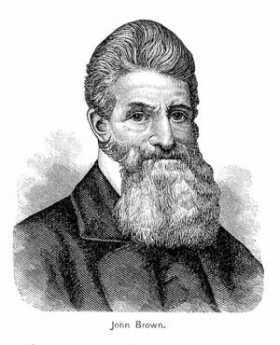
|
| John Brown |
For example, in 1859 John Brown's body was brought forth on the PWB railroad, precipitating a pro-Southern riot at the Broad and Prime Station. There was a second riot the following year.
During the Civil War itself, the PWB railroad was a major military transport, carrying military supplies and troops to the battles, and bringing the many wounded troops back home for treatment. Quite a large military hospital was built across Broad Street from the rail station. All in all, the corner of Broad and Prime was a major center of the war, and may well have been one of General Lee's objectives when he launched the invasion that got stopped at Gettysburg.

|
| B& O Railroad |
After the Civil War was over, attention was finally paid to the need for better North-South rail transport along the Eastern Seaboard. Up to that time, European investment had pushed American railroading in an East-West direction. The Baltimore and Ohio were aimed at the Mid-West, while the New York railroads aimed at Chicago and beyond. Local politics in the seaboard cities tended to keep the competitors from linking and thus potentially capturing trade between the manufacturing North and agrarian South.
The Philadelphia, Wilmington, and Baltimore was the key link in the series of mergers which created the dominant Pennsylvania Railroad. Bringing northern traffic in through North Philadelphia to the new 30th Street Station,
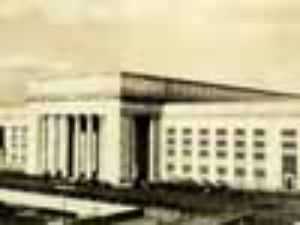
|
| 30th Station |
and then linking it to the stub of the P, W, BRR, the way was being paved for Ascella Express trains to shoot from Boston to Washington, perhaps eventually to Florida. The side-track from West Philadelphia to Broad and Washington was allowed to wither, and of course, the whole Camden and Amboy RR became scarcely more than a trolley line All that was left as a challenge to the Pennsy was to get past B and O obstructionism in Baltimore. This last step was finally accomplished with the discovery of some legal loopholes related to an existing right of way for a local commuter line in Baltimore, where permission for a branch line was broadly interpreted, and a surprise tunnel dug to link it up to the other parts of the Pennsy. Amtrak passengers nowadays usually move through the Baltimore tunnel systems without noticing them, but occasionally a train breaks down inside the tunnels. Then, they prove to be rather dark and damp as the passengers with their laptops are transferred to another train.
Northwest Rittenhouse Square
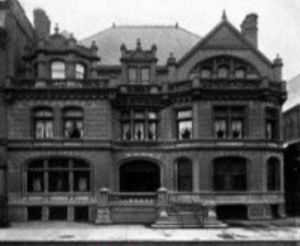
|
| {John Wanamaker's Mansion 2032 Walnut Street |
Market, Chestnut and Walnut Streets go right across the Schuylkill on bridges; that fact was once their glory, but now is the source of their problem. The first bridge to be built, at Market Street, was originally placed there in 1804. Placing your mansion on an important street makes you prominent, but if the street gets too busy, crowded and noisy you eventually wish you lived somewhere else. Air conditioning helps somewhat by allowing your windows to be closed all the time, but eventually, the increasing commercial value of the location gives you unwelcome neighbors. So right now the last few blocks of Chestnut and Walnut before you reach the river are pretty run down. Students from the Universities on the far side of the river make for street activity at night, but most of them head for the Eastern edge of Rittenhouse Square, where droves of them sit at sidewalk tables on a summer evening. Irreverent college kids refer to such a congregation as a meat market, but I'm only quoting them.
John Wanamaker had one of his many mansions just past the Square at 2032 Walnut, but it now is mostly an entrance to an apartment building towering above it. What now distinguishes this area most are the surviving churches.
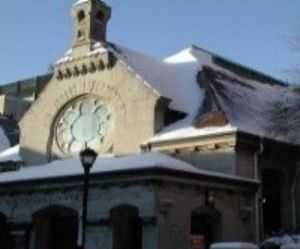
|
| Unitarian Church |
The Unitarian Church at 22nd and Chestnut is one of Frank Furness' finest buildings and next to it is a renovated former Church of the New Jerusalem (Swedenborgian Church), now used for an advertising agency. Frank Furness won the Medal of Honor during the Civil War before he thought much about architecture. Swedenborg, for his part, founded what is known as a thinking man's religion, since Emanuel Swedenborg (1688-1772) himself was a scientist of the first rank who might have won a Nobel Prize if there had been such a thing in his day. The Mother Church of this religion moved out to Bryn Athyn, abandoning the center city after what is reported to be a heated dispute. While the new cathedral is absolutely spectacular, the old one on Chestnut Street is still pretty fine, itself.
Across Chestnut Street is the Lutheran Church, which proves to be astonishingly large when you enter it, and it has great acoustical qualities related to the Moravian influences of the last century. Up at the NorthWest corner of Rittenhouse Square is Holy Trinity. Its minister, Phillips Brooks, wrote the words of the Christmas carol "O Little Town of Bethlehem", which are a poem of considerable merit and sophistication. Unfortunately, the need to adjust these words to music which children might single to the attachment of three different tunes of less than classic musical proportions, sometimes even less sonorous when sung simultaneously by adults who remember different tunes from their childhood. In view of the far from the peaceful scene of present-day Bethlehem, at least the message of the carol warrants recollection indeed. And, yes, the church is reddish brown in color, as most Episcopalian churches seem to be.
There once was a time when Anthony Drexel walked down Walnut Street to work every day. One can easily imagine him tipping his hat to passers-by, striding along in front of formerly elegant mansions which line the street but are now too big to maintain. This area was a place of show houses, of downtown places to hold parties during the social season, from thence fleeing to a second house in the suburbs, or in Maine, or in Europe, during the summer. The Great Depression of the 1930s forced most of these people to choose between their various residences, and because of the advent of the automobile, they mostly chose the other places, abandoning these. It was the end of the Gilded age.
For a tour of Rittenhouse Square, mentioned in this Reflection, visit Seven Tours Through Historic Philadelphia
Larger Clubs
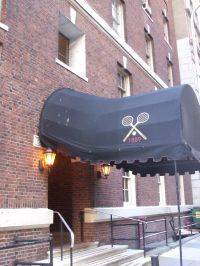
|
| The Racquet Club |
Philadelphia has dozens -- perhaps hundreds -- of clubs, societies, associations and organizations. Many owe their formation to the Sunday Blue Laws, which once made it illegal to obtain liquor on Sunday except on the premises of a private club. Some clubs were formed around the tradition that the stock exchanges (hence, the banks and brokerage houses) were open for business on Saturday mornings, leaving the financial community available for a long lunch, a drink afterward and a free afternoon in town. But primarily, Philadelphia already had a long tradition of fraternal and volunteer associations. Benjamin Franklin helped found a great many juntos, associations and volunteer groups for some civic purpose. Although he was not a Quaker, Franklin was in the Quaker tradition of forming voluntary committees and groups to get some particular job accomplished. In Quaker circles, aimless griping and complaining are not tolerated; if you have a "concern", you propose a solution which a committee can put into action, and you will probably be expected to be its chairman. The Quakers even had to devise a formula for "laying down" a committee when its purpose was completed, since, after a while, the original purpose of the club may disappear, but habit and good fellowship cause it to continue as a social club. A good example is a certain club which was originally founded for life-saving on the river, but now continues as an ice-skating club on the Main Line.
Anyway, clubs continue to be a center of Philadelphia life at the present time, often with founding traditions that are a little unclear to many of the members. It isn't as true as it was when the Sunday Blue laws were effective, or before the restaurant revolution overtook us, but to live in Philadelphia without being active in several clubs is to feel that nothing ever happens in this town, while your neighbors at the same time are so busy going to their clubs they never think to invite you. Or perhaps fear that since everyone goes to so many, you might feel pestered if they invited you to join.
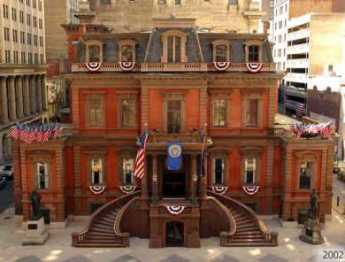
|
| Union League of Philadelphia |
There does exist a different sort of club entirely, however. The big-city in-town social club was started as a place to stay when transportation to the suburbs was tiresome, and large clusters of people had townhouses near the business district. A place to stay when your wife is visiting her relatives. A place for the local bachelors to congregate. A place where the CEOs can congregate fraternally, avoiding the isolation at work that comes from being the boss. A place where lawyers can have a long lunch while they wait for the phone to ring with the big case they can retire on. A place to loaf, play pool, get a haircut, get your shoes shined, play a game of squash. Or get a drink and a decent meal in comfortable surroundings. Jeff McFadden, the director of the Union League, describes these clubs as "day camps for adults".
Such clubs have had a hard time in recent decades. The ten-story Manufacturers and Bankers Club is now an office building, the prestigious Rittenhouse Club is shuttered, along with the Commerce Club, the Locust Club, and a dozen others. The most prestigious of all, the Philadelphia Club is in a decrepit neighborhood next to Broad Street, which it hopes will soon revive and make wrenching decisions unnecessary for the club. The interior is as close to an English city club as you could find, with immensely valuable paintings and furniture, creaking stairs and quaint bathrooms. You're not likely to find more than five members at lunch these days, but the food is excellent, the service superb, and the posted waiting list for membership quite comfortably long. The posted names tend to be a list of the cream of society, but most of them live thirty miles away. It's no longer possible to stay there overnight.
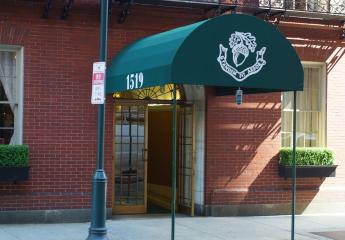
|
| The Acorn Club |
The Acorn Club is for women, quite frequently women whose husbands are members of the Philadelphia Club. If ever there were some political move to force the two clubs to abandon the men-only and women-only rules, a merger of the two would allow them to continue exactly as before as a single club with two facilities. The Acorn Club is just up Locust Street from the Academy of Music, and that is surely no accident. The place is immaculate, elegant, quiet, extremely well managed.
Around the corner on 16th Street is the architect Horace Trumbauer's turn-of-the-last-century Racquet Club. In some other city, it might be called the Athletic Club, which makes it more attractive to younger members than the other clubs, where billboards would be the extent of the exercise. Indoor swimming pools and gymnasia are extremely heavy and thus require expensive steel supports. This club not only has a pool, but it also has squash courts (both old-rule and new-rule), racquets courts (the thirty-foot walls are polished slate), and one of the five court tennis courts still in existence in the country. Court tennis is a strange game, of which it is said that "if you know the rules and own your own racquet, you are one of the top ten in the country". But the game originated in the Twelfth Century and was what people meant by "tennis" until 1878, when a game is known as "lawn tennis" was invented and took the world by storm. One of the other five court tennis courts is a few miles from the location of the hydrogen bomb factory on the Savannah River, eighty miles from Charleston. The DuPont Company put it there, and the location is no accident. > is having a hard time filling its space with members, but it would be so appallingly expensive to replace even a part of it, that superhuman efforts are justified to preserve it.
The Union League at Broad and Samson Streets, is the one outstanding exception to the decline of the center city men's club. When I joined it long ago, the strictest of rules prohibited women from any area except the women's dining room in the basement. I still remember the chairman of the admission committee, seated at the end of a long long table of gentlemen in the semi-darkness, intoning to me. "I'm going to ask you a question. And because I don't want any misunderstanding, I'm going to ask you twice. The question is, have you ever, even once, in any national, state or local election -- even once -- ever voted anything except straight Republican? Let me repeat, have you ever, even once. . . ?"
Well, the League lets in Democrats these days, and even quite a few women. But what has transformed the League from a declining relic into a thriving center of the Philadelphia social scene has been management. The League owns its own new parking garage across Samson Street from the side door, which is itself an innovation with a canopy. The dingy old members overnight rooms have been transformed into a four-star hotel, with concierge. The old steam rooms are now a modern exercise facility, and a dozen computers in the "business center" are always occupied. The menu has been upgraded, the service snappy instead of sleepy. The upstairs dining rooms usually have several hundred people for dinner when formerly they were deserted. Several times a year the League has an upscale dinner party for five hundred or so guests, that would be in a class with a reception for the King of England. Nobody any longer asks why they should be a member; they only ask whether they can afford it. Apparently, lots of people can, once they have a reason to.
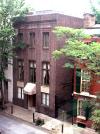
|
| Cosmopolitan Club of Philadelphia |
Over in a nearby short narrow street (we hesitate to call it an alley) near the Racquet Club, is the Cosmopolitan Club, for women only, thank you. It's small, probably would have trouble accommodating more than a hundred at a time, but the food and service are great. The real reason for the existence of this club is the wish of professional and working women to have a place to gather and support each other's morale, listen to uplifting speeches, help along with the younger ones and that sort of thing. In some ways, the Cosmopolitan Club is the most typical of all Philadelphia clubs.
Market at Schuylkill
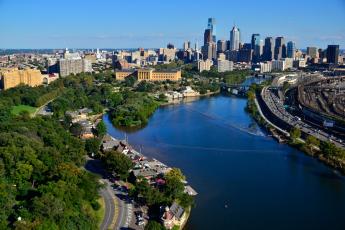
|
| Kelly Drive River Side |
Two columns of commercial high-rise office buildings are now advancing West on Market Street, although construction has halted for the moment because of economic recession. The last four or five blocks before you reach the Schuylkill are in a state of decay characteristic of real estate waiting for a developer.
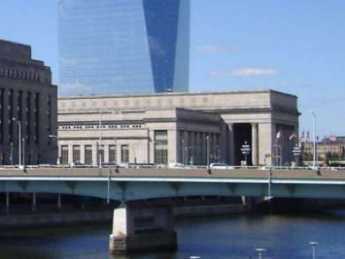
|
| river view 30th street |
Because the land rises to a summit around 22nd Street and then slopes off to the river, Market Street at this point becomes the approach to a bridge, and the buildings have their front doors considerably above the ground. One apartment building and a furniture design building (there's a very good restaurant inside) take advantage of the view over the river, which can be quite spectacular at night. Outdoor lighting at sundown suddenly emphasizes the impressive classical architecture of 30th Street Station, and the Art Museum on its acropolis.

|
| Pennsylvania Academy of Fine Arts |
But down at the bottom of the buildings, well below street level on the bridge approaches, is a pretty intimidating scene right out of some novel by Charles Dickens, with cobblestones, dark alleys, deserted parking lots, and dim street lights. This is the area of the former terminal of the Baltimore and Ohio Railroad . In its time, the Terminal building was an admired product of the imagination of Frank Furness(pronounce:"furnace"). It will be remembered that the Pennsylvania RR tracks run along the West bank, converting this lovely river into a depressing sight for several miles. The B&O was the first railroad in America, and for a while, the two railroads were booming competitors. Both railroads have of course gone through bankruptcies and mergers, their names are gone. It's even hard to say for sure who owns what is left of them.
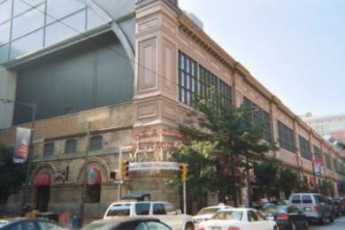
|
| Reading railroad |
Just about every railroad in America (the European ones are government subsidized) has been through bankruptcy, so the whole railway industry had a century of the boom but now has an uncertain future. The B & O at first only headed westward to Ohio, but then turned North to try for New York-Washington dominance by coming up the Schuylkill on its East side, going through a tunnel under the Acropolis that now holds the Art Museum, and then turned East along Race Street to join the Reading Railroad at 12th Street. The Reading had a North-South spur called the Trenton Cut-Off which was to be the trunk line for the combined East Coast railroad. Eventually, the Pennsylvania Railroad won this battle by avoiding acquisitions and using leased rights of way. Although it eventually became the dominant railroad of the country, Pennsylvania only owned the property between Philadelphia and Pittsburgh, leasing all the rest from about 70 partner lines; it proved a better business model than purchasing the trackage.
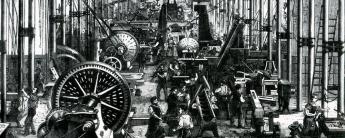
|
| Industrial Revolution |
This transportation frenzy had to reflect a major underlying economic upheaval. Two events propelled Philadelphia into the Lehigh and Delaware Rivers, and then the railroads brought it down along the Schuylkill, because the Lehigh River alternative was steep and rocky, filled with dangerous rapids.
The second economic event was the discovery of oil in upstate Pennsylvania. Almost all freight traffic on the great national railroads was going from East to West, so the trains returned East without much cargo. But the discovery of oil was soon followed by the construction of refineries in Philadelphia, creating the return traffic needed to put the Pennsylvania Railroad ahead of its competitors, especially the New York Central. Heavy rail traffic and smoking refineries create a wasteland around them, and that was the price Philadelphia paid for its boom.
For a tour of the area mentioned in this Reflection, visit Seven Tours Through Historic Philadelphia
The Center of Town
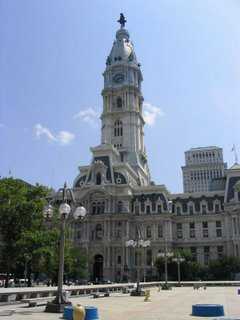
|
| city hall |
It took two hundred years for the inhabited part of the city to reach the square which William Penn had envisioned for the center of his green country town, and by the time it did, the area around City Hall had come to resemble the town planning concepts ordinarily associated with the Scotch-Irish immigrants.
It sort of goes like this: the Scotch-Irish had been kicked out of Scotland and they were soon kicked out of Ireland, so they were far less emotionally attached to their local soil than other European groups. So they were probably the first group to regard real estate as a commodity rather than a repository of wealth, or a religious shrine, as other groups often do. It soon became evident to them that the best real estate was usually found at the crossroads, and the more important the intersecting roads, the more valuable that real estate was going to be someday. Accordingly, early Scotch-Irish settlers roamed around their new country, looking for likely crossroads, and buying up the local property for speculation.
The pattern of the diamond appeared, with a town square placed at the crossroads, traffic diverted around the square, and commercial real estate established around the rim of the square which usually had a flagpole placed in the middle of the central park. New England had city centers and town commons, but the two were usually not the same thing. The diamond pattern is very characteristic of rural Pennsylvania, and up and down the Appalachian valleys where the Scotch Irish had spread. It is the pattern of Philadelphia City Hall Square, no matter whose idea it was originally. Let's face it. City Hall is at a crossroad of the two main traffic arteries, Broad and Market Streets, wide and straight, stretching for miles in each direction.
Ownership of the Port
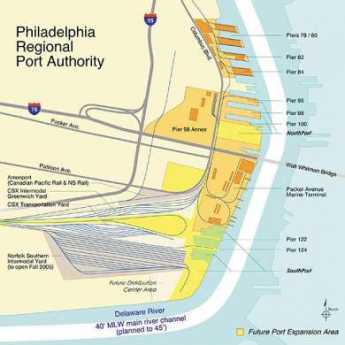
|
| Delaware Port |
One of my children studied for a graduate degree in Economics, and once remarked there only seemed to be one thing worth learning, namely Comparative Advantage. How's that, again, child? Free trade is good, dummy. By inference, tariffs and subsidies of local industries are a bad thing. All this talk about losing jobs to China is misguided, holds back world prosperity. If that's the case, Child, then why is the Philadelphia port run the way it is? Because Philadelphia is in a life struggle with other ports, and they all run the same way.
There are 23,000 people working in and around Philadelphia port, almost all of them paid wages that are a little surprising to hear. If you include such things as worker's compensation, the wage cost of a Philadelphia longshoreman is about fifty dollars an hour. With such a wage cost, the port cannot compete with other ports, particularly when you see how easily a shipping line can unload the ship elsewhere, with lower wage costs. The consequence is that no private company can afford to own and operate a marine cargo terminal. In our case, they are owned by the Philadelphia Regional Port Authority, which is indirectly to say they are owned by the State of Pennsylvania. The regional port authority has a $300 million annual budget, owns eight terminals, loses money, and is taxpayer subsidized. If you skip all the intermediate steps, the taxpayers of the state subsidize the port workers. In return, the rest of the state gets its Cocoa and steel shipped. What Philadelphia gets is union domination of its politics.
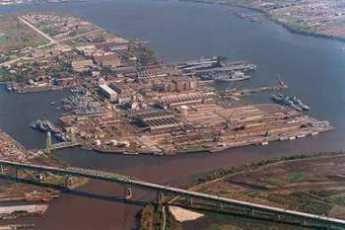
|
| Ship Yard |
It's easy to be too glib about all this. Billions of dollars have been invested in the transportation infrastructure and distribution organization, organized around this particular structure. Furthermore, many billions more have been invested in the industries which are based on the assumption that this distribution system will serve them. Philadelphia has the port, but a vast region depends on it and will react swiftly if changes are made too precipitously. There really does seem to be a need for the Foundations and Universities to support some useful studies about what direction the region ought to take, however slowly we move to get there. At the least, we could give some serious thought to the wisdom of going further in the direction we are going.
Finger Piers are a thing of the past and must be replaced by container cargo terminals, we are now told. Should we really spend the billions of dollars it would take to make this change? It would obviously be unprofitable for some private corporation to undertake this effort, so what can we do to make it profitable?
The natural depth of the river channel is 17 feet and needs to be dredged to 40 feet to accommodate the container ships, which we're told carry more profitable cargo than bulk carriers. We are also told this is being blocked by the New Jersey government, responding to competitive pressure from Northern New Jersey interests who want the cargo to go to Hudson River terminals. Presumably, this is a sign that New Jersey and New York are subsidizing their ports, too, and we are in a bidding war.
Thank goodness for the Constitution, which discourages shooting wars between the states.
Market Street, East (1)
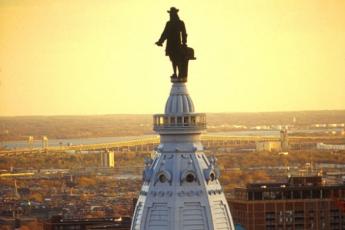
|
| City Hall |
The central keel of the city, Market Street, must be considered in three quite different sections, East and West of City Hall, and West of the Schuylkill River. The street was once called High Street, and the name was slow to change. It will be enough, for now, to consider only the oldest section of fourteen blocks from City Hall to the Delaware River, which is almost a lesson in archeology. Start at Victorian City Hall and face East to Penn's landing on the Delaware.
William Penn had laid out the city plan like a cross, with Market and Broad Streets intersecting at the green central park which now holds the massive building with his statue on top of the tower. The market was originally called High Street. It's doubtful that Penn intended his statue to be there, since the early Quakers were so scornful of vainglorious display that they prohibited the naming of streets after persons, declined to have their portraits painted, and the strictest ones would not even consent to their names on their tombstones. The cult of personality in dictatorships like the Soviet Union, Maoist China, and Baptist Iraq more recently illustrate the sort of thing they probably had in mind, and it wasn't just a quaint idea to discourage the portraits of leaders in public places.
For a tour of the area mentioned in this Reflection, visit Seven Tours Through Historic Philadelphia
Canada's Southern Seaport
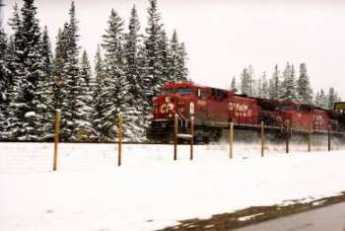
|
| Global Warming, soon? |
When American railroading fell apart in 1970, the remnants were gathered into a financially failing passenger network, Amtrak, and in 1974 a prospering freight division, Conrail. Although prosperous enough, Conrail has remained largely invisible to the urban public, often moving trains only at night so the tracks could be used for passengers during the day. When Conrail got efficient enough, it was sold off in pieces, then largely disappeared from public attention. But Philadelphia had ended up with two freight railroads owned by Canadians displaying a great deal of imagination and vigor, investing huge amounts of money in the transportation revolution which includes container cargo and automated handling methods. And which does its best to avoid featherbedding unions, longshore pilferage, damage suits, inflated Workman's Compensation costs, and crooked politicians. All of these man-made obstacles to the efficiency of course hotly deny they were responsible for the wreck of the railroads, but now that they have been tamed, the recent recovery in the transportation industry suggests these factors really must have had a lot to do with creating the problems. Of course, the fundamental difficulty was railroad overbuilding during their long period of a transportation monopoly. A measured description would be that union intransigence did not exactly cause the bankruptcies, but resisted correcting it until bankruptcy was the only way out. The underlying disruption was the massive oversupply of rail transport created by highway and airline competition. There might have been other less destructive ways for the railroads to downsize gradually, but bankruptcy courts could at least set aside union work rules without paralyzing the rest of the country. In retrospect, the depression of the 1930s, World War II and the Korean War also contributed considerably to wasting time needed to reorganize railroad oversupply gracefully. And finally, it is very difficult to convince people of something they don't want to believe. The union leadership exaggerated but probably did believe much of their own rhetoric about fairness and management incompetence and greed. The bankruptcy did not settle those assertions at all. What it did settle was that excessive labor costs had indeed been ruinous, and that relief from them did indeed permit a remarkable rebound of profitability and efficiency under largely the same managers who had previously seemed so woebegone.
During all the strife and turmoil, no one thought very much about Canada, but now Canada seems a big part of our transportation future. Philadelphia discovered it had ended up with, not one but two Canadian rail systems. Freight trains now run almost exclusively at night so most Philadelphians would deny it if asked. Philadelphia's local labor and political problems have seemed to improve enough to persuade Canadian shippers to send what is currently 25% of the port's cargo through our system. So nowadays when Canadians come to town with big plans, a chastened city government is eager to appear helpful. The situation is greatly helped by the Canadian dollar currently trading at 88 American cents, and by having almost twenty non-stop flights to Canadian destinations originating daily at Philadelphia International Airport.
The first thing to notice is that the Canadians are eager to promote the deepening of the river, and have apparently been able to apply some useful pressure to the main opponents of Delaware port deepening, in the New Jersey legislature. The Canadians seem to be toying with two major ideas. They have considered making Philadelphia into Canada's Atlantic port, as the eastern terminus of a freight link from Philadelphia to Vancouver on the Pacific Ocean. It would seem that container ships are getting longer and fatter, making it more attractive to deepen the Delaware than widen the Panama Canal. And quicker, possibly even cheaper, to ship from Rotterdam to Yokohama by way of Marcus Hook, with portage service from Philadelphia to Vancouver.
Well, that's one idea, maybe not a likely one. A more modest idea is to make Philadelphia into Canada's southern port, with cargo going from Philadelphia to Kingston, Ontario. That's at the western end of the St. Lawrence River, and the eastern end of the Great Lakes. In all planning about cargo transportation, the vital issue is to have some cargo for the return voyage to keep trains and ships busy in both directions of a round trip. A busy freight-forwarding operation between Philadelphia and Kingston could gather cargo coming in along the St. Lawrence, plus the other, Midwest, direction, exchanging it for cargo going to South America and Africa -- by way of Philadelphia. Bigger visions of huge container ships coming up Delaware from India, sending cargo to Hong Kong by way of Ontario, could possibly be considered in the future if basic infrastructure is created for shorter traffic runs.
The whole thing brings back some history of the American Revolution. Times have changed, but geography is the same. If you extend Broad Street due north for four hundred miles, you come pretty close to Kingston, Ontario. That's at the western end of the Thousand Islands, a peculiar collection of channels and islands at the junction of Lake Ontario and the St. Lawrence River. Right now, Kingston thrives on charming summer vacationers, particularly those who like boating, fishing and sailing.
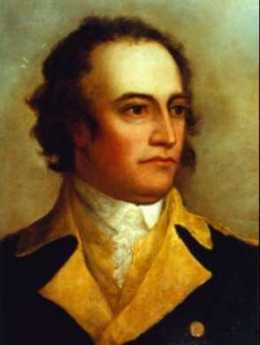
|
| General John Sullivan |
But at least half of the families in Kingston are said to have Philadelphia connections. If you go back to 1775 when war clouds were gathering, a lot of Philadelphians were royalists, and many more were pacifist Quakers. When revolutionary rioting and intimidation started to get serious, a great many British sympathizers packed up their goods and traveled out Ridge Avenue to Plymouth Meeting. From there they either went along the upper Delaware River or else followed what is essentially the Northeast Extension of the Pennsylvania Turnpike. Up to the East Branch of the Susquehanna River to Binghamton, and across New York State to Kingston. That was Iroquois territory, with hostile French-speaking Indians to the west and friendly English-speaking Indians to the east (the Revolutionaries perceived the friendliness reversed), and the trip for the exiles must not have been completely care-free. Later on, this area was to be the scene of many "Indian" massacres, egged on by both sides of the revolution, and was on the edge of the eventually decisive battle of Saratoga. In 1777, George Washington dispatched General John Sullivan from Valley Forge to conquer the Iroquois, which Sullivan eventually did by burning crops and villages, essentially starving the Iroquois into near-extinction. When the Philadelphia Tories settled down at Kingston they intended just to hide out for the duration of the war, but events made it unsafe to return for many years, and the War of 1812 (largely fought in this area) finally made them realize they were Canadians permanently. Indeed, it was the Philadelphia-Kingston settlers who prompted the creation of the Canadian nation.
These families retained many relatives in Philadelphia, however, and a good many contested property claims. Vacationing created another reason to maintain connections between the two areas, and the affinities have remained strong. Meanwhile, immigration from non-Caucasian countries of the British Commonwealth has made Canada far less British than it once seemed, while anti-British sentiment in Philadelphia is now hard to find. With these strange connections and even stranger historical quirks, the sentiment in Canada to rejoin America is clearly growing. It's only a fireside chat, at the moment, but it's a movement worthy of a little noticing.
If you would like to review this backwoods trail of tears, fire up Google Earth and put Philadelphia as the origin and Kingston Ontario as the destination under the Directions tab. Then push the triangular button called Play Tour (under Places), and sit back for a fifteen-minute travelogue of the journey, as presently viewable at a virtual height of a mile. The trip over the Lehigh tunnel is particularly exciting.
A curious footnote to the curious friction between Philadelphia and Boston, old towns so alike in many other ways, seems somehow related to this episode. Pennsylvanians had trouble understanding why the New Englanders were so upset at the British; what was the problem at Lexington and Concord, anyway? The story of the Continental Congress was largely one of New England trying to get the rest of the colonies to help them fight the British. But only twenty-odd years later, New England was seriously considering secession from America rather than fight the British in the War of 1812. Several generations still later, the descendants of Philadelphia loyalists in Kingston have trouble explaining all this, but suspicion remains that the ancient affinity between Philadelphia and Kingston has something to do with it.
Chinese Canyons
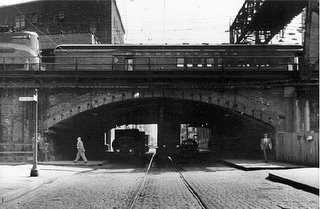
|
| Chinese Wall |
Until well after the Second World War, the entire western side of city hall was facing the Pennsylvania RailRoad . An enormous rambling smoke-stained Broad Street Station squatted right across the street, and westward behind it to 30th Station stretched -- the Chinese Wall. The railroad tracks were elevated forty feet above street level, resting on top of a very wide brick wall with openings at each cross street allowing traffic to go under the tracks. It was dark, dirty, gloomy and hard to ignore, and the tunnels at each cross street were even darker. They had a tendency to drip water on the sidewalks. Whether these tunnels were a place for crime to take place is not certain, but it looked as though that would be true since an army of panhandlers and stumble-bums reinforced the impression by keeping out of the rain under there.
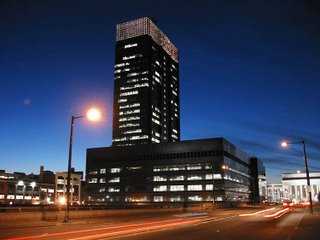
|
| JFK BLVD |
Consequently, the two streets which paralleled the Chinese Wall (Market Street, West, and Pennsylvania Avenue) were lined with dubious structures housing questionable businesses. After the War, Broad Street Station was torn down, the Chinese Wall of train tracks was removed, and it suddenly became clear that City Hall was now approached by two wide boulevards stretching west, with the handsome classical 30th Street Station framed in the center of one of them, renamed JFK BLVD. High rise buildings were built in large numbers along both sides of the two boulevards in what now are four parallel rows, twelve blocks long. Because these buildings were put up under the gentleman's agreement that City Hall would be the height limit, Philadelphia avoided the dark canyon effect so depressingly present in the Wall Street financial district of New York City. However, the two boulevards do not escape the Marilyn Monroe effect.
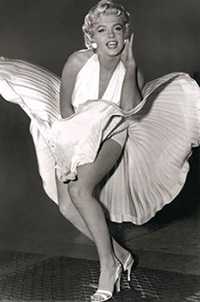
|
| Marilyn Monroe skirts |
Named after a famous movie scene in which that actress had her skirts blown upward in public, the phenomenon usually has to be explained to newcomers. Winds blowing against the tall face of the buildings are blocked and scoot down to the sidewalk along the side of the buildings. When they reach the ground they have no direction to go but up again. Billowing skirts are in reality not particularly noticeable, but these two stretches of the street usually are windy, and in mid-winter, it is bitterly uncomfortable to walk there. Because rentals are high, these new high-rise buildings are too expensive for the small stores and merchants to set up their shops on the first floor, so almost no one is on the street except those in a hurry to get somewhere else. After five o'clock, these commercial centers are totally deserted and quite forbidding.
One response has been to go underground. The Market Street subway goes underground the whole length of Market West, paralleled by a "subway-surface line", which is to say, trolley cars. So it has seemed natural to tunnel pedestrian walkways along with the basement level of Market Street, and little shops have tended to find a place there, although when commuter traffic declines, they turn out the lights and pull down the steel shutters. It's a nice place to duck out of the rain (and wind), but Philadelphia isn't Montreal or Minneapolis, with tons of snow to drive people underground. Long before the 9/11 tragedy, Wall Street's financial district was deserted at night, too, so this is a generic problem of skyscraper districts, waiting for somebody to suggest a solution. In a way, New York's Park Avenue suggests that when you are moving railroads underground in a city, apartment houses may make for a better new neighborhood than office buildings do.
But such reflections are part of what is called Philadelphia's inferiority complex. Let's face it, the renovation of the Market Street West project is a vast, vast improvement over the mess that was there for a century. It's a success, right?
North of Market
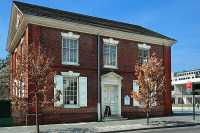
|
| Free Quaker Meeting House |
In their 1956 book "Philadelphia Scapple", Harold Donaldson Eberlein and Mrs. Henry Cadwalader give an interesting description of the evolution of the term "North of Market". In the early days of the city, almost all of the town was South of Market Street. In fact, an early 18th Century visitor once wrote that he always brought a fowling piece when he visited Philadelphia because the duck hunting was so good at the pond located at what is now 5th and Market.
When the Quaker meeting house was built at 4th and Arch Streets, many of the more important Quaker families thought it was important to build their houses nearby. In that way, Arch Street developed the reputation of being a Quaker Street. So the original meaning of the North of Market term was the Quaker ghetto. Quaker families continued to spread West along Arch Street or nearby, and this accounts for the location of the Friends Center at 15th and Cherry and related local activities. When the Free Quaker were evicted from the meeting at 4th and Arch because of their activities during the Revolution, they built their own meeting at -- 5th and Arch.
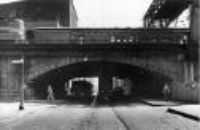
|
| Chinese wall |
During the Civil War, a number of people made fortunes that socially upscale people over in the Rittenhouse Square area considered disreputable, so elaborate but ostracized mansions marched due North up Broad Street, where they can still be observed as stranded whales in the slums, leaders without followers. The show houses of manufacturers of shoddy war goods soon gave the meaning of parvenu to the term North of Market.
And then, the Pennsylvania Railroad ran an elevated brick structure from 30th Street to City Hall Plaza, the so-called Chinese Wall. For nearly a century this ugly looming structure on Pennsylvania Boulevard, now John Kennedy Boulevard, with its smoky engines above, and dark dripping tunnels at street level, sliced the town in half and made it very unattractive to build or to live, North of Market. The Spring Garden area had some pretty large and expensive houses, but it was cut off by the railroad trestle and has only recently started to revive. It helped a lot to tear down the Chinese Wall, but that was fifty years ago, and the area has taken a long time to recover from the earlier diversion of social flow to the South of it. And, psychologically, North of Market will take even longer to recover from the implication of -- industrial slum.
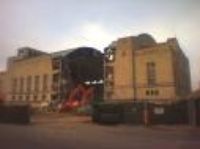
|
| center |
Meanwhile, of course, Oriental immigration settled along Arch Street at 9th to 12th Streets, and we now have our Chinatown there, complete with street signs in oriental lettering. In effect, we have a real Chinese Wall, a social one. Just what will happen to this group is unclear, since it is readily observable that they like to cluster together, unlike the East Indian immigrants, who head for the suburbs as fast as they can. Since the Chinese colony is physically blocked on all sides by the Vine Street Expressway, the Convention Center, and the Ben Franklin Bridge, it is hard to know where they will flow if the group gets much larger. The depressed Vine Street crosstown expressway makes a definitive border for downtown, and the contrast between the two sides of this expressway is striking. On one side is Camelot, and on the other side, almost nothing is being built. The future of North of Market, at the moment, is a little unclear.
Armonica, Momentarily Mesmerizing
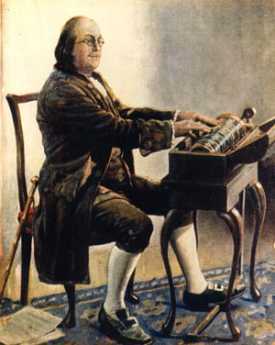
|
| Ben Franklin's Glass Armonica |
Everyone knows Ben Franklin spent a lot of time holding a wine glass. Evidently, he noticed a musical note emerges if you run your finger around the open mouth of the drinking glass, and systematically studied how the tone can be varied by varying the level of liquid in the glass. The same variation in emitted tone relates to variations in the thickness of the glass. So, he set up a series of different sized glasses impaled on a horizontal broomstick, enough to cover three octaves, rotated the broomstick with a treadle like those used for spinning wheels -- and made music. The tone has a haunting penetration to it, which induced both Beethoven and Mozart to write special compositions for the harmonica, and the Eighteenth Century went wild with enthusiasm.
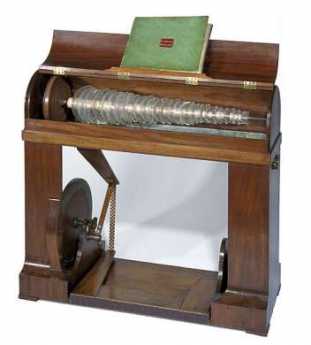
|
| Glass Armonica |
Unfortunately, a number of the young ladies who played the armonica went mad. We now recognize that since the finest crystal glass was used, with very high lead content, the mad ladies were suffering from lead poisoning after repeatedly wetting their fingers on their tongues. As a matter of fact, port wine at that time was stored in lead-lined casks, resulting in the same unfortunate consequences, which included stirring up attacks of gout. Franklin himself was a famous sufferer from gout, which was more likely related to the port wine than playing the harmonica, in his particular case.
Anyway, the reputation for inducing madness added to the spooky sort of sound the instrument made, attracting the attention of a montebank named Franz Anton Mesmer, who falsely claimed to be the father of hypnotism. Mesmer enhanced the society of his stage performances by hypnotizing subjects while an assistant played the harmonica, meanwhile relating all sorts of wild tales about animal magnetism. This was pretty sensational at the time until a young man in an audience suddenly died. It is now speculated that the victim probably had an epileptic seizure, but the news of this public fatal event pretty well finished Mesmer as an evangelist and the harmonica as a musical instrument.
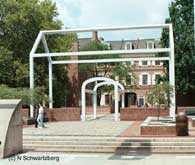
|
| Franklin Court |
There's a replica of an armonica on display in the Franklin Court Museum around 3rd and Chestnut, which we are vigorously assured is not made with leaded crystal glass. The Park Rangers put on two daily performances by request, at noon, and 2:30 PM.
Wall Art in Philadelphia
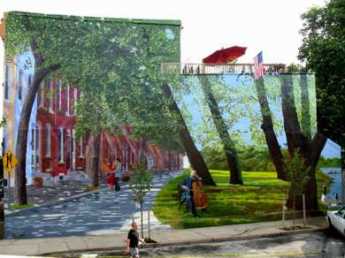
|
| Seasons |
At last count, Mural Arts program of the city government of Philadelphia has sponsored and paid for 2700 large paintings on the walls of buildings around town, and several hundred more have appeared spontaneously. Comparatively few art museums have that many on display, so people are proud of the Philadelphia effort.
This program is now nearly thirty years old, beginning to emerge as a national treasure. Looking back, it is pleasing that it had humble, even deplorable, origins. As American cities lost their industrial focus, many homes in the neighborhood of former factories have been abandoned, getting torn down in random patterns. Industrial cities of the East Coast were tightly packed to save land costs and time commuting to work; the fashion of "row houses" evolved without any space between neighbors sharing a "party" wall. When a row house was torn down, there emerged a scabrous ghost, because the wallpapered interior walls were exposed and looked pretty hideous. It eventually became illegal to leave a scabrous building, leading to elaborate legal conventions about responsibility for the cost of covering exposed surfaces with concrete stucco. During the last half of the Twentieth Century, stucco was generally an improvement.
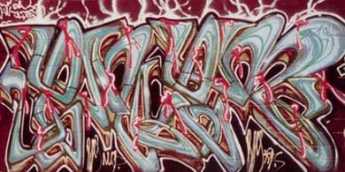
|
| Graffitti |
Meanwhile, during World War II it became clever for American military to inscribe "Kilroy was here" on unprotected public surfaces at home and abroad as a gesture of American triumphalism. Opinions differ about whether this started originally as an allusion to a certain line of 19th Century romance poetry, or whether there was in fact a John J. Kilroy, inspector of riveting in wartime shipyards, marking riveted materials with his name to enable piecework payment for shipyard tasks. Eventually, this Kilroy joke became a little tiresome, but soon was replaced by stylized decorations using cans of spray paint, until "graffiti" painting, in turn, became a public nuisance. It is true some graffiti artists were quite talented, but the associated vandalism of teenagers added a threatening quality to public defacement of property belonging to others. By implication, an area with graffiti was a home of lawlessness and that implication cast a negative shadow on the city economy. Public opinion demanded something effective be done to stop it.
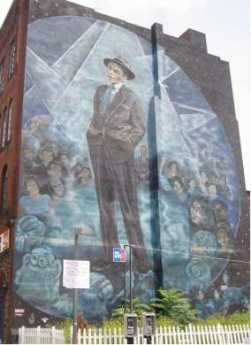
|
| Frank Sintra |
Since graffiti vandalism has declined nationwide in the past twenty years, it is difficult to claim that one public initiative in Philadelphia cleaned it up. But it might be true. Then-Mayor Wilson Goode formed an antigraffiti Network, essentially a think tank for concerned citizens, floundering about for a solution to an appalling problem. Somehow the inspired idea arose that the graffiti artists might be channeled into better directions if given professional art lessons, and working materials. A West-Coast artist named Jane Golden was hired to supervise what has become a multimillion-dollar project, overseen by some sort of guiding hand pushing the whole city into becoming part of a gigantic art project. Guides tell visitors that there are fifty employees involved in publicity and legal work, organizing artists, fundraising, organizing teams of painters at all levels of competence, helping oversee the general appropriateness of what is happening. And at the head of this team is Jane, a tornado of energy.
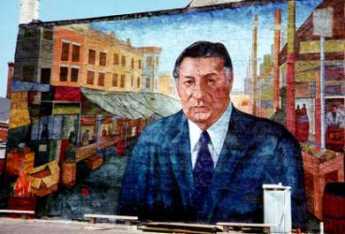
|
| Frank Rizzo |
It costs forty to seventy thousand dollars to produce one of these works, and since they are exposed to the weather, they only last about fifteen years. There are several techniques for transforming a small artwork into a big outdoor copy, some of them tracing back to Michaelangelo. Most of the Philadelphia murals are produced by dividing the original small artwork into squares and transferring numbered squares to the wall, one inch to one foot. As you can see by reviewing some of the websites devoted to the topic, a piece of art which is quite appealing can sometimes change into a drab mess when its size is blown up to three-story height. The problems of lighting such work are quite different from the lighting of a gallery painting. The surface is seldom smooth, so the bumps and grooves of the underlying scabrous "canvas" can destroy, or sometimes dramatically enhance, a salon painting. If you get too close, you can't see all of it, and that may be a problem. It's probably not entirely predictable what will come out in the final product.
There are inevitably political problems as well. The best examples are the several paintings of former Mayor Frank Rizzo, who is a hero to the Italian neighborhoods where they stand, but provoke riotous feelings in near-by black districts. Luck alone has confined the antagonisms to graffiti on the murals, viewed by some groups as enhancements on what begins as graffiti. No wonder the committees assigned to approving locations can take a long time to come to a decision.
There's another problem, which seems to be embedded in the situation. In the central city skyscraper district, you don't have scabrous buildings. Nor can mural art be placed in the historic square mile. Just a few blocks in either direction from central city there are plenty of demolitions and scabrous walls, but, close to downtown, these are areas of gentrification and urban renewal. It doesn't make sense to spend fifty thousand dollars to paint a wall which will be demolished in two or three years. The net effect is that the city may have three thousand paintings all right, but only fifty at most are within a tourist ride of Independence Visitors Center. If half of these fifty are concerned with celebrating local heroes unfamiliar to tourists, there can be disappointment which would disappear if a selection of fifty outstanding products could be culled from three thousand -- and grouped together for exhibition.
A solution to these issues will surely emerge with time, but it will evolve, not be envisioned.
| Posted by: Mike Curtis | Apr 20, 2010 1:41 PM |
| Posted by: Lindy Wardell | Mar 14, 2010 1:26 PM |
| Posted by: marie | Mar 1, 2010 5:50 PM |
| Posted by: quason million | Sep 2, 2009 2:12 PM |
| Posted by: lauren | Apr 23, 2009 6:56 PM |
| Posted by: carol | Mar 17, 2009 8:47 AM |
You can't see a city's skyline from within the city, so having a low limit really enhances the views of the few tall things, like the Washington monument.
| Posted by: Seth | May 14, 2007 2:54 PM |
66 Blogs
West Fairmount Park
 Fairmount Park, west of the river, is the largest part. The 1876 Centennial was held there.
Fairmount Park, west of the river, is the largest part. The 1876 Centennial was held there.
Fair Mount
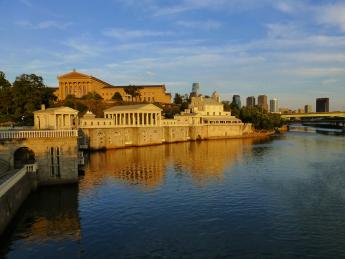 Philadelphia's acropolis is Faire Mount, where the Art Museum marks the entrance to Fairmount Park. Stretching beyond is Boathouse Row and its rowing races. When the azaleas are in bloom, it's the match of any place in the world.
Philadelphia's acropolis is Faire Mount, where the Art Museum marks the entrance to Fairmount Park. Stretching beyond is Boathouse Row and its rowing races. When the azaleas are in bloom, it's the match of any place in the world.
Widener, Stotesbury, and Trumbauer
 The Philadelphia Racquet Club on 16th Street is a notable engineering and architectural achievement.
The Philadelphia Racquet Club on 16th Street is a notable engineering and architectural achievement.
Market Street, East (2)
East Market Street was once the mercantile capital of the nation.
Market Street, East (3)
 Philadelphia built a White House for George Washington at Ninth and Market, a block from the place Franklin once flew his kite.
Philadelphia built a White House for George Washington at Ninth and Market, a block from the place Franklin once flew his kite.
Free Quaker Meetinghouse
 It's only open a few days each year, but the red brick building at 5th and Arch was the meeting house for those few Quakers, including Betsy Ross, who fought for the Revolution. The Park Service has made a beautiful restoration, which deserves to be seen by more people.
It's only open a few days each year, but the red brick building at 5th and Arch was the meeting house for those few Quakers, including Betsy Ross, who fought for the Revolution. The Park Service has made a beautiful restoration, which deserves to be seen by more people.
Benjamin Franklin Parkway (2)
 Parthenon-like Art Museum at the other.
Parthenon-like Art Museum at the other.
Albert C. Barnes, M.D.
 Impressionist paintings grew more valuable, faster than the patron's endowment for their maintenance.
Impressionist paintings grew more valuable, faster than the patron's endowment for their maintenance.
American Philosophical Society
 Charles Dickens Doesn't Like Our Nice Penitentiary
Charles Dickens Doesn't Like Our Nice Penitentiary
As an author, Dickens was paid by the word. He did go on a bit about Eastern Penitentiary, with its novel Quaker method for rehabilitating prisoners.
Riverline: Camden and Amboy Revival
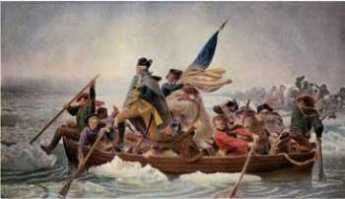 One of the oldest rail lines in America is coming back to life, and maybe bringing the towns along with it back to life, too.
One of the oldest rail lines in America is coming back to life, and maybe bringing the towns along with it back to life, too.
River City
 When you get down to it, Philadelphia is located at the junction of two major rivers.
When you get down to it, Philadelphia is located at the junction of two major rivers.
Battleship New Jersey: Home is the Sailor
 The battleship New Jersey, mightiest dreadnought in our history, now rests in Camden. At one time, it could have blown up Valley Forge without moving from that position.
The battleship New Jersey, mightiest dreadnought in our history, now rests in Camden. At one time, it could have blown up Valley Forge without moving from that position.
Encampment At East Falls
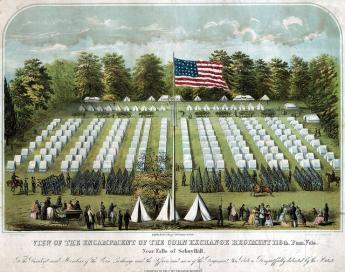 To follow the story chronologically, however, we must first follow Washington to Moland House in Bucks County, after the first East Falls encampment.
To follow the story chronologically, however, we must first follow Washington to Moland House in Bucks County, after the first East Falls encampment.
Germantown After 1730
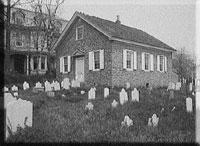 Germantown became the spiritual and intellectual capital of German America as immigrant farmers passed through on the way to better farmland. When Benjamin Chew built his mansion there, it became an affluent suburb as well.
Germantown became the spiritual and intellectual capital of German America as immigrant farmers passed through on the way to better farmland. When Benjamin Chew built his mansion there, it became an affluent suburb as well.
Rubberneck Tours of Philadelphia (1)
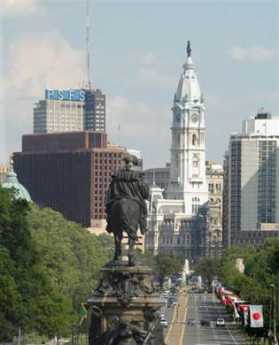 A very enjoyable two-hour drive, up to one side of the Schuylkill and down the other, encircles dozens of points of interest. Even if you don't know and don't care that this area was once the training ground for most of the Union Army.
A very enjoyable two-hour drive, up to one side of the Schuylkill and down the other, encircles dozens of points of interest. Even if you don't know and don't care that this area was once the training ground for most of the Union Army.
Billy Penn's Hat
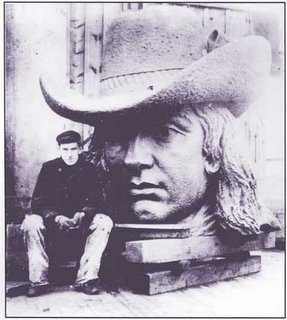 There was a gentleman's agreement not to build higher than the top of City Hall, but business is business.
There was a gentleman's agreement not to build higher than the top of City Hall, but business is business.
The Houses in the Park
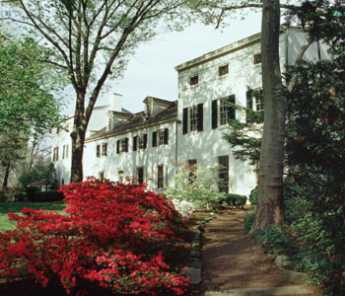 William Penn intended his city to stretch from river to river, with the gentry living in mansions along the Schuylkill. Briefly, it was so; the mansions are on display in Fairmount Park.
William Penn intended his city to stretch from river to river, with the gentry living in mansions along the Schuylkill. Briefly, it was so; the mansions are on display in Fairmount Park.
John Bartram's Garden
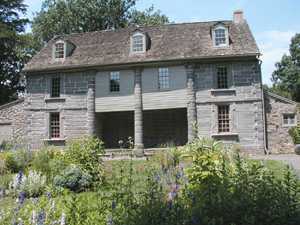 Bartram's farm dates back to the earliest days of Philadelphia, and it's still much the same farm, right in the midst of urban.
Bartram's farm dates back to the earliest days of Philadelphia, and it's still much the same farm, right in the midst of urban.
Mrs. Meade's House
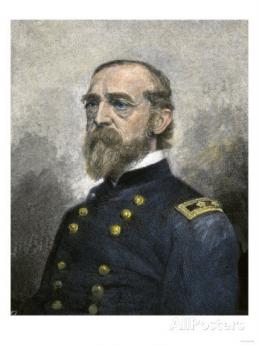 The grateful city fathers wanted to give General Meade a mansion out of gratitude for winning at Gettysburg. The General refused, but he hadn't asked his wife.
The grateful city fathers wanted to give General Meade a mansion out of gratitude for winning at Gettysburg. The General refused, but he hadn't asked his wife.
Philadelphia Gardens
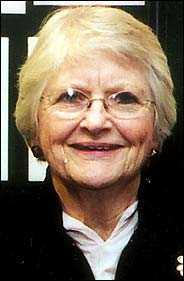 Philadelphia loves its gardens, particularly boxwood and azalea.
Philadelphia loves its gardens, particularly boxwood and azalea.
Stephen Girard and Religion
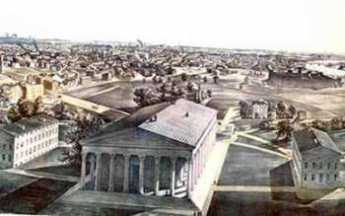 The great philanthropist was, to say the least, anti-clerical. A real-life story tells how far this was carried.
The great philanthropist was, to say the least, anti-clerical. A real-life story tells how far this was carried.
Shrine of Historical Restoration
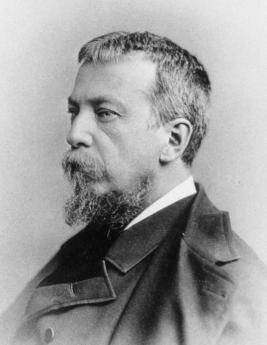 Charles Peterson sparked the restoration of Society Hill. In the course of fixing old houses the preservationist found a lot of things for a museum of professionally documented old house parts which now set standards for authentic colonial restoration everywhere in the country.
Charles Peterson sparked the restoration of Society Hill. In the course of fixing old houses the preservationist found a lot of things for a museum of professionally documented old house parts which now set standards for authentic colonial restoration everywhere in the country.
Washington Lurks in Bucks County, Waiting for Howe to Make a Move
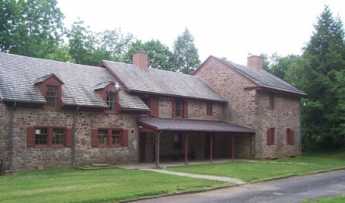 Washington, LaFayette, and twenty-seven other famous heroes of the Revolution spent a week in this Bucks County farmhouse, waiting for the British to make a move. Washington had a bottle of Madeira every day for lunch, but Mrs. Moland made him sleep on the floor, and pay for cleaning up when they left.
Washington, LaFayette, and twenty-seven other famous heroes of the Revolution spent a week in this Bucks County farmhouse, waiting for the British to make a move. Washington had a bottle of Madeira every day for lunch, but Mrs. Moland made him sleep on the floor, and pay for cleaning up when they left.
New Phillies Stadium
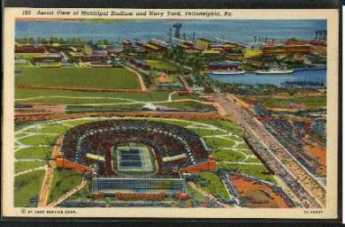 Philadelphia builds professional sports stadia, like crazy.
Philadelphia builds professional sports stadia, like crazy.
Home of the U.S. Naval Academy
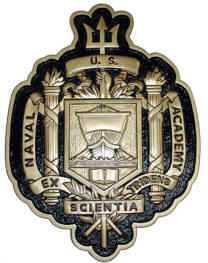 The Naval Acadamy now in Annapolis originally was on Gray's Ferry Avenue. It's still a handsome building, in some danger of destruction by real estate developers.
The Naval Acadamy now in Annapolis originally was on Gray's Ferry Avenue. It's still a handsome building, in some danger of destruction by real estate developers.
Gardens for Posterity
 New flowers can be planted each year, but forests take generations to grow. What you plant depends on who is meant to look at the result.
New flowers can be planted each year, but forests take generations to grow. What you plant depends on who is meant to look at the result.
Henry Mercer's Rathskeller
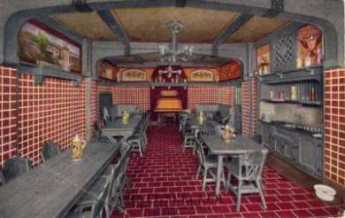
Benjamin Franklin Parkway (1)
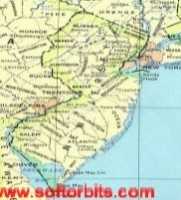 The slash of a diagonal boulevard across Philadelphia's rectangular street pattern took a long time to heal. But if traffic remains reasonable, it's becoming a museum paradise.
The slash of a diagonal boulevard across Philadelphia's rectangular street pattern took a long time to heal. But if traffic remains reasonable, it's becoming a museum paradise.
Religion at Girard College:Spiritual But Irreligious
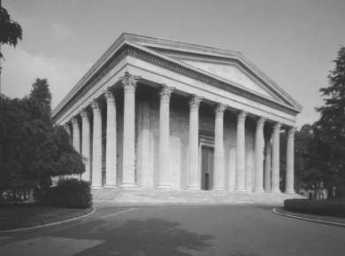 In his will, Stephen Girard famously banished all clergymen from the grounds of his school for orphans, even as visitors. Nevertheless, the school's atmosphere is a highly ethical, even religious, one. Many graduates have become ministers.
In his will, Stephen Girard famously banished all clergymen from the grounds of his school for orphans, even as visitors. Nevertheless, the school's atmosphere is a highly ethical, even religious, one. Many graduates have become ministers.
Skating and Humane
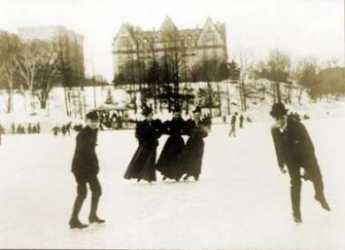 America's premier indoor skating club had its origin as a life-saving association.
America's premier indoor skating club had its origin as a life-saving association.
The First and Oldest Hospital in America
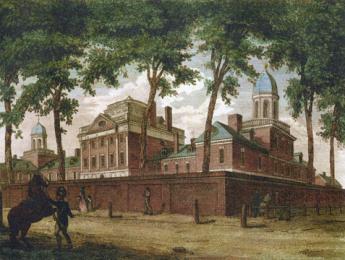 The history of American medicine is the history of the Pennsylvania Hospital.
The history of American medicine is the history of the Pennsylvania Hospital.
The Franklin Inn
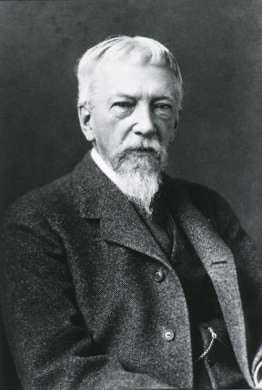 Founded by S. Weir Mitchell as a literary society, this little club hidden on Camac Street has been the center of Philadelphia's literary life for more than a century.
Founded by S. Weir Mitchell as a literary society, this little club hidden on Camac Street has been the center of Philadelphia's literary life for more than a century.
The Proprietorships of William Penn
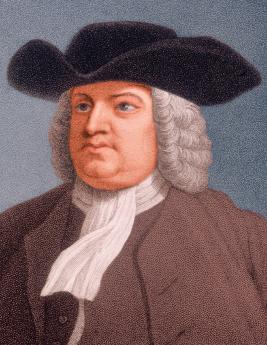 William Penn owned Pennsylvania, New Jersey, and Delaware; as the proprietor, he was the largest private American landowner, ever. Although the Revolutionary War mostly ended that, one of his proprietorships still owns all unclaimed land in southern New Jersey.
William Penn owned Pennsylvania, New Jersey, and Delaware; as the proprietor, he was the largest private American landowner, ever. Although the Revolutionary War mostly ended that, one of his proprietorships still owns all unclaimed land in southern New Jersey.
Victorian Broad Street
 Some massive beautiful Victorian buildings still dominate the City crossroads on Broad Street near City Hall.
Some massive beautiful Victorian buildings still dominate the City crossroads on Broad Street near City Hall.
Christ Church and Elfreths Alley
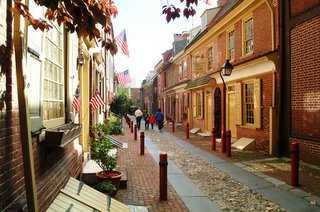 Two of our oldest and most charming tourist attractions are just across the street from each other.
Two of our oldest and most charming tourist attractions are just across the street from each other.
City Troop
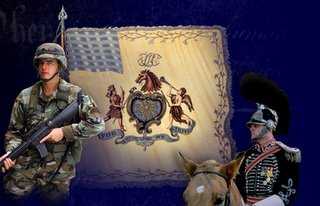 America.
America.
Henry George, Single Tax
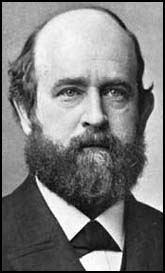 The Henry George idea of a single tax still lives on in a school run in his old house on Eleventh Street.
The Henry George idea of a single tax still lives on in a school run in his old house on Eleventh Street.
Secret Places
 Some rich people are ostentatious about where they live. In Philadelphia, they are more likely to go into hiding, but in special places.
Some rich people are ostentatious about where they live. In Philadelphia, they are more likely to go into hiding, but in special places.
Sugarloaf
 The Strouds of Stroudsburg used to live here at the top of the town. It's now a conference center.
The Strouds of Stroudsburg used to live here at the top of the town. It's now a conference center.
The Girl in the Red Velvet Swing
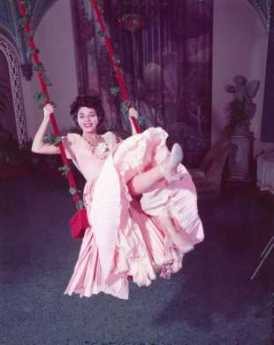 The original Gibson girl's husband was rich, her boyfriend was famous. But blowing somebody's brains out in public is supposed to be a felony.
The original Gibson girl's husband was rich, her boyfriend was famous. But blowing somebody's brains out in public is supposed to be a felony.
Carpenters Hall
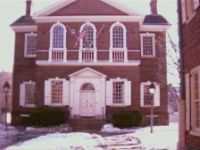 Carpenter's Hall now seems a little place, and it was chopped up into still smaller rooms at the time of the Continental CongressBut nevertheless it was the biggest rentable place in the largest town in the colonies, so 53 delegates crowded in and did their work.
Carpenter's Hall now seems a little place, and it was chopped up into still smaller rooms at the time of the Continental CongressBut nevertheless it was the biggest rentable place in the largest town in the colonies, so 53 delegates crowded in and did their work.
Musical Fund Hall
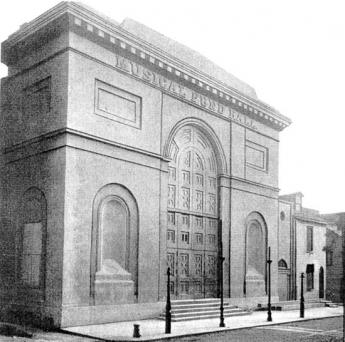
Alexander Hamilton, Celebrity
 He had the kind of taudry private life and flashy public behavior that Philadelphia will only tolerate in aristocrats, sometimes.
He had the kind of taudry private life and flashy public behavior that Philadelphia will only tolerate in aristocrats, sometimes.
Benjamin Franklin: Chronology
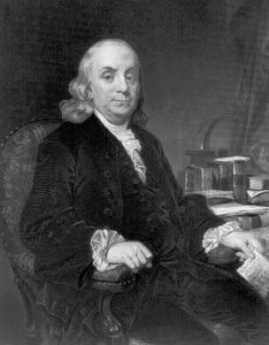 Franklin retired at age 42, and spent the other half of his life in public service. Only fifteen years of that career was spent in America. His timing was good, however; he was here for the French and Indian War, the Declaration of Independence, and the Constitutional Convention.
Franklin retired at age 42, and spent the other half of his life in public service. Only fifteen years of that career was spent in America. His timing was good, however; he was here for the French and Indian War, the Declaration of Independence, and the Constitutional Convention.
Bullseye Sociology
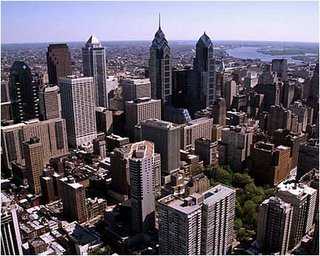 Philadelphia is stratifying into concentric rings, with prosperity alternating with decay. The challenge is to unify the rings of the bullseye.
Philadelphia is stratifying into concentric rings, with prosperity alternating with decay. The challenge is to unify the rings of the bullseye.
Washington Square
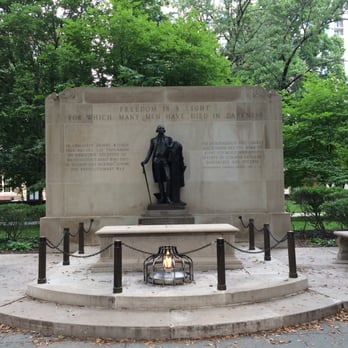 All five of William Penn's city squares have proud and colorful histories . Washington Square, however, tops them all. It's had prisons, fish ponds, cemeteries, mansions, and skyscrapers.
All five of William Penn's city squares have proud and colorful histories . Washington Square, however, tops them all. It's had prisons, fish ponds, cemeteries, mansions, and skyscrapers.
Azilum: French Asylum on the Susquehanna
The French Revolution and the slave revolt in Haiti created the need for a French-speaking refuge for fleeing aristocrats, and some francophile Philadelphians organized one, including a futile effort to rescue Marie Antoinette.
Spreading the City Out to Its Edges
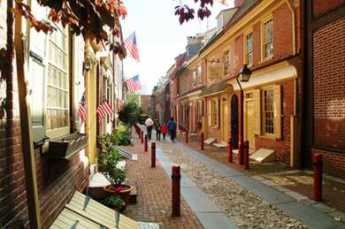 The early city of Philadelphia was too tightly compressed and thus generated slums. By contrast, areas today become slums by being abandoned. Is there a middle way between these extremes that don't produce slums?
The early city of Philadelphia was too tightly compressed and thus generated slums. By contrast, areas today become slums by being abandoned. Is there a middle way between these extremes that don't produce slums?
While the City Sleeps
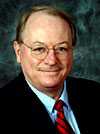 Sleep time is in direct competition with commute time. It shapes the city in unrecognized ways.
Sleep time is in direct competition with commute time. It shapes the city in unrecognized ways.
Jewelers Row
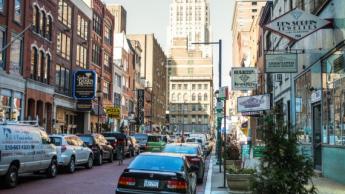 It makes an interesting study in the economics of marketing to visit the collection of dozens of jeweler shops all crowded into a couple of blocks.
It makes an interesting study in the economics of marketing to visit the collection of dozens of jeweler shops all crowded into a couple of blocks.
East Falls
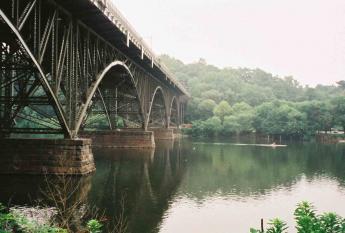 A cute little suburban remnant nestles close to the center of town, protected by the Schuylkill, the Wissahickon, and the shade of John B. Kelly. Perhaps Harry Robinhold deserves some credit, too.
A cute little suburban remnant nestles close to the center of town, protected by the Schuylkill, the Wissahickon, and the shade of John B. Kelly. Perhaps Harry Robinhold deserves some credit, too.
French Philadelphia
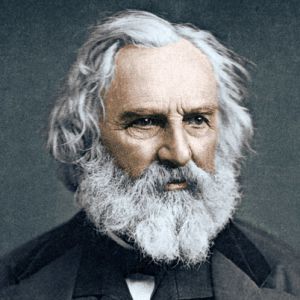 The French and the English fought for centuries; colonies seeking independence played one against the other. Our cooking, clothing, and architecture went French when we favored France; traces of many periods still reflect that fact.
The French and the English fought for centuries; colonies seeking independence played one against the other. Our cooking, clothing, and architecture went French when we favored France; traces of many periods still reflect that fact.
Rittenhouse Square Area
 This was the heart of uppercrust society during the Gilded Age.
This was the heart of uppercrust society during the Gilded Age.
Rail Station at Broad and Washington
Northwest Rittenhouse Square
 The fashionable district doesn't need so many mansions, and the Universities can't yet use the space, either. It's uncertain whether the area will become office buildings, or revert to townhouses.
The fashionable district doesn't need so many mansions, and the Universities can't yet use the space, either. It's uncertain whether the area will become office buildings, or revert to townhouses.
Larger Clubs
 No longer exclusively all-male (or, occasionally, all-female), the downtown club is changing its role but remains a social center of considerable importance.
No longer exclusively all-male (or, occasionally, all-female), the downtown club is changing its role but remains a social center of considerable importance.
Market at Schuylkill
 Where the Market Street bridge crosses the Schuylkill was once a busy city center, and it may become that again, someday. Right now, it's in decline.
Where the Market Street bridge crosses the Schuylkill was once a busy city center, and it may become that again, someday. Right now, it's in decline.
The Center of Town
 The designs of the city squares, that of City Hall, in particular, follow the "diamond" pattern characteristic of the Scotch Irish, who were keen real estate speculators.
The designs of the city squares, that of City Hall, in particular, follow the "diamond" pattern characteristic of the Scotch Irish, who were keen real estate speculators.
Ownership of the Port
 Industrial Philadelphia was built around port facilities and railroads. As East Coast shipping declined, city, state and federal governments combined to buy up the port facilities and keep them going. Is that commendable, or a futile waste of money?
Industrial Philadelphia was built around port facilities and railroads. As East Coast shipping declined, city, state and federal governments combined to buy up the port facilities and keep them going. Is that commendable, or a futile waste of money?
Market Street, East (1)
 It will be enough, for now, to consider only the oldest section of fourteen blocks from City Hall to the Delaware River
It will be enough, for now, to consider only the oldest section of fourteen blocks from City Hall to the Delaware River
Canada's Southern Seaport
 Railroading was once the heart of the Philadelphia industrial empire, and it's a little disheartening to see that Canada is taking us over. But historic ties to Canada are particularly strong here.
Railroading was once the heart of the Philadelphia industrial empire, and it's a little disheartening to see that Canada is taking us over. But historic ties to Canada are particularly strong here.
Chinese Canyons
 Philadelphia's little Chinatown is jammed between immovable objects. If immigration persists much more, something is going to have to move.
Philadelphia's little Chinatown is jammed between immovable objects. If immigration persists much more, something is going to have to move.
North of Market
 This old local expression originally pointed to where the Quakers live on Arch Street, but over the centuries has taken on a lot of less flattering associations.
This old local expression originally pointed to where the Quakers live on Arch Street, but over the centuries has taken on a lot of less flattering associations.
Armonica, Momentarily Mesmerizing
 The harmonica was a musical instrument invented by Ben Franklin, who else. Beethoven and Mozart wrote music for it. It made people sick and may even have killed someone.
The harmonica was a musical instrument invented by Ben Franklin, who else. Beethoven and Mozart wrote music for it. It made people sick and may even have killed someone.
Wall Art in Philadelphia
 Several thousand Philadelphia buildings now display outdoor paintings by local artists, encouraged and funded by the City government. In the summer, bus trips with guides tour around the town, explaining things.
Several thousand Philadelphia buildings now display outdoor paintings by local artists, encouraged and funded by the City government. In the summer, bus trips with guides tour around the town, explaining things.


